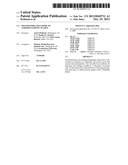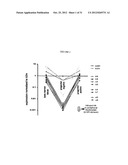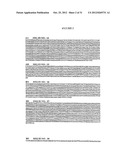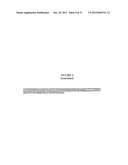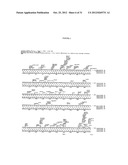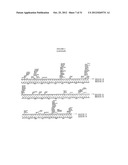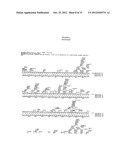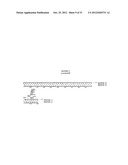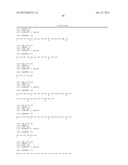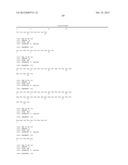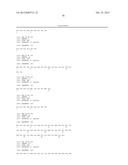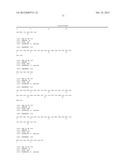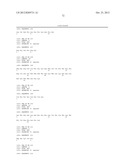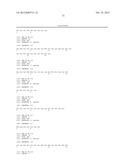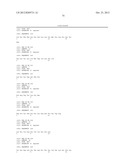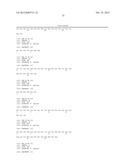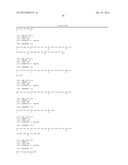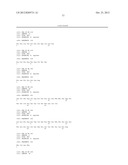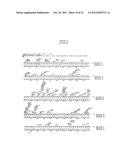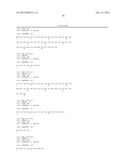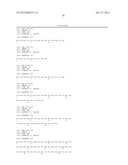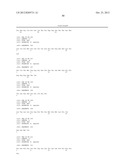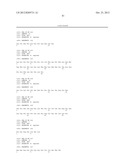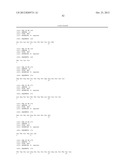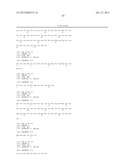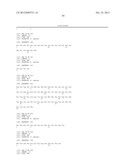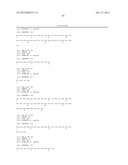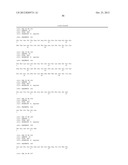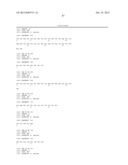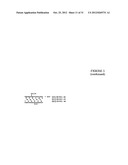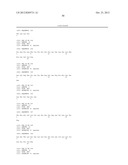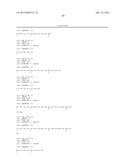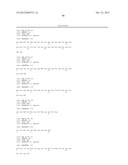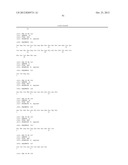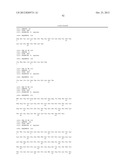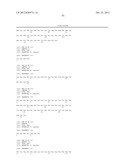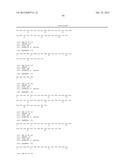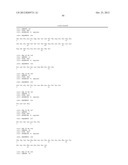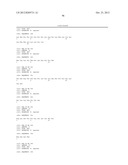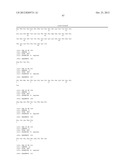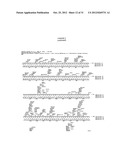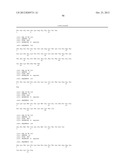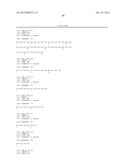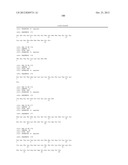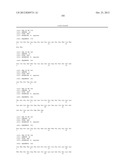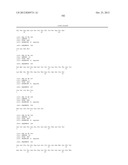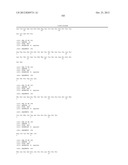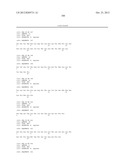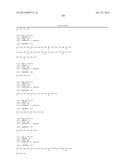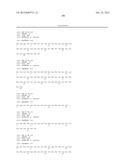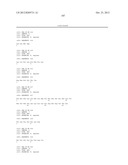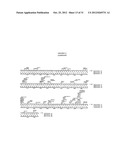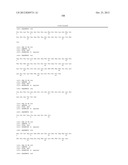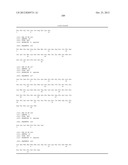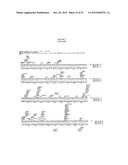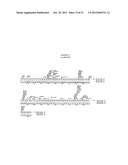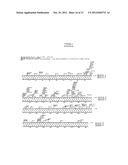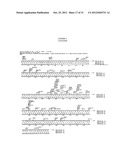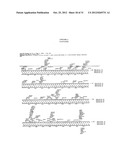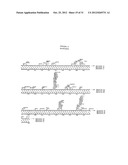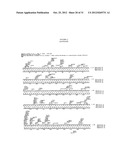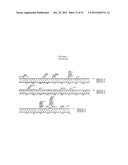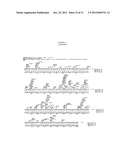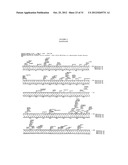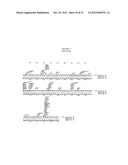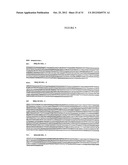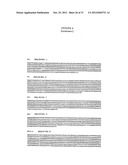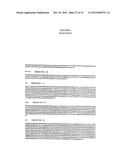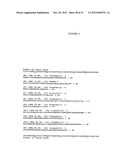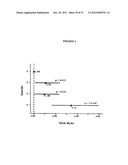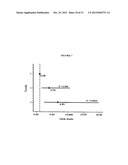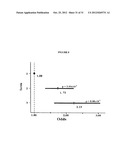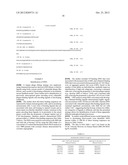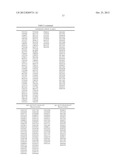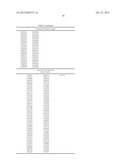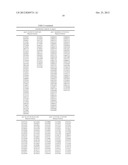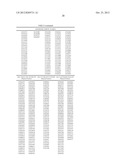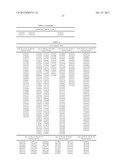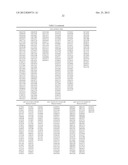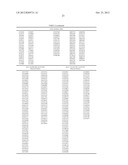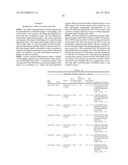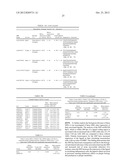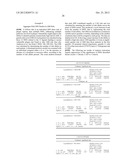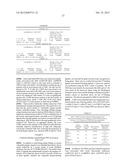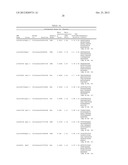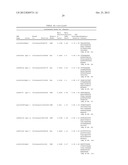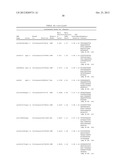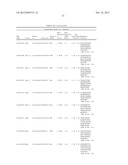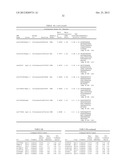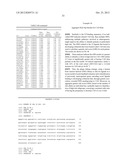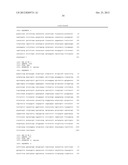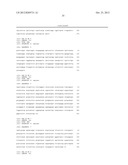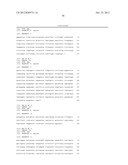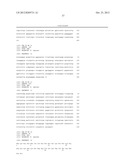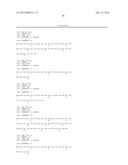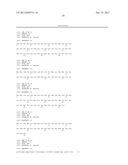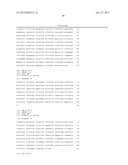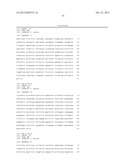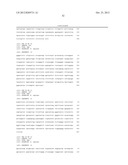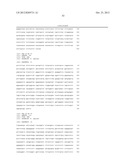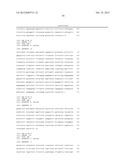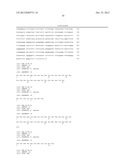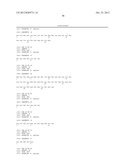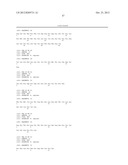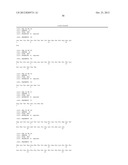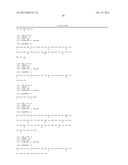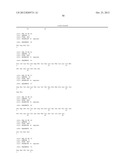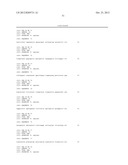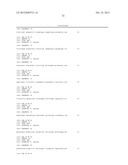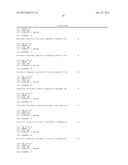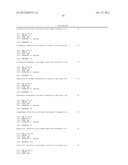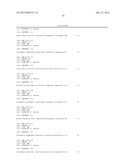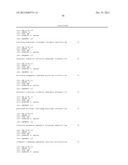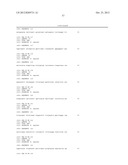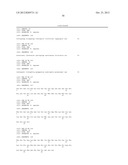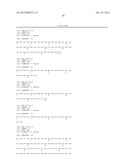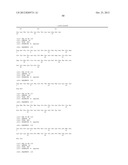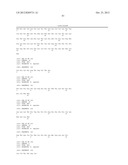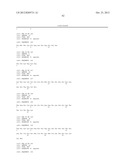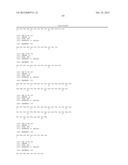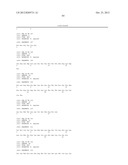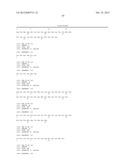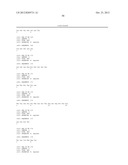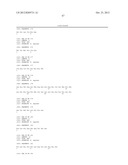Patent application title: POLYPEPTIDES THAT HOME TO ATHEROSCLEROTIC PLAQUE
Inventors:
Anton Wellstein (Washington, DC, US)
Stephen E. Epstein (Rockville, MD, US)
Mary Susan Burnett (Burke, VA, US)
Assignees:
Medstar Health Research Institute, Inc.
GEORGETOWN UNIVERSITY
IPC8 Class: AC07H2104FI
USPC Class:
424 91
Class name: Drug, bio-affecting and body treating compositions in vivo diagnosis or in vivo testing
Publication date: 2012-10-25
Patent application number: 20120269731
Abstract:
Described herein are homing polypeptides that home to atherosclerotic
plaque(s) in mammals and nucleic acids that encode such polypeptides.
Also described are methods for detecting and treating conditions or
disorders associated with, or characterized, by elevated levels of homing
polypeptides that home to atherosclerotic plaque and/or vulnerable
plaque.Claims:
1-57. (canceled)
58. An isolated homing polypeptide that homes to an atherosclerotic plaque, encoded by a polynucleotide that comprises a sequence selected from the group consisting of: SEQ ID NO 24; SEQ ID NO 25; SEQ ID NO 26; SEQ ID NO 27; SEQ ID NO 28; SEQ ID NO 29; SEQ ID NO 30; SEQ ID NO 31; SEQ ID NO 32; SEQ ID NO 33; SEQ ID NO 34, SEQ ID NO 35; SEQ ID NO 36; SEQ ID NO 37, and a sequence that, due to the degeneracy of the genetic code, encodes a polypeptide encoded by any one of SEQ ID NOs: 24-37, complements thereof and nucleic acids that hybridize under stringent conditions to the polynucleotide.
59. The homing polypeptide of claim 58, wherein the homing polypeptide homes to atherosclerotic plaque that is vulnerable plaque.
60. The homing polypeptide of claim 59, wherein the polypeptide is attached to a delivery agent.
61. A polynucleotide encoding a homing polypeptide, wherein the polynucleotide comprises a sequence selected from the group consisting of: SEQ ID NO 24; SEQ ID NO 25; SEQ ID NO 26; SEQ ID NO 27; SEQ ID NO 28; SEQ ID NO 29; SEQ ID NO 30; SEQ ID NO 31; SEQ ID NO 32; SEQ ID NO 33; SEQ ID NO 34, SEQ ID NO 35; SEQ ID NO 36; SEQ ID NO 37, and a sequence that, due to the degeneracy of the genetic code, encodes a polypeptide encoded by any one of SEQ ID NOs 24-37, complements thereof and nucleic acids that hybridize under stringent conditions to the polynucleotide.
62. An antibody, or a fragment thereof, that binds the homing polypeptide of claim 58.
63. A method of determining the risk that an individual will develop a condition or disorder associated with, or characterized by, the presence of an altered level of at least one homing polypeptide to an atherosclerotic plaque in an individual, the method comprising determining the presence of an altered level of at least one homing polypeptide to an atherosclerotic plaque, or at least one polynucleotide encoding a homing polypeptide to an atherosclerotic plaque, in a sample from the individual, wherein the presence of an altered level of at least one homing polypeptide to an atherosclerotic plaque or at least one polynucleotide encoding a homing polypeptide to an atherosclerotic plaque, indicates an increased risk of a condition or disorder associated with, or characterized by, the presence of altered levels of at least one homing polypeptide to an atherosclerotic plaque, and wherein the at least one homing polypeptide to an atherosclerotic plaque is encoded by a polynucleotide of claim 61.
64. The method of claim 63, wherein the condition or disorder associated with, or characterized by, a homing polypeptide to an atherosclerotic plaque is a cardiovascular condition, ischemia, myocardial infarction, stroke, acute coronary syndrome, cancer or a metabolic disorder.
65. The homing polypeptide of claim 58, wherein the homing polypeptide is coupled to a therapeutic moiety or an imaging molecule.
66. The homing polypeptide of claim 65, wherein the therapeutic moiety is selected from the group consisting of ricin, a radioisotope, a clotting agent, a thrombolytic factor, a chemotherapeutic agent, a radiosensitizing agent, an anti-angiogenesis agent, an anti-motility agent, an anti-lipid agent, a statin, high density lipoprotein, a peptide with the functionality of a high density lipoprotein, and an immunomodulatory agent and the imaging molecule is selected from the group consisting of a radiologic, a radioisotope, a dye, a pigment, a luciferase, fluorescein, a fluorescent molecule, an MRI imaging agent, and an agent that can be imaged by computerized tomography (CT).
67. A method of targeting a therapeutic moiety or an imaging agent to an atherosclerotic plaque in an individual in need thereof, the method comprising administering to the individual in need thereof an effective amount of a composition comprising: (a) an isolated homing polypeptide of claim 58; and (b) a therapeutic moiety or an imaging molecule, wherein the therapeutic moiety or the imaging molecule is coupled to the homing polypeptide, whereby the therapeutic moiety or the imaging molecule is targeted to the atherosclerotic plaque.
68. A method of determining the risk of a cardiovascular condition in an individual, the method comprising: (a) obtaining biological sample from the individual; and (b) assessing the biological sample for the presence of at least one SNP selected from the group consisting of a SNP shown in Table 1 and a SNP shown in Table 2, wherein the presence of the at least one SNP in the biological sample indicates that the individual is at increased risk of a cardiovascular condition.
69. A method of determining whether an individual is at increased risk of Acute Myocardial Infarction (AMI), the method comprising: (a) obtaining a biological sample from the individual; and (b) assessing the biological sample for the presence of at least one SNP selected from the group consisting of the SNPs shown in Table 3, wherein the presence of the at least one SNP in the biological sample indicates that the individual has an increased risk of AMI, and wherein the greater the number of SNPs in the biological sample, the greater the risk of AMI in the individual.
70. The method of claim 69, wherein in (b) the biological sample is assessed for the presence of at least one SNP selected from the group consisting of: rs6982320 8p22, rs2830538 21q21.3 and rs463433 21q21.3, wherein the presence of the at least one SNP indicates that the individual is at risk of AMI, and wherein the greater the number of SNPs in the biological sample, the greater the risk of AMI in the individual.
71. A method of determining an increased risk of Coronary Artery Disease (CAD) in an individual, the method comprising: (a) obtaining a biological sample from the individual; and (b) determining the presence in the biological sample of at least one SNP selected from the group consisting of the SNPs shown in Table 6, wherein the presence of the at least one SNP indicates that the individual has an increased risk of CAD, and wherein the greater number of SNPs in the biological sample, the greater the risk of CAD in the individual.
72. The method of claim 71, wherein in (b) the biological sample is assessed for the presence of at least one SNP selected from the group consisting of: rs10757493 9p21.3, rs988179 2p16.3, rs309137 2q21.3, rs17588757 9p23, and rs12475139 2q21.3, wherein the presence of the at least one SNP indicates that the individual has an increased risk of CAD, and wherein the greater the number of SNPs in the biological sample, the greater the risk of CAD in the individual.
73. A method of assessing risk for coronary artery disease (CAD) in an individual, comprising: (a) developing a genetic risk score (GRS) for the individual; and (b) comparing the genetic risk score for the individual with an appropriate reference, wherein the genetic risk score is developed in (a) by determining the number of risk alleles the individual has and wherein the appropriate reference is a reference genetic risk score.
74. The method of 73, wherein the number of risk alleles the individual has is determined by assessing a sample obtained from the individual for at least one SNP associated with acute CAD or myocardial infarction; at least one SNP associated with stable CAD; or at least one SNP associated with acute CAD or myocardial infarction and at least one SNP associated with stable CAD.
75. The method of claim 74, wherein the at least one SNP is selected from the group consisting of: rs6982320 8p22; rs2830538 21q21.3; rs463433 21821.3; rs10812143 9p21.3; rs12005015 9p23; rs7025783 9p21.3; rs7639226 3p12.3; rs10757493 9p21.3; rs988179 2p16.3; rs309137 2q21.31rs17588757 9p23; rs12475139 2q21.3.
76. A composition comprising: (a) one or more homing polypeptides of claim 59 or a portion thereof; (b) a therapeutic moiety; and (c) a pharmaceutically acceptable carrier.
77. The polynucleotide of claim 61, which encodes a homing polypeptide, wherein the polynucleotide comprises a sequence selected from the group consisting of: SEQ ID NO. 24 and a sequence that, due to the degeneracy of the genetic code, encodes a polypeptide encoded by SEQ ID NO 24, complements thereof and nucleic acids that hybridize under stringent conditions to the polynucleotide.
Description:
RELATED APPLICATIONS
[0001] This application claims the benefit of the filing date of U.S. Provisional application 61/278,775, entitled POLYPEPTIDES THAT HOME TO ATHEROSCLEROTIC PLAQUE, filed Oct. 9, 2009, the entire teachings of which are incorporated by reference herein.
GOVERNMENT FUNDING
[0002] Not Applicable
BACKGROUND OF THE INVENTION
[0003] Acute coronary syndromes (ACS), characterized by either acute myocardial infarction (MI) or unstable angina, are most commonly precipitated by plaque rupture, which accounts for about 60-75% of fatal acute myocardial infarctions and/or sudden coronary deaths. The ruptured atherosclerotic plaques occur on a background of underlying atherosclerotic disease. Alarmingly, in patients presenting ACS, the recurrent cardiovascular event rate is high over the next two years, even with good medical management. The one year incidence of cardiovascular death, nonfatal MI, readmission for ACS and stroke is 8-12% during one year follow-up and 11-14% during two years follow-up.
[0004] This high rate of recurrent cardiovascular events, despite aggressive therapy, may be due to the now commonly held belief that ACS has a systemic inflammatory component, one manifestation of which is that many ACS patients have several vulnerable plaques in addition to the ruptured culprit lesion responsible for precipitating the ACS. The risk of rupture over the succeeding months posed by these additional vulnerable plaques accounts, in large part, for the high recurrence rate of cardiovascular events. While atherosclerotic plaques can be severe enough so that they compromise flow and therefore result in warning symptoms, they may be mild and not cause any warning symptoms. However, atherosclerotic plaques might still rupture and produce catastrophic clinical consequences.
[0005] Plaque rupture also plays an important role in stroke with the culprit lesions in these patients lying usually in the carotid artery.
SUMMARY OF THE INVENTION
[0006] Described herein are homing polypeptides that home to atherosclerotic plaques, homing polypeptides that home to vulnerable plaques, and nucleic acids that encode such polypeptides. Such homing polypeptides are referred to herein, respectively, as atherosclerotic-plaque-homing polypeptides, which are also referred to as atherosclerotic-lesion-homing polypeptides, and homing polypeptides that home to vulnerable plaque (vulnerable plaque-homing polypeptides). Also described are methods for detecting and treating conditions or disorders associated with or characterized by altered levels of homing polypeptides that home to atherosclerotic plaque and/or vulnerable plaque.
[0007] In one aspect the work described herein relates to atherosclerotic-plaque-homing polypeptides and nucleic acids encoding atherosclerotic-plaque-homing polypeptides that are useful, for example, for diagnostic and therapeutic purposes, particularly diagnosis and therapy of individuals in whom atherosclerotic plaques are developing or have developed, such as atherosclerotic plaque associated with vulnerable plaque, as well as for purposes of predicting or aiding in predicting the likelihood or risk that an individual will develop atherosclerotic plaque and/or vulnerable plaque. Such homing polypeptides and nucleic acids that encode such homing polypeptides are also useful for diagnosis and therapy of individuals in whom plaque rupture or acute ischemia has occurred and individuals who are at risk of ischemia or plaque rupture, which can lead to undesirable cardiovascular events, such as acute coronary syndrome or stroke. The work described herein further relates to atherosclerotic-plaque-homing polypeptides and nucleic acids encoding atherosclerotic-plaque-homing polypeptides, both of which are useful for predicting or aiding in predicting the likelihood or risk that an individual will develop plaque rupture (will experience rupture of vulnerable plaque) or acute ischemia. The atherosclerotic-plaque-homing polypeptides and nucleic acids encoding them are useful for diagnosis and therapy of atherosclerotic plaques, vulnerable plaque endothelia, developing and ruptured vulnerable plaque, and acutely ischemic myocardium.
[0008] Further described herein are uses of atherosclerotic-plaque-homing polypeptides, such as in methods of diagnosing or aiding in diagnosis of atherosclerotic plaque and vulnerable plaque, methods of predicting the likelihood that atherosclerotic plaque will develop in an individual; methods of diagnosing or aiding in the diagnosis of development of vulnerable plaque in an individual; methods of predicting or aiding in predicting the likelihood that an individual will experience disruptions of vulnerable plaque, including atheromatous plaque; methods of predicting or aiding in predicting the risk an individual will experience acute coronary syndrome; methods of predicting survival or aiding in predicting survival of an individual in whom vulnerable plaque, including atheromatous plaque, has developed; predicting or aiding in predicting how long it will be until an individual with vulnerable plaque will experience plaque rupture; methods of assessing the effectiveness of therapy; and methods of assessing the stage or progression of (atheromatous) plaque vulnerability (e.g., fragility) in an individual.
[0009] Also described herein is the use of atherosclerotic-plaque-homing polypeptides and vulnerable-plaque-homing polypeptides and the encoding polynucleotides for delivering agents, such as prophylactic or therapeutic drugs and detection or imaging agents, to atherosclerotic plaque and vulnerable plaque particularly; compositions, such as pharmaceutical compositions and compositions useful for detection and/or imaging of atherosclerotic plaques and vulnerable plaques, which comprise an (at least one, one or more) atherosclerotic-plaque-homing polypeptide or fragment thereof or a (at least one, one or more) polynucleotide that encodes an atherosclerotic-plaque-homing polypeptide and/or antibodies that bind atherosclerotic-plaque-homing polypeptide gene products or portions thereof, such as antibodies that bind homing domains of atherosclerotic plaques homing polypeptides.
[0010] Specific embodiments relate to atherosclerotic-plaque-homing polypeptides, including polypeptide fragments that are homing domains, encoded by nucleic acids whose sequences are presented herein or fragments thereof; methods in which one or more of the atherosclerotic plaque homing polypeptides or fragments thereof are used; methods in which one or more of the nucleic acids encoding atherosclerotic-plaques-homing-polypeptide is used; compositions comprising one or more of the atherosclerotic-plaque-horning-polypeptide-encoding polynucleotides or a portion(s) thereof; compositions comprising (a) an atherosclerotic-lesion-homing polypeptide and (b) an agent to be targeted to atherosclerotic plaque and/or vulnerable plaque in an individual; and antibodies that bind (recognize) products (proteins, polypeptides) that are encoded by DNA whose sequences is provided herein or portions of any of the DNA.
[0011] The disclosure also encompasses SNPs (single nucleotide polymorphisms) in genes related to atherosclerotic-lesion-homing polypeptides, and methods for evaluating the risk or likelihood that an individual will develop a cardiovascular event, such as acute myocardial infarction (AMI) by determining if one or more of these SNPs are present.
[0012] The disclosure also encompasses SNPs (single nucleotide polymorphisms) in genes related to developing microvessel homing polypeptides, and methods for evaluating the risk or likelihood that an individual will develop a cardiovascular event, such as coronary artery disease, by determining if one or more of these SNPs are present.
[0013] In one aspect the disclosure provides an isolated homing polypeptide that homes to an atherosclerotic plaque and is encoded by a polynucleotide, wherein the polynucleotide comprises a sequence selected from the group consisting of: SEQ ID NO 24; SEQ ID NO 25; SEQ ID NO 26; SEQ ID NO 27; SEQ ID NO 28; SEQ ID NO 29; SEQ ID NO 30; SEQ ID NO 31; SEQ ID NO 32; SEQ ID NO 33; SEQ ID NO 34, SEQ ID NO 35; SEQ ID NO 36; SEQ ID NO 37, and a sequence that, due to the degeneracy of the genetic code, encodes the same polypeptide as a polypeptide encoded by any one of SEQ ID NO: 38-70 and SEQ ID NO: 127-137. In some embodiments, the atherosclerotic plaque is a vulnerable plaque. In some embodiments, the polypeptide is attached to a delivery agent. In some embodiments the delivery agent is a biodegradable delivery agent. In some embodiments, the polypeptide comprises the amino acid sequence of any one of: SEQ ID NO: 38-70 and SEQ ID NO: 127-137 or a fragment of any one of SEQ ID NO: 38-70 and SEQ ID NO: 127-137. In some embodiments, the polypeptide homes specifically to atherosclerotic plaque (preferentially to atherosclerotic-plaque than to microvessels). In some embodiments, the polypeptide homes specifically to microvessels in the atherosclerotic plaque (preferentially to microvessels than to atherosclerotic-plaque). In some embodiments, the polypeptide homes specifically to vulnerable plaque. In some embodiments, the polypeptide also homes to developing microvessels.
[0014] In one aspect the disclosure provides a polynucleotide encoding a homing polypeptide wherein the polynucleotide comprises a sequence selected from the group consisting of: SEQ ID NO 24; SEQ ID NO 25; SEQ ID NO 26; SEQ ID NO 27; SEQ ID NO 28; SEQ ID NO 29; SEQ ID NO 30; SEQ ID NO 31; SEQ ID NO 32; SEQ ID NO 33; SEQ ID NO 34, SEQ ID NO 35; SEQ ID NO 36; SEQ ID NO 37, and a sequence that, due to the degeneracy of the genetic code, encodes the same polypeptide as a polypeptide encoded by any one of SEQ ID NOs 24-37, complements thereof and nucleic acids that hybridize under stringent conditions to the polynucleotides.
[0015] In one aspect the disclosure provides an antibody, or a fragment thereof, that binds the homing polypeptides described herein.
[0016] In one aspect the disclosure provides an antibody, or a fragment thereof, that binds a homing polypeptide, wherein the polypeptide comprises a sequence selected from the group consisting of: SEQ ID NO: 38-70 and SEQ ID NO: 127-137.
[0017] In one aspect the disclosure provides an antibody, or a fragment thereof, that binds a homing polypeptide encoded by a polynucleotide, wherein the polynucleotide comprises a sequence selected from the group consisting of: SEQ ID NO 24; SEQ ID NO 25; SEQ ID NO 26; SEQ ID NO 27; SEQ ID NO 28; SEQ ID NO 29; SEQ ID NO 30; SEQ ID NO 31; SEQ ID NO 32; SEQ ID NO 33; SEQ ID NO 34, SEQ ID NO 35; SEQ ID NO 36; SEQ ID NO 37, and a sequence that, due to the degeneracy of the genetic code, encodes the same polypeptide as a polypeptide encoded by any one of SEQ ID NOs 24-37.
[0018] Antibodies described herein can be a monoclonal antibody, a polyclonal antibody, a chimeric antibody, a bispecific antibody, a heteroconjugate antibody, or a single chain (ScFv) antibody. In some embodiments the antibody is coupled to a therapeutic moiety. In some embodiments the therapeutic moiety is selected from the group consisting of ricin, a radioisotope, a clotting agent, a thrombolytic factor, a chemotherapeutic agent, a radiosensitizing agent, an anti-angiogenesis agent, an anti-motility agent, an anti-lipid agent, a statin, high density lipoprotein, a peptide with the functionality of a high density lipoprotein, and an immunomodulatory agent.
[0019] In some embodiments of the antibodies described herein, the antibody is coupled to a radiologic or other imaging molecule. In some embodiments, the radiologic or other imaging molecule is selected from the group consisting of a radioisotope, a dye, a pigment, a luciferase, fluorescein, a fluorescent molecule an MRI imaging agent, and an agent that can be imagined by computerized tomography (CT).
[0020] In one aspect the disclosure provides a method of determining the risk of a condition or disorder associated with, or characterized by, the presence of an altered (elevated or reduced) level of at least one atherosclerotic-plaque homing polypeptide in an individual, wherein the method comprises determining the presence of an altered (elevated or reduced) levels of at least one atherosclerotic-plaque-homing polypeptide or at least one polynucleotide encoding an atherosclerotic-plaque-homing polypeptide in a sample from an individual, wherein the presence of an elevated or reduced level of at least one homing polypeptide to an atherosclerotic plaque or at least one polynucleotide encoding a homing polypeptide to an atherosclerotic plaque, indicates an increased risk of a condition or disorder associated with, or characterized by, the presence of altered (elevated or reduced) levels of at least one atherosclerotic-plaque-homing polypeptide and wherein the at least one homing polypeptide to an atherosclerotic plaque is selected from the group consisting of: SEQ ID NO: 38-70 and SEQ ID NO: 127-137. As used herein the altered (elevated or reduced) level refers to an alteration compared to an individual who does not have atherosclerotic plaque or who is not at risk of a disorder associated with an atherosclerotic plaque.
[0021] In some embodiments of the methods described herein, the homing polypeptide to an atherosclerotic plaque is encoded by nucleic acid comprising a sequence selected from the group consisting of: SEQ ID NO 24; SEQ ID NO 25; SEQ ID NO 26; SEQ ID NO 27; SEQ ID NO 28; SEQ ID NO 29; SEQ ID NO 30; SEQ ID NO 31; SEQ ID NO 32; SEQ ID NO 33; SEQ ID NO 34, SEQ ID NO 35; SEQ ID NO 36; SEQ ID NO 37, and a sequence that, due to the degeneracy of the genetic code, encode the same polypeptide as a polypeptide encoded by one of the other members of the group.
[0022] In some embodiments of the methods described herein the determination of the presence of an altered level of at least one homing polypeptide that homes to an atherosclerotic plaque or at least one polynucleotide encoding a homing polypeptide that homes to an atherosclerotic plaque comprises using PCR analysis, RT-PCR, Northern analysis, DNA microarrays, isotope coded affinity tag reagents, MALDI TOF/TOF tandem mass spectrometry, 2D-gel/mass spectrometry technologies or ELISA.
[0023] In some embodiments of the methods described herein, the sample is a biological sample, such as a blood sample, a biopsy sample, a pathology sample, a urine sample or a cerebrospinal fluid sample. In some embodiments of the methods described herein, the condition or disorder associated with, or characterized by, a homing polypeptide to an atherosclerotic plaque is a cardiovascular condition, ischemia, myocardial infarction, stroke, acute coronary syndrome, cancer or a metabolic disorder.
[0024] In some embodiments of the homing polypeptides described herein the homing polypeptide is coupled to a therapeutic moiety. In some embodiments the therapeutic moiety is selected from the group consisting of ricin, a radioisotope, a clotting agent, a thrombolytic factor, a chemotherapeutic agent, a radiosensitizing agent, an anti-angiogenesis agent, an anti-motility agent, an anti-lipid agent, a statin, high density lipoprotein, a peptide with the functionality of a high density lipoprotein, and an immunomodulatory agent. In some embodiments the homing polypeptide is coupled to an imaging molecule. In some embodiments the imaging molecule is selected from the group consisting of a radiologic, a radioisotope, a dye, a pigment, a luciferase, fluorescein, a fluorescent molecule, an MRI imaging agent, and an agent that can be imaged by computerized tomography (CT).
[0025] In one aspect the disclosure provides a method of targeting an agent to an atherosclerotic plaque in an individual, wherein the method comprises administering to the individual in need thereof an effective amount of a composition comprising the homing polypeptides described herein coupled to the agent to be targeted to the atherosclerotic plaque, wherein the agent is a therapeutic moiety or an imaging molecule, and whereby the agent is targeted to the atherosclerotic plaque. In some embodiments the atherosclerotic plaque is a vulnerable plaque.
[0026] In one aspect the disclosure provides a method of treating a condition or disorder associated with, or characterized by, the presence of an elevated level of at least one homing polypeptide to an atherosclerotic plaque in an individual in need thereof, wherein the method comprises administering to the individual in need of such treatment a homing polypeptide that homes to an atherosclerotic plaque in an amount effective to treat the condition or disorder, wherein the homing polypeptide is coupled to a therapeutic moiety, wherein the at least one homing polypeptide that homes to an atherosclerotic plaque comprises a sequence selected from the group consisting of: SEQ ID NO: 38-70 and SEQ ID NO: 127-137.
[0027] In some embodiments of the methods described herein, the at least one homing polypeptide is encoded by a nucleic acid comprising a sequence selected from the group consisting of: SEQ ID NO 24; SEQ ID NO 25; SEQ ID NO 26; SEQ ID NO 27; SEQ ID NO 28; SEQ ID NO 29; SEQ ID NO 30; SEQ ID NO 31; SEQ ID NO 32; SEQ ID NO 33; SEQ ID NO 34, SEQ ID NO 35; SEQ ID NO 36; SEQ ID NO 37, and a sequence that, due to the degeneracy of the genetic code, encode the same polypeptide as a polypeptide encoded by one of the other members of the group. In some embodiments the therapeutic moiety is selected from the group consisting of ricin, a radioisotope, a clotting agent, a thrombolytic factor, a chemotherapeutic agent, a radiosensitizing agent, an anti-angiogenesis agent, an anti-motility agent, a statin, high density lipoprotein, a peptide with the functionality of a high density lipoprotein, and an immunomodulatory agent. In some embodiments the atherosclerotic plaque is a vulnerable plaque.
[0028] In one aspect the disclosure provides a pharmaceutical composition comprising (a) one or more homing polypeptides described herein, a portion of one or more homing polypeptides described herein; or a combination of one or more homing polypeptide described herein and a portion of one or more homing polypeptides described herein; (b) a therapeutic moiety, and (c) a pharmaceutically acceptable carrier.
[0029] In one aspect the disclosure provides a pharmaceutical composition comprising (a) one or more homing polypeptides described herein, a portion of one or more homing polypeptides described herein; or a combination of one or more homing polypeptide described herein and a portion of one or more homing polypeptides described herein; (b) one or more homing polypeptides of SEQ ID Nos. 14-23, a portion of one or more homing polypeptides of SEQ ID NOS. 14-23, or a combination of one or more homing polypeptides of SEQ ID NOS. 14-23 and a portion of one or more homing polypeptides of SEQ ID NOS. 14-23; (c) a therapeutic moiety and (d) a pharmaceutically acceptable carrier. In some embodiments the therapeutic moiety suppresses vulnerable plaque development.
[0030] In one aspect the disclosure provides a pharmaceutical composition comprising (a) one or more homing polypeptides described herein, a portion of one or more homing polypeptides described herein; or a combination of one or more homing polypeptide described herein and a portion of one or more homing polypeptides described herein; and (b) a pharmaceutically acceptable carrier.
[0031] In one aspect the disclosure provides a pharmaceutical composition comprising (a) one or more homing polypeptides described herein, a portion of one or more homing polypeptides described herein; or a combination of one or more homing polypeptide described herein and a portion of one or more homing polypeptides described herein; (b) one or more homing polypeptides of SEQ ID Nos. 14-23, a portion of one or more homing polypeptides of SEQ ID NOS. 14-23, or a combination of one or more homing polypeptides of SEQ ID NOS. 14-23 and a portion of one or more homing polypeptides of SEQ ID NOS. 14-23, each coupled to a therapeutic moiety or an imaging molecule, and (c) a pharmaceutically acceptable carrier.
[0032] In one aspect the disclosure provides a kit comprising one or more homing polypeptides described herein or portions thereof. In one aspect the disclosure provides a kit comprising one or more polynucleotides described herein, or at least one fragment thereof. In one aspect the disclosure provides a kit comprising one or more antibodies described herein or fragments thereof.
[0033] In one aspect the invention provides a method of determining the risk of a cardiovascular condition in an individual, the method comprising determining the presence of at least one SNP selected from the group consisting of a SNP shown in Table 1 and a SNP shown in Table 2.
[0034] In some embodiments the individual has a metabolic disorder or has one or more recognized risk factor of atherosclerosis.
[0035] In one aspect the invention provides a method of determining whether an individual is at increased risk of Acute Myocardial Infarction (AMI), the method comprising:
[0036] (a) obtaining a biological sample from the individual; and
[0037] (b) assessing the biological sample for the presence of at least one SNP selected from the group consisting of the SNPs shown in Table 3, wherein the presence of the at least one SNP indicates that the individual has an increased risk of AMI.
[0038] In one aspect the invention provides a method of determining whether an individual is at increased risk of Acute Myocardial Infarction (AMI), the method comprising:
[0039] (a) obtaining a biological sample from the individual; and
[0040] (b) assessing the biological sample for SNPs selected from the group consisting of the SNPs shown in Table 3, [0041] wherein the greater the number of SNPs in the biological sample, the greater the risk of AMI in the individual.
[0042] In one aspect the invention provides a method of determining whether an individual is at increased risk of Acute Myocardial Infarction (AMI), the method comprising:
[0043] (a) obtaining a biological sample from the individual; and
[0044] (b) determining the presence in the biological sample of at least one SNP selected from the group consisting of rs6982320 8p22, rs2830538 21q21.3 and rs463433 21q21.3
[0045] wherein the presence of the at least one SNP indicates that the individual is at risk of AMI.
[0046] In one aspect the invention provides a method of determining whether an individual is at increased risk of Acute Myocardial Infarction (AMI), the method comprising:
[0047] (a) obtaining a biological sample from the individual; and
[0048] (b) assessing the biological sample for SNPs selected from the group consisting rs6982320 8p22, rs2830538 21q21.3 and rs463433 21q21.3,
[0049] wherein the greater the number of SNPs in the biological sample, the greater the risk of AMI in the individual.
[0050] In one aspect the invention provides a method of determining an increased risk of Acute Myocardial Infarction (AMI) in an individual, the method comprising:
[0051] (a) obtaining a biological sample from the individual; and
[0052] (b) determining the presence in the biological sample of SNP rs6982320 8p22,
[0053] wherein the presence of the SNP indicates that the individual has an increased risk of AMI.
[0054] In one aspect the invention provides a method of determining an increased risk of Acute Myocardial Infarction (AMI) in an individual, the method comprising:
[0055] (a) obtaining a biological sample from the individual; and
[0056] (b) determining the presence in the biological sample of two alleles of SNP rs6982320 8p22,
[0057] wherein the presence of the alleles of the SNP indicates that the individual has an increased risk of AMI.
[0058] In one aspect the invention provides a method for determining an increased risk of Coronary Artery Disease (CAD) in an individual, the method comprising:
[0059] (a) obtaining a biological sample from the individual; and
[0060] (b) determining the presence in the biological sample of at least one SNP selected from the group consisting of the SNPs shown in Table 6
[0061] wherein the presence of the at least one SNP indicates that the individual has an increased risk of CAD.
[0062] In one aspect the invention provides a method of determining whether an individual is at increased risk of Coronary Artery Disease (CAD), the method comprising:
[0063] (a) obtaining a biological sample from the individual; and
[0064] (b) assessing the biological sample for SNPs selected from the group consisting of the SNPs shown in Table 6,
[0065] wherein the greater the number of SNPs in the biological sample, the greater the risk of CAD in the individual.
[0066] In one aspect the invention provides a method for determining an increased risk of Coronary Artery Disease (CAD) in an individual, the method comprising:
[0067] (a) obtaining a biological sample from the individual; and
[0068] (b) determining the presence in the biological sample of at least one SNP selected from the group consisting of rs10757493 9p21.3, rs988179 2p16.3, rs309137 2q21.3, rs17588757 9p23, and rs12475139 2q21.3,
[0069] wherein the presence of the at least one SNP indicates that the individual has an increased risk of CAD.
[0070] In one aspect the invention provides a method of determining whether an individual is at increased risk of Coronary Artery Disease (CAD), the method comprising:
[0071] (a) obtaining a biological sample from the individual; and
[0072] (b) assessing the biological sample for SNPs selected from the group consisting of rs10757493 9p21.3, rs988179 2p16.3, rs309137 2q21.3, rs17588757 9p23, and rs12475139 2q21.3,
[0073] wherein the greater the number of SNPs in the biological sample, the greater the risk of CAD in the individual.
[0074] Also described herein is a Genetic Risk Score (GRS) useful for estimating risk of AMI, including identifying individuals at high risk for AMI. The GRS was developed using the SNPs related to the ligands described herein and found to alter AMI risk and calculated for each patient. It was calculated by determining the number of risk alleles a patient had. An additive genetic model was assumed and weightings of 0, 1 or 2 were assigned, according to the number of risk alleles a patient had. The count method assumed that each SNP contributed equally to CAD risk and was calculated by summing the number of risk alleles across the panel of SNPs tested. This resulted in a score of 0 to twice the number of SNPs (representing the total number of risk alleles). The GRS was modeled as a continuous variable or as quartiles and tertiles, depending on the number of patients who could be assigned to each group. The GRS can be calculated using a variety of numbers of SNPs, such as three SNPs, (e.g., rs6982320 8p22; rs2830538 21q21.3; rs463433 21q21.3) or any combination of the SNPs shown in Table 3 and including any combination of the following: rs10812143 9p21.3; rs12005015 9p23; rs7025783 9p21.3; rs7639226 3p12.3; rs10757493 9p21.3; rs988179 2p16.3; rs309137 2q21.31rs17588757 9p23; rs12475139 2q21.3 or any additional SNP shown herein to be significantly associated with a greater risk of AMI.
[0075] Any number of SNPs (one or more, one) related to CAD, such as those described herein (e.g., one or more SNPs predisposing to AMI in individuals with documented CAD, one or more SNPs that predict risk for plaque rupture or risk for CAD development) can be used to create a GRS. The GRS for an individual can be compared with a standard or reference (e.g., a tertile or quartile such as described herein, which has been constructed based on GRS for a population of patients) in order to assess the risk for CAD for the individual.
[0076] A method of assessing risk for coronary artery disease (CAD) in an individual, comprising:
[0077] (a) developing a genetic risk score (GRS) for the individual; and
[0078] (b) comparing the genetic risk score for the individual with an appropriate reference,
[0079] wherein the genetic risk score is developed in (a) by determining the number of risk alleles the individual has and wherein the appropriate reference is a reference genetic risk score.
[0080] In the above method, the number of risk alleles the individual has is determined by assessing a sample obtained from the individual for at least one SNP associated with acute CAD or myocardial infarction; at least one SNP associated with stable CAD; or at least one SNP associated with acute CAD or myocardial infarction and at least one SNP associated with stable CAD.
[0081] At least one SNP is selected from the group consisting of the SNPs shown in Table 3.
[0082] In specific embodiments at least one SNP is selected from the group consisting of: rs6982320 8p22; rs2830538 21q21.3; rs463433 21q21.3; rs10812143 9p21.3; rs12005015 9p23; rs7025783 9p21.3; rs7639226 3p12.3; rs10757493 9p21.3; rs988179 2p16.3; rs309137 2q21.31 rs17588757 9p23; rs12475139 2q21.3.
[0083] In further specific embodiments at least three, at least four, or at least five SNPs are selected. Any number of SNPs shown herein can be combined to create the GRS.
BRIEF DESCRIPTION OF THE DRAWINGS
[0084] The figures are illustrative only and are not required for enablement of the disclosure provided herein.
[0085] FIG. 1 is a graph of the mRNA expression levels, as fold-expression relative to beta-2-microglobulin, of the microvasculature homing gene fragments in bone marrow tissue.
[0086] FIG. 2 shows the nucleotide sequences of the identified homing polypeptides
[0087] FIG. 3 shows the amino acid sequences of the ligands identified.
[0088] FIG. 4 shows the nucleotide sequences of homing polypeptides identified by a developing microvessel model (See WO 2008/069965).
[0089] FIG. 5 shows the amino acid sequences of homing polypeptides identified by a developing microvessel model (See WO 2008/069965)
[0090] FIG. 6 shows the Genetic Risk Scores based on 12 SNPs associated with AMI.
[0091] FIG. 7 shows the Genetic Risk Scores based on 3 SNPs that show significant association with AMI.
[0092] FIG. 8 shows the Genetic Risk Scores based on 44 SNPs associated with CAD.
DETAILED DESCRIPTION OF THE INVENTION
[0093] Described herein are polypeptides that target or home to atherosclerotic plaques; nucleic acids (DNA, RNA) that encode the polypeptides; methods in which the polypeptides and encoding nucleic acids are used; compositions that comprise one or more of the polypeptides and/or one or more of the encoding nucleic acids; antibodies that bind to polypeptides that specifically target or home to atherosclerotic plaques; and kits that contain one or more of the polypeptides, one or more of the encoding nucleic acids and/or one of more antibodies that bind to polypeptides that specifically target or home to atherosclerotic plaques. In specific embodiments, the atherosclerotic lesion homing polypeptides home to atherosclerosis, independent of whether or not the plaque is prone to rupture. In some embodiments, the homing polypeptides home to atherosclerotic lesions with characteristics that make them prone to rupture (vulnerable plaque), such as that which develops before or in association with acute myocardial infarction or stroke.
[0094] Also provided herein are compositions and methods for determining the status of an individual or the risk that an individual will develop a condition in which atherosclerotic lesion plays a role or is indicative of a condition of interest or concern (e.g., vulnerable plaque, ischemia (e.g., in association with stroke or myocardial infarction)). Atherosclerotic lesion homing polypeptides of the present disclosure are also useful in methods of predicting the likelihood that an individual will develop atherosclerosis and/or a particular condition associated with atherosclerotic plaques (e.g., vulnerable plaque and, thus, myocardial infarction and/or stroke).
[0095] Rupture-prone plaque is characterized by a large necrotic lipid core, a thin fibrous cap (containing few or no smooth muscle cells), large numbers of activated inflammatory cells and neovascularization. Microvessels, originating from the adventitial vasa vasorum, form large neovascular plexi in the media and intima of atherosclerotic plaques. Microvessel number is increased in ruptured plaques, and vessel number directly relates to the amount of inflammation and intraplaque hemorrhage. These vessels also are more likely present in thin-cap fibroatheromas.
[0096] The vasa vasorum are thin-walled vessels, which are leaky and prone to rupture, thereby predisposing an individual to intraplaque hemorrhage. This contributes to plaque growth and thus to changed lesion morphology that might predispose mechanically to plaque rupture. The increased microvascular density caused by the neovascularization also facilitates delivery of inflammatory cells and inflammatory cells beget angiogenesis--another example of the interrelation among different processes that might synergize to increase the vulnerability of a given plaque to rupture.
[0097] As described herein, Applicants have identified polypeptides that specifically target or home to atherosclerotic plaques, independent of whether or not the plaque is prone to rupture, or homing polypeptides that home to atherosclerotic lesions with characteristics that make them prone to rupture (vulnerable plaque), such as that which develops before or in association with acute myocardial infarction or stroke. Such atherosclerotic plaque homing polypeptides are ligands that home to (target) any organ or tissue of the body and are useful to deliver compounds and molecules to the target or tissue to which they home. In doing so, Applicants used a human bone marrow cDNA phage display library that displays expressed genes from stem cells and precursor and mature monocytes and a biopanning technique. Applicants used such a phage display library and a method in which the phage display library is biopanned to a mouse vulnerable plaque model and identified polypeptides, referred to herein as atherosclerotic lesion homing polypeptides, that home to atherosclerotic plaques including vulnerable plaques. The insert sizes of cDNAs in the phage display library were between 100 and 2,000 nucleotides, with the majority between 300 and 900 nucleotides.
[0098] Also disclosed is the preparation of libraries that can be utilized for the identification of homing genes. In particular, described herein is the preparation of a human bone marrow cDNA phage display library that displays expressed genes from stem cells and precursor and mature monocytes and has been shown to be useful in identifying polypeptides that home to atherosclerotic plaques. In a specific embodiment, the library is used with an appropriate model (a vulnerable plaque mouse model) to identify polypeptides that home to vulnerable plaques. Such a library can be used in combination with a different model in order to identify polypeptides that home to atherosclerotic lesion associated with other conditions. The model is preferably a mammal, such as, for example, a human, a mouse or a rabbit, but may also be any other animal. Alternatively, the method may utilize any animal, including non-mammals, that allows for the injection of phage library and demonstrates a significant response.
[0099] Disclosed herein are homing polypeptides and nucleic acids encoding homing polypeptides that were identified by methods as disclosed herein, including the method comprising: (a) administering a phage displaying library comprising a collection of phages containing polynucleotides from human bone marrow to an individual, such as an appropriate animal model; (b) selecting phage that localize in a target organ or tissue (e.g., atherosclerotic lesion); (c) collecting phage from the selected organ or tissue; (d) repeating steps (a) and (c) for one or more cycles; and (e) identifying one or more polynucleotides encoding a polypeptide, or fragment thereof, from selected phage that home to or target a tissue(s) of interest, such as tissues in an ischemic hind limb animal model. Such polynucleotides include the polynucleotides of SEQ ID NOs. 24-37, shown in FIG. 2 and complements thereof. Such polypeptides include the polypeptides of SEQ ID NO: 38-70 and SEQ ID NO: 127-137, shown in FIG. 3 and fragments thereof.
[0100] Many types of phage may be used to create the library. Preferably, the phage used in the creation of the library has one or more of the following characteristics: the ability to contain and express relatively large polynucleotides, such as, for example, between about 300-3000 nucleotides. The polynucleotides are expressed from the library of phage at a copy number, such as, for example, between about 0.1 copy to about 1 copy per phage. Thus, on an average the library of phage expresses about 0.1 copy to about 1 copy per phage of the polypeptides. Such phages are commercially available (e.g., a T7Select vector using T7Select 1-1 phage). By way of example, a phage display library may comprise and express polynucleotides isolated from a primary tumor, such as, for example, colon cancer or from a cell line such as, for example, a colon cancer cell line (e.g., LSI74T; American tissue culture collection, ATCC, Rockville, Md.). Preferably, the phage themselves (phage without a recombinant insert) have a low relative retention to target organs or cells. Retention, which may relate to direct binding, non-specific association, or active uptake, will cause phage to non-specifically associate with target cells. By identifying and selecting only phage with low retentions by target cells, the highest selectivity can be achieved.
[0101] The library is administered to any subject, such as a mouse or other mammal. The animal may be a normal animal or an animal model of disease. Alternatively, the library may be contacted with in vitro systems or models. In an animal, such as a mouse, a volume of between about 3 microliters to about 100 microliters, 5 microliters to about 100 microliters, 10 microliters to about 100 microliters or other appropriate volume containing between about 107 to about 1010 phage is administered. A volume sufficient to produce desanguination in the method used can be used. Phage, based on the expression product displayed, target to selected organs, tissues or other areas of the body. Accordingly, the library is administered and allowed to circulate for a time sufficient to allow binding to the target tissue and/or organ of the binding domains expressed in the library. The optimal circulation time will vary with the size/weight of the animal, volume and/or complexity of the library. By way of example, for a mouse circulation time may be between about one minute to about ten minutes.
[0102] After sufficient circulation time, the animal is euthanized and the target organs collected for analysis. In some embodiments of the method described herein may the anesthetized animal is perfused with an isotonic solution, such as an isotonic salt solution, with or without proteins (e.g., BSA) to minimize non-specific binding of phage. Examples of isotonic salt solutions include, but are not limited to, phosphate buffer. Perfusion is continued, preferably until desanguination (e.g., little or no blood exits the vena cava, organs appear white in color.) By way of example, volumes of between about 1 to about 100, such as about 3, 5, 10, 15 or 20 times the volume of the animal may be used.
[0103] Any organ or tissue may be harvested for analysis. By way of example, these include, but are not limited to, bone marrow, lung, skin, liver and/or brain. Generally the tissue or organ harvested will be selected based on the origin of the library. By way of example, metastasis in colon cancer is often to the liver, marrow, lung and/or bone marrow. If the library used in the method comprises polynucleotides from a primary colon cancer tumor or cell line, liver lung and/or bone marrow can be harvested. Phage are collected from the selected tissues and/or organs, amplified, if necessary, and injected into another animal. Through successive rounds of injection, selection, and amplification, a collection of phage can be isolated that are specific for the selection criteria. By way of example, between about two to about five rounds of injection, selection, and amplification may performed. These collections can be further selected or the polynucleotides from individual or groups of phage isolated and identified. Polynucleotides identified by these methods can be used for both diagnostic and therapeutic purposes.
[0104] The method described herein for identifying targeting polypeptides that home to atherosclerotic plaques and vulnerable plaque is also useful for identifying polypeptides that home to atherosclerotic plaques and vulnerable plaques in other tissues and/or in other conditions or diseases. By way of example, such diseases or disorders may include, but are not limited to, atherosclerosis, coronary artery disease, stroke, diabetic vascular damage (e.g., kidney vascular damage) or retinopathy. Examples of animals models to be used in the methods described herein include, but are not limited to, cardiovascular diseases in pig, rat, and rabbit.
Homing Polypeptides
[0105] In one aspect, the disclosure provides homing polypeptides that home to atherosclerotic plaques and vulnerable plaques.
[0106] Applicants' studies revealed VP-binding SNPs associated with increased risk of AMI, and collateral-binding SNPs associated with increased risk of CAD.
[0107] Analysis using SNPs associated with developing collateral-binding ligands demonstrated highly significant associations with CAD but not with AMI, whereas SNPs associated with vulnerable plaque-like binding ligands demonstrated significant associations with AMI but not with stable CAD--suggesting that the biology of these two different categories of ligands is different, and that the presented strategy allows for identification of each of these apparently different pathophysiological processes.
[0108] As described herein, Applicants show that there are signature polypeptides that home to (can bind) particular surface molecules that are exposed in distinct regions of the healthy or the diseased vasculature in humans. Furthermore, it is shown herein that these signature polypeptides are expressed by cells, such as stem cells, precursor cells and/or mature cells, in human bone marrow. Thus, as described herein, Applicants have identified signature polypeptides that home to atherosclerotic plaques, including vulnerable plaques (also referred to as "atherosclerotic plaque homing polypeptides" or "polypeptides that home to atherosclerotic plaques"). These polypeptides have been identified by panning a phage display library carrying fragments of proteins expressed by human bone marrow cells. The atherosclerotic plaques homing polypeptides bind to proteins exposed in atherosclerotic plaques and include ligands of tissue-specific receptors, and thus, ligands of the atherosclerotic plaques. The atherosclerotic plaques homing polypeptides can bind and target atherosclerotic plaques and vulnerable plaques.
[0109] Atherosclerotic plaques, as used herein, include both stable plaques and vulnerable plaques. Stable plaques include plaques that are not prone to rupture (and thus not prone to produce acute myocardial infarction or stroke). However, the plaques become problematic when increase in size and persistently block blood flow. Thus, expanding stable plaques can still lead to unwanted cardiovascular events. Vulnerable plaques are atherosclerotic plaques that have a greater chance of rupture than stable plaques. Rupture of a plaque may result in unwanted cardiovascular events, such as acute myocardial infarction and stroke. Atherosclerotic plaques, including vulnerable plaque, can be found in most organs of the body. In some embodiments the atherosclerotic plaques are atheromatous atherosclerotic plaque or plaques that are located in the carotid artery. The location of these plaques may result in the occurrence of unwanted cardiovascular events and stroke, respectively.
[0110] In some embodiments, atherosclerotic plaque homing polypeptides are ligands that home to (target) atherosclerotic plaques in any organ or tissue of interest. In some embodiments, the atherosclerotic lesion homing polypeptides provided herein home specifically to atherosclerotic plaques in one location (e.g., tissue or organ) and do not home to a significant extent to other tissues or organs. Atherosclerotic lesion homing polypeptides that bind specifically to atherosclerotic lesions in certain organs can be identified, for instance, by using models in which the atherosclerotic lesion is located in specific organs, according to the methods provided herein.
[0111] In some embodiments, atherosclerotic plaques homing polypeptides of the disclosure are homing polypeptides to vulnerable plaques. In some embodiments, atherosclerotic plaques homing polypeptides of the disclosure are homing polypeptides to stable plaques. In some embodiments, atherosclerotic plaques homing polypeptides of the disclosure are homing polypeptides that specifically home to vulnerable plaques. In some embodiments, atherosclerotic plaques homing polypeptides of the disclosure are homing polypeptides that specifically home to vulnerable plaques. Homing "specifically" as used herein refers to preferential binding of one plaque, lesion, location or target over another plaque, lesion, location or target. Thus, homing polypeptides that specifically home to vulnerable plaques will not significantly bind stable plaques.
[0112] In some embodiments, atherosclerotic lesion homing polypeptides are homing polypeptides that home to only one target (e.g., an atherosclerotic plaques in a specific organ) and do not home to a significant extent to another different target. In some embodiments, atherosclerotic lesion homing polypeptides are homing polypeptides that home to more than one target, such as (i) atherosclerotic plaques irrespective of the location, organ or tissue in which it develops (e.g., to atherosclerotic plaques in more than one organ or tissue); (ii) to atherosclerotic plaques that are stable plaques and to atherosclerotic plaques that are vulnerable plaque. In some embodiments, atherosclerotic lesion homing polypeptides are homing polypeptides that home to both stable plaques and vulnerable plaques, whether in the same location (same tissue or organ) or irrespective of where they develop/their location (e.g., in more than one organ or tissue).
[0113] In some embodiments, the atherosclerotic plaque homing polypeptides bind to specific structural elements of the atherosclerotic plaque, including specific structural elements of the vulnerable plaque or stable plaque. In some embodiments, the atherosclerotic plaque homing polypeptides bind to microvessels of the atherosclerotic plaque. Microvessels, as used herein, includes but is not limited to, vasa vasorum, microvasculature, arteriole, capillary, metarteriole, sinusois, venule and microcirculation. In some embodiments, the microvessels in the atherosclerotic plaque are vasa vasorum. It is thought that a higher number of microvessels in an atherosclerotic plaque is correlated to an increased chance of rupture.
[0114] In some embodiments, the homing polypeptides that home to atherosclerotic plaques can also home to developing microvessels. A model for the identification of homing polypeptides that home to developing microvessels is described in WO 2008/069965, the teachings of which are incorporated herein by reference. The term "developing microvessels" as used herein includes developing microvasculature, developing collateral vessels, developing collaterals and developing vasa vasorum. In some embodiments, homing polypeptides that bind to a developing microvasculature do not home (to a significant extent) to nondeveloping or pre-existing (stable, not presently expanding) microvasculature (microvessels) or pre-existing collateral vessels, respectively. However, developing microvessels and microvessels are thought to have overlapping receptors and therefore at least a subset of the homing polypeptides will bind both developing microvessels and microvessels.
[0115] In some embodiments the homing polypeptides that homes to an atherosclerotic plaque are encoded by a polynucleotide, wherein the polynucleotide comprises a sequence selected from the group consisting of: SEQ ID NO 24; SEQ ID NO 25; SEQ ID NO 26; SEQ ID NO 27; SEQ ID NO 28; SEQ ID NO 29; SEQ ID NO 30; SEQ ID NO 31; SEQ ID NO 32; SEQ ID NO 33; SEQ ID NO 34, SEQ ID NO 35; SEQ ID NO 36; SEQ ID NO 37, and a sequence that, due to the degeneracy of the genetic code, encodes the same polypeptide as a polypeptide encoded by any one of SEQ ID NO: 38-70 and SEQ ID NO: 127-137.
[0116] In some embodiments the homing polypeptide that homes to an atherosclerotic plaque comprises the amino acid sequence of any one of: SEQ ID NO: 38-70 and SEQ ID NO: 127-137 or a fragment of any of the foregoing. It should be appreciated that the disclosure also encompasses isolated atherosclerotic plaque homing polypeptides.
[0117] It should be appreciated that atherosclerotic lesion homing polypeptides also include portions of such atherosclerotic plaques homing polypeptides, including portions that exhibit substantially the same homing activity as the larger homing polypeptide of which they are a portion and portions that are characteristic of a larger homing polypeptide.
[0118] The homing polypeptides of the disclosure also included the polypeptides and proteins of which the homing polypeptides are a part. For instance, a homing polypeptide of 20 amino acids described herein can be part of a larger naturally expressed polypeptide (i.e., a protein). These larger polypeptides are also embraced by the disclosure.
[0119] The term polypeptide is used broadly herein to include peptide or protein or fragments thereof. Also intended to be encompassed are peptidomimetics, which include chemically modified peptides, peptide-like molecules containing normaturally occurring amino acids, peptoids and the like, have the selective binding of the targeting domains provided herein. ("Burger's Medicinal Chemistry and Drug Discovery" 5th ed., vols. I to III (ed. M. E. Wolff; Wiley Interscience 1995).
[0120] In some examples of the methods, the polypeptide comprises the amino acid sequence encoding by any one of SEQ ID NOs. 24-37 (FIG. 2), or the amino acid sequence of anyone of SEQ ID NO: 38-70 and SEQ ID NO: 127-137 (FIG. 3). This disclosure further includes polypeptides or analogs thereof having substantially the same function as the polypeptides of this disclosure. Such polypeptides include, but are not limited to, a substitution, addition or deletion mutant of the polypeptide. This disclosure also encompasses proteins or peptides that are substantially homologous to the polypeptides.
[0121] Homing polypeptides include the polypeptides themselves and portions thereof, including portions that exhibit substantially the same homing activity as that of the larger homing polypeptide of which they are a portion and portions that are characteristic of a larger homing polypeptide (e.g., an epitope to which an antibody binds).
Polynucleotides
[0122] The disclosure also embraces polynucleotides encoding homing polypeptides that homes to an atherosclerotic plaque. Polynucleotides embraced by the disclosure include the polynucleotides identified in the phage fishing protocol described herein, any polynucleotide that encodes an amino acid sequences encoded by the polynucleotides identified in the phage fishing protocol. The disclosure also embraces polynucleotides that encode any part of the protein or polypeptide that comprises the homing polypeptide. The polynucleotides also include the sequences flanking the polynucleotides encoding the homing polypeptides. These flanking sequences specifically include any single nucleotide polymorphism (SNP) in this sequences. The location of SNPs is known, for instance in the Affymatrix database.
[0123] Provided herein are polynucleotides identified by the method described herein. Such polynucleotides include the polynucleotides whose sequences are presented in FIG. 2, fragments thereof, and complements thereof. The term polynucleotide is used broadly and refers to polymeric nucleotides of any length (e.g., oligonucleotides, genes, small inhibiting RNA etc). The polynucleotide may be, for example, linear, circular, supercoiled, single stranded, double stranded or branched. It is, however, understood by one skilled in the art that due to the degeneracy of the genetic code, variations in the polynucleotide sequences shown will result in a polynucleotide sequence capable of encoding a polypeptide as disclosed herein in FIG. 2 it is understood that the polynucleotide sequences disclosed herein can encode a polypeptide of all three possible reading frames. The polypeptides encoded by the polynucleotides disclosed herein include all frame shifted variants. Such polynucleotide sequences are intended to be encompassed within the present disclosure. Further, a person of skill in the art will understand that there are naturally occurring allelic variations of the polynucleotide sequences shown herein. These variations are also encompassed by the present disclosure.
[0124] In some embodiments the polynucleotide comprises a sequence selected from the group consisting of: SEQ ID NO 24; SEQ ID NO 25; SEQ ID NO 26; SEQ ID NO 27; SEQ ID NO 28; SEQ ID NO 29; SEQ ID NO 30; SEQ ID NO 31; SEQ ID NO 32; SEQ ID NO 33; SEQ ID NO 34, SEQ ID NO 35; SEQ ID NO 36; SEQ ID NO 37, and a sequence that, due to the degeneracy of the genetic code, encodes the same polypeptide as a polypeptide encoded by any one of SEQ ID NOs 24-37, complements thereof and nucleic acids that hybridize under stringent conditions to the polynucleotides.
[0125] Provided herein are methods that comprise the use of one or more polynucleotides that comprise the polynucleotide sequence encoding polypeptides of any one of SEQ ID NOs. 24-37, shown in FIG. 2.
[0126] Polynucleotides that hybridize under stringent conditions to a polynucleotide that encodes a polypeptide of any one of SEQ ID NOS. 24-37 can also be used in the methods disclosed herein. Hybridization reactions can be performed under conditions of different stringency. Conditions that increase stringency of a hybridization reaction are widely known and published in the art. See, for example, Sambrook et al. (1989). Examples of relevant conditions include (in order of increasing stringency): incubation temperatures of 25° C., 37° C., 50° C. and 68° C.; buffer concentrations of 10×SSC, 6×SSC, 4×SSC, 1×SSC, 0.1×SSC (where SSC is 0.15 M NaCl and 15 mM citrate buffer) and their equivalents using other buffer systems; formamide concentrations of 0%, 25%, 50%, and 75%; incubation times from 5 minutes to 24 hours; 1, 2, or more washing steps; wash incubation times of 1, 2, or 15 minutes; and wash solutions of 6×SSC, 1×SSC, 0.1×SSC, or deionized water. In a preferred embodiment hybridization and wash conditions are done at high stringency which permits only hybridization between nucleic acid sequences that are highly similar. By way of example hybridization under conditions of high stringency may be performed at 50% formamide and 4×SSC followed by washes of 2×SSC/formamide at 50° C. and with 1×SSC.
Antibodies
[0127] Antibodies that recognize (bind to) an atherosclerotic plaque homing polypeptide or portion of an atherosclerotic plaque homing polypeptide are also described. The antibodies include monoclonal or polyclonal antibodies and the antibodies can be produced using the information provided herein and art recognized methods. One or more such antibodies can be used in diagnostic methods and in therapeutic methods.
[0128] In some embodiments the disclosure provides an antibody, or a fragment thereof, that binds any of the atherosclerotic plaques described herein. In some embodiments, the disclosure provides an antibody, or a fragment thereof, that binds a homing polypeptide, wherein the polypeptide comprises a sequence selected from the group consisting of: SEQ ID NO: 38-70 and SEQ ID NO: 127-137.
[0129] In some embodiments, the disclosure provides an antibody, or a fragment thereof, that binds a homing polypeptides encoded by a polynucleotide, wherein the polynucleotide comprises a sequence selected from the group consisting of SEQ ID NO 24; SEQ ID NO 25; SEQ ID NO 26; SEQ ID NO 27; SEQ ID NO 28; SEQ ID NO 29; SEQ ID NO 30; SEQ ID NO 31; SEQ ID NO 32; SEQ ID NO 33; SEQ ID NO 34, SEQ ID NO 35; SEQ ID NO 36; SEQ ID NO 37, and a sequence that, due to the degeneracy of the genetic code, encodes the same polypeptide as a polypeptide encoded by any one of SEQ ID NOs 24-37.
[0130] In some embodiments, the antibody is a monoclonal antibody, a polyclonal antibody, a chimeric antibody, a bispecific antibody, a heteroconjugate antibody, or a single chain (ScFv) antibody.
[0131] Also provided herein are antibodies, or fragments thereof, that bind atherosclerotic lesion homing polypeptide(s) for use in the methods disclosed herein, or which bind one or more of the polypeptides disclosed herein in FIG. 3 (SEQ ID NO: 38-70 and SEQ ID NO: 127-137), or which are encoded by the polynucleotides of FIG. 2 (SEQ ID NOs 24-37). The antibodies can be monoclonal antibodies, polyclonal antibodies, antibody fragments (e.g., Fab, Fab', F(ab')2, Fv, Fc, etc.), chimeric antibodies, bispecific antibodies, heteroconjugate antibodies, single chain (ScFv) antibodies, mutants thereof, fusion proteins comprising an antibody portion, humanized antibodies, and any other modified configuration of the immunoglobulin molecule that comprises an antigen recognition site of the required specificity, including glycosylation variants of antibodies, amino acid sequence variants of antibodies, and covalently modified antibodies. The antibodies may be murine, rat, human, or any other origin (including chimeric or humanized antibodies). The epitope(s) can be continuous or discontinuous. The antibodies may be made by any method known in the art and tested by the method described herein. In an alternative, antibodies may be made recombinantly and expressed using any method known in the art. In another alternative, antibodies may be made recombinantly by phage display technology. See, for example, U.S. Pat. Nos. 5,565,332; 5,580,717; 5,733,743; 6,265,150; and Winter et al., Annu. Rev. Immunol. 12:433-455 (1994). Alternatively, the phage display technology (McCafferty et al., Nature 348:552-553 (1990)) can be used to produce human antibodies and antibody fragments in vitro, from immunoglobulin variable (V) domain gene repertoires from unimmunized donors.
[0132] In one aspect the disclosure provides antibodies for the detection of atherosclerotic plaques and methods of treatment of atherosclerotic plaques. Antibodies for the detection of atherosclerotic plaques (and vulnerable plaques) include antibodies that bind to one or more of the homing polypeptides described herein, whereby the antibody is coupled to an imaging molecule (e.g., detection moiety). Examples of a detection moiety include, but are not limited to, radioisotopes, dyes, pigments, or fluorescent molecules such as luciferase, fluoroscein or commercially available fluorescent molecules from quantum-corn radioisotope, an MRI imaging agent, and an agent that can be imaged by computerized tomography (CT). Antibodies for the treatment of atherosclerotic plaques (and vulnerable plaques) include antibodies that bind to one or more of the homing polypeptides described herein, whereby the antibody is coupled to a therapeutic moiety. Examples of therapeutic moieties include, but are not limited to, ricin, radioisotopes, clotting agents, thrombolytic factors, chemotherapeutic and radiosensitizing agents, anti-angiogenesis agents, anti-motility agents, and ricin, a radioisotope, a clotting agent, a thrombolytic factor, a chemotherapeutic agent, an anti-angiogenesis agent, an anti-lipid agent, a statin, high density lipoprotein, a peptide with the functionality of a high density lipoprotein, and an immunomodulatory agent. The antibodies may be coupled to the therapeutic or imaging molecule by methods known in the art.
[0133] The antibodies, optionally coupled to an imaging agent or therapeutic agent, can be target to specific organs because the homing polypeptides will prudentially bind in specific organs.
[0134] Yet another aspect described herein relates to detection of a condition associated with, or characterized by, developing microvasculature homing polypeptide(s) in a subject, such as a human, utilizing one or more antibodies described herein, such as antibodies to any of the polypeptides, SEQ ID NO: 38-70 and SEQ ID NO: 127-137, or encoded by the polynucleotides of SEQ ID NOs 24-37, or fragments thereof, or epitopes thereof coupled to a radiologic (e.g., I125) or other imaging molecules (e.g., dyes, pigments or fluorescent molecules such as luciferase, fluoroscein or commercially available fluorescent molecules from quantum.com).
Predicting Risk
[0135] Also described are uses of atherosclerotic plaques homing polypeptides, such as in methods of diagnosing or aiding in diagnosis of atherosclerotic plaques including methods of diagnosing or aiding in diagnosis of atherosclerotic plaques in association with ischemia (e.g., in association with stroke or myocardial infarction) or before ischemia develops; atherosclerotic plaques in the retina (e.g., in AMD).
[0136] Atherosclerotic plaques homing polypeptides, are also useful in methods of predicting or aiding in predicting the likelihood that an individual will suffer from a particular condition associated with atherosclerotic plaques (e.g., vulnerable plaque and, thus, myocardial infarction and/or stroke). Atherosclerotic plaques homing polypeptides or developing microvasculature homing polypeptides that home to developing collaterals are useful in methods of predicting or aiding in predicting the likelihood that an individual will develop or suffer from obstructive arterial disease.
[0137] Provided herein are compositions and methods for determining the presence of and/or the presence of elevated levels of one or more of the atherosclerotic lesion homing polypeptides described herein, or polynucleotides encoding them, in a sample from an individual at risk for or subject to developing a condition associated with or characterized by atherosclerotic plaques or in a sample from an individual at risk for or subject to developing vulnerable plaques. In a method of this type, levels of at least one atherosclerotic lesion homing polypeptides or at least one polynucleotide encoding such atherosclerotic lesion homing polypeptides distinct from levels evident in controls is correlated, for example, with increased risk of atherosclerotic lesion or pathologic development of vulnerable plaques, with resulting diseases.
[0138] Also provided herein are methods for determining survival rates (e.g., the probability of survival) or the recurrence of coronary artery or other vascular disease in an individual, such as an individual diagnosed as suffering from coronary artery or other vascular disease, comprising: 1) assessing the presence of and/or measuring the levels of one or more of the following: a) a polynucleotide disclosed herein in FIG. 2 (SEQ ID NOs 24-37), a complement thereof or the corresponding mRNA; b) a polypeptide encoded by any one of the polynucleotides disclosed in FIG. 2 (SEQ ID NO. 24-37) or a polypeptide disclosed in FIG. 3 (SEQ ID NO. 38-70) or a portion of such a polypeptide; or c) a polynucleotide that, through the degeneracy of the genetic code encodes a polypeptide having the same or substantially the same amino acid sequence and homing ability as an atherosclerotic lesion homing polypeptide encoded by any one of the polynucleotides of SEQ ID NOs. 24-37 and 2) comparing the results of 1) with results obtained in a control, wherein the presence of or presence of levels distinct from that of a control is indicative of a difference in survival rate. In some instances, a lower level in a sample from an individual being assessed of the component(s) being measured (polynucleotide or polypeptide) is indicative of a decrease in survival rate. In other instances, a higher level or the presence in a sample from an individual being assessed of the component(s) being measured is indicative of a decrease in survival rate. encoding them. In some instances, the presence of decreased levels or the presence of elevated levels of the component(s) being measured is indicative of an increase in survival rate. Alternatively, the presence of or the presence of elevated levels of the component(s) being measure is indicative of a decrease in survival rate. A variety of samples (e.g., blood, serum, vessel, organ or tissue such as heart tissue) can be assessed using this method of determining survival rate.
[0139] Also provided herein are compositions comprising such atherosclerotic lesion homing polypeptides and/or portions thereof and compositions comprising polynucleotides that encode atherosclerotic lesion homing polypeptides or portions thereof, as well as kits comprising such polypeptides and polynucleotides.
[0140] In one aspect the disclosure provides methods for determining if an individual is at risk for developing a cardiovascular disorder such as AMI or CAD comprising analyzing a biological sample taken from the individual for the presence of one or more SNPs, wherein if the sample has one or more of the SNPs the person is at risk for a cardiovascular disorder such as AMI or CAD The disclosure provides SNPs associated with atherosclerotic plaque (Table 3) and SNPs associated with developing collaterals (Table 6). The SNPs were identified by analyzing the genome flanking nucleic acid sequences that were shown to encode ligands that home to atherosclerotic plaque and developing collaterals, respectively, and parsing the SNPs against databases of SNPs known to be associated with AMI or CAD resulting in the sets of SNPs associated with AMI or CAD. It is shown herein that if an individual has one or more SNPs associated with atherosclerotic plaque (Table 3) that individual has an increased risk of having AMI. It is also shown herein that if an individual has one or more SNPs associated with developing collaterals (Table 6) that individual has an increased risk of having CAD.
[0141] The disclosure also demonstrates that the risk an individual has to develop AMI increases with the number of SNPs associated with atherosclerotic plaque that individual has acquired. Similarly, the disclosure also demonstrates that the risk an individual has to develop CAD increases with the number of SNPs associated with developing collaterals that individual has acquired.
[0142] It is shown herein that if a person has acquired one or more of the SNPs selected from rs6982320 8p22; rs2830538 21q21.3; rs463433 21q21.3, that person has an increased risk of developing AMI. Similarly, it is shown herein that if a person has acquired one or more of the SNPs selected from rs10757493 9p21.3, rs988179 2p16.3, rs309137 2q21.3, rs17588757 9p23 and rs12475139 2q21.3. that person has an increased risk for CAD.
[0143] The risk increases with the number of SNPs present in the sample. Thus in one embodiment, an individual is at risk for AMI if the individual has one SNP selected from the group consisting of rs6982320, 8p22; rs2830538, 21q21.3; rs463433 21q21.3; rs2830500, 21q21.3; rs457982, 21q21.3; rs468969, 21q21.3; rs2830492, 21q21.3; rs1602904, 8p22; rs229037, 21q21.3; rs4978541, 9q31.2; rs11176917, 12q15 and rs4749722, 10p11.22. However, in some embodiments the individual is at increased risk for AMI if the individual has 2, 3, 4, 5, 6, 7, 8, 9, 10, 11, 12, 13, 14, 15, 16, 17, 18, 19, 20, 21, 22, 23 up to 24 SNPs selected from the group consisting of rs6982320, 8p22; rs2830538, 21q21.3; rs463433 21q21.3; rs2830500, 21q21.3; rs457982, 21q21.3; rs468969, 21q21.3; rs2830492, 21q21.3; rs1602904, 8p22; rs229037, 21q21.3; rs4978541, 9q31.2; rs11176917, 12q15 and rs4749722, 10p11.22.
[0144] In one embodiment an individual is at risk for AMI if the individual has one SNP selected from the group consisting of rs6982320 8p22, rs2830538 21q21.3, and rs463433 21q21.3. In some embodiments the individual is at increased risk for AMI if the individual has 2, 3, 4, 5, up to 6, SNPs selected from the group consisting of rs6982320 8p22, rs2830538 21q21.3, and rs463433 21q21.3.
[0145] In one embodiment an individual is at risk for AMI if the individual has one or two SNPs corresponding to rs6982320 8p22.
[0146] In one embodiment an individual is at risk for CAD, it the individual has one SNP selected from the group consisting of rs10812143, 9p21.3; rs12005015, 9p23; rs7025783, 9p21.3; rs7639226, 3p12.3; rs10182729, 2p16.3, rs12618911, 2p16.3; rs2216784, 2p16.3, rs1592145, 9p21.2; rs13302855, 9p21.2; rs324501, 9p23; rs12005189, 9p23; rs2643801, 9p21.2; rs6558102, 8p21.1; rs10812622, 9p21.2; rs988179, 2p16.3; rs10193587, 2q22.1; rs4546115, 3q13.11; rs4971686, 2p16.3; rs10511521, 9p23; rs10966441, 9p21.3; rs309137, 2q21.3; rs9288812, 3q13.11; rs8396, 4q32.1; rs13391995, 2p16.3; rs10433373, 3q13.11; rs11759406, 6q21; rs10511245, 3q13.11; rs10433370, 3q13.11; rs6922304, 6q21; rs9838585, 3q13.11; rs629768, 8p21.1; rs6781390, 3p12.3; rs6921876, 6q21; rs4690909, 4q32.1; rs9320231, 6q21; rs17588757, 9p23; rs12664414, 6q21; rs10168838, 2p16.3; rs12475139, 2q21.3; rs629187, 3q13.11; rs10757493, 9p21.3; rs17059917, 8p21.1, rs17068440, 6q21 and rs3772551, 3q13.11.
[0147] In some embodiments the individual is at increased risk for CAD if the individual has 2, 3, 4, 5, 6, 7, 8, 9, 10, 11, 12, 13, 14, 15, 16, 17, 18, 19, 20, 21, 22, 23., 24, 25, 26, 27, 28, 29, 30, 31, 32, 33, 34, 35, 36, 37, 38, 39, 40, 41, 42, 43, 44, 45, 46, 47, 48, 49, 50, 51, 52, 53, 54, 55, 56, 57, 58, 59, 60, 61, 62, 63, 64, 65, 66, 67, 68, 69, 70, 71, 72, 73, 74, 75, 76, 77, 78, 79, 80, 81, 82, 83, 84, 85 up to 86 SNPs selected from the group consisting of rs10812143, 9p21.3; rs12005015, 9p23; rs7025783, 9p21.3; rs7639226, 3p12.3; rs10182729, 2p16.3, rs12618911, 2p16.3; rs2216784, 2p16.3, rs1592145, 9p21.2; rs13302855, 9p21.2; rs324501, 9p23; rs12005189, 9p23; rs2643801, 9p21.2; rs6558102, 8p21.1; rs10812622, 9p21.2; rs988179, 2p16.3; rs10193587, 2q22.1; rs4546115, 3q13.11; rs4971686, 2p16.3; rs10511521, 9p23; rs10966441, 9p21.3; rs309137, 2q21.3; rs9288812, 3q13.11; rs8396, 4q32.1; rs13391995, 2p16.3; rs10433373, 3q13.11; rs11759406, 6q21; rs10511245, 3q13.11; rs10433370, 3q13.11; rs6922304, 6q21; rs9838585, 3q13.11; rs629768, 8p21.1; rs6781390, 3p12.3; rs6921876, 6q21; rs4690909, 4q32.1; rs9320231, 6q21; rs17588757, 9p23; rs12664414, 6q21; rs10168838, 2p16.3; rs12475139, 2q21.3; rs629187, 3q13.11; rs10757493, 9p21.3; rs17059917, 8p21.1, rs17068440, 6q21 and rs3772551, 3q13.11.
[0148] In one embodiment an individual is at risk for CAD, it the individual has one SNP selected from the group consisting of rs10757493 9p21.3, rs988179 2p16.3, rs309137 2q21.3, rs17588757 9p23 and rs12475139 2q21.3. In some embodiments the individual is at increased risk for CAD if the individual has 2, 3, 4, 5, 6, 7, 8, 9, up to 10 SNPs selected from the group consisting of rs10757493 9p21.3, rs988179 2p16.3, rs309137 2q21.3, rs17588757 9p23 and rs12475139 2q21.3.
[0149] Provided herein are methods for determining the presence of developing atherosclerotic lesion polypeptides or polynucleotides encoding them, in a sample from an individual at risk for developing a condition associated with or characterized by developing microvasculature, wherein the presence of, or presence of elevated levels of, a atherosclerotic lesion homing polypeptide(s), or polynucleotides encoding them, is correlated with increased risk of a condition or disorder associated with, or characterized by, atherosclerotic lesion homing polypeptides. In some embodiments, the presence of an elevated level of a atherosclerotic lesion homing peptide correlated with increased risk that an individual will develop vulnerable plaque is determined and its presence at an elevated level (relative to the level of the same atherosclerotic lesion homing peptide in an appropriate control, such as an individual not at increased risk of developing vulnerable plaque) indicates that the individual is at increased risk of developing of developing vulnerable plaque (e.g., is indicative of increased risk in the individual of developing vulnerable plaque). In other embodiments, the levels of more than one (two or more) atherosclerotic lesion homing polypeptide correlated with increased risk that an individual will develop vulnerable plaque are determined and their presence at elevated levels indicates that the individual is at increased risk of developing of developing vulnerable plaque (is indicative of increased risk in the individual of developing vulnerable plaque). In one embodiment, the cumulative level (sum of the levels) of the two or more atherosclerotic lesion homing peptide correlated with increased risk that an individual will develop vulnerable plaque is assessed and indicates that the individual is at increased risk of developing of developing vulnerable plaque (is indicative of increased risk in the individual of developing vulnerable plaque). In a further embodiment, a pattern of increased levels is the basis for the assessment In each embodiment in which elevated level(s) of one or more than one atherosclerotic lesion homing polypeptides, is determined, the polypeptide(s) are those encoded, for example, by any one of SEQ ID NOs 24-37, or polypeptides having the amino acid sequence of any one of SEQ ID NOs 38-70. An appropriate control is, for example, an individual of the same age and/or gender and/or ethnicity and/or dietary pattern and/or physical activity pattern as the individual whose risk is being assessed. The appropriate control individual may be a "normal" or "healthy" individual that is believed not to have vulnerable plaque. Controls may be selected using methods that are well known in the art. Once a level has become well established for a control population, the levels of the test biological samples can be directly compared with the known levels.
[0150] Also provided herein are methods for determining the risk of a condition or disorder associated with or characterized by developing microvasculature homing polypeptides in an individual, such as cardiovascular conditions, ischemia and related conditions, such as myocardial infarction and stroke. Such methods comprise detecting the presence of and/or measuring the levels of one or more of the polypeptides such as those encoded by the nucleotides of SEQ ID NOs 24-37, or polypeptides having the amino acid sequence of SEQ ID NOs. 38-70 in a sample from the individual, wherein the presence and/or presence of elevated levels of one or more of the polypeptides or polynucleotides encoding them is correlated with an increased risk of developing the condition.
[0151] The methods provided herein may be used to detect subclinical conditions, detect subclinical metastasis in at risk patients, assess the risk of developing a condition associated with or characterized by atherosclerotic lesion homing polypeptides or used for diagnostic purposes (e.g., detect the condition, monitor disease progression or treatment). One embodiment provides methods of diagnosing a cardiovascular disorder in a subject. In one embodiment, the method comprises detecting the level of a polynucleotide encoding an atherosclerotic lesion homing polypeptide in a sample obtained from a subject, wherein a level of the polynucleotide that is abnormal (e.g., higher or lower) relative to a control sample is indicative of the condition. In another embodiment, the method comprises detecting the presence or absence of a polynucleotide encoding a atherosclerotic-lesion-homing polypeptide in a sample obtained from the subject, wherein the presence of the polynucleotide is indicative of the associated condition. Conventional methodology may be used to detect the polynucleotides in the method described herein. Examples include, but are not limited to, PCR analysis, RT-PCR, Northern analysis or microarrays as described herein below. Examples of a sample obtained from a subject include, but is not limited to, blood, biopsy sample, pathology sample, urine or cerebrospinal fluid.
[0152] Yet another aspect of this disclosure provides methods of prognosing, imaging and/or diagnosing a condition associated with or characterized by atherosclerotic lesion homing polypeptide(s) in a subject. In one embodiment, the method comprises detecting the level of such a polypeptide(s) in a sample obtained from an individual, wherein a higher level of the polypeptide relative to a control sample is indicative of the condition. In another embodiment, the method comprises detecting the presence or absence of an atherosclerotic lesion homing polypeptide(s) in a sample obtained from the individual, wherein the presence of the polypeptide is indicative of the condition. Conventional methodology may be used to detect the polypeptides in the method described herein.
[0153] Examples include, but are not limited to, Western blot analysis or protein microarrays. Other methods of quantitative analysis of proteins include, for example, proteomics technologies such as isotope coded affinity tag reagents, MALDI TOF/TOF tandem mass spectrometry, and 2D-gel/mass spectrometry technologies. These technologies are commercially available from, for example, Large Scale Proteomics, Inc. (Germantown, Md.) and Oxford Glycosystems (Oxford UK). Methods for quantitatively measuring proteins such as ELISA analyses are well known. Kits for measuring levels of many proteins using ELISA assays are commercially available from many suppliers. In addition, methods for developing ELISA assays in the laboratory are well known. See for example Antibodies: A Laboratory Manual (Harlow and Lane Eds. Cold Spring Harbor Press). Antibodies for use in such ELISA methods either are commercially available or are prepared using well-known methods. Examples of a sample obtained from a subject include, but is not limited to, blood, biopsy sample, pathology sample, urine or cerebrospinal fluid.
[0154] The methods as described herein, as well as methods that predict or identify survival rates, such as for example, five and ten year survival rates, can be used to design appropriate therapeutic intervention. For example, for an individual with an early stage of a condition, methods for detecting the presence of elevated cumulative levels of any one or more of a polypeptide of SEQ ID NOs 38-70 and 127-137, or polynucleotides encoding such polypeptides (SEQ ID NOs 24-37), can help a physician determine if frequent diagnostic assessment is necessary or if therapeutic intervention is necessary. A physician will be able to determine appropriate therapeutic intervention based on the methods disclosed herein and conventional methods known in the art.
Methods of Treatment and Imaging
[0155] The disclosure further relates to use of atherosclerotic plaques homing polypeptides, and encoding polynucleotides for delivering agents to atherosclerotic plaques. In one embodiment, an atherosclerotic plaque homing polypeptide or an encoding polynucleotide is used to deliver prophylactic or therapeutic drug(s) to atherosclerotic plaques, in order to prevent or treat a condition associated with atherosclerotic plaques.
[0156] In further specific embodiments, the compositions of the present disclosure are useful for detection and/or imaging of atherosclerotic plaques and vulnerable plaque. In some embodiments, the atherosclerotic lesion homing polypeptides or encoding DNA are bound to a label which can be a fluorescent label, an enzyme label, an enzyme substrate label, a radioactive label, a nuclear magnetic resonance active label, a luminescent label or a chromophore label. In some embodiments, the atherosclerotic lesion homing polypeptides are bound to a radioisotope. Some radioisotopes could emit a radiations. Others could emit β radiations. Other radioisotopes could emit γ radiations. Examples of radioisotopes that may be used in this disclosure include but are not limited to 225AC, 211At, 212Bi, 213Bi, 186Rh, 188Rh, 177Lu, 90Y, 131I or 67Cu, 125I, 123I or 77Br.
[0157] In another embodiment, an atherosclerotic plaques homing polypeptide or an encoding polynucleotide is used to deliver detection or imaging agents to assess the atherosclerotic plaques, such as the extent to which they have developed in an untreated individual or the degree to which they have regressed or stopped developing in a treated individual. In one embodiment, for example, atherosclerotic plaques homing polypeptides are attached or affixed to a biocompatible or biodegradable delivery agent, such as a nanoparticles, to produce a targeting biocompatible or biodegradable delivery agent, such as targeting biocompatible or biodegradable nanoparticles. The targeting biocompatible or biodegradable delivery agents, such as targeting biocompatible or biodegradable nanoparticles, can be designed to target any organ or tissue of the body and, in specific embodiments, to home to a specific atherosclerotic plaques, such as a vulnerable plaque, and such as that in association with ischemia. Such targeting biodegradable delivery agents, such as targeting biodegradable nanoparticles, or a collection of same, can be used for therapeutic purposes. For example, targeting biodegradable delivery agents, such as targeting biodegradable nanoparticles, carrying a therapeutic agent can be administered to an individual, making it possible to deliver the therapeutic agent to a selected tissue or organ. Using this approach, high levels of therapeutic agent(s) can be delivered to a targeted tissue or organ without the risk of high, potentially toxic, systemic concentrations. For example, therapeutic agents can be delivered, using targeting biodegradable delivery agents, such as targeting biodegradable nanoparticles, to atherosclerotic plaques and vulnerable plaques, such as in association with ischemia.
[0158] Such targeting biocompatible or biodegradable delivery agents, such as targeting biocompatible or biodegradable nanoparticles, or a collection of same, can also be used for imaging. For example, targeting biodegradable delivery agents, such as targeting biodegradable nanoparticles carrying an imaging agent, such as gadolinium, that can be imaged by MRI, make noninvasive imaging possible. For example, individuals can be assessed for the presence and/or extent of atherosclerotic plaques and/or vulnerable plaques. For example, individuals shown to have vulnerable plaques (who are at risk of plaque rupture and, thus, acute coronary syndrome or stroke) can be treated earlier and more rigorously than would otherwise be possible. Specific plaques can also be identified using targeting biodegradable delivery vehicles, such as targeting biodegradable nanoparticles.
[0159] In certain embodiments, the present disclosure provides a method of targeting an agent to vulnerable plaque in an individual, comprising administering to an individual in need thereof an effective amount of a composition comprising a atherosclerotic lesion homing polypeptide that homes to vulnerable plaque and the agent to be targeted to vulnerable plaque in the individual, whereby the agent is targeted to the vulnerable plaque. For example, the agent to be targeted to vulnerable plaque is a therapeutic drug or a detection/imaging agent (e.g., radioisotopes, dyes, fluorescent molecules, and pigments).
[0160] In some embodiments, the method comprises administering to a subject in need of such treatment a homing polypeptide linked to a therapeutic agent in an amount effective to treat the condition, or an effective amount of a composition that inhibits the condition (e.g., collection of phage or phage expression products identified by the method herein; a homing polypeptide linked to a therapeutic agent and/or an antibody directed against a polypeptide comprising a targeting domain).
Pharmaceutical Compositions
[0161] Also described are compositions, such as pharmaceutical compositions and compositions useful for therapy or prevention of conditions in which atherosclerotic plaques a role, and compositions used for detection and/or imaging of atherosclerotic plaques. Such compositions are useful, for example, in treating and detecting conditions such as cardiovascular conditions, ischemia and related conditions, such as myocardial infarction and stroke; retinal conditions, such as AMD.
[0162] In one aspect, the pharmaceutical compositions comprise an atherosclerotic lesion homing polypeptide and one or more therapeutic agents. The therapeutic agent can be an agent that suppresses the formation of atherosclerotic plaques, such as radioisotopes and chemotherapeutic agents.
[0163] In other examples, provided herein are kits and compositions comprising one or more polynucleotide (e.g., one or more of SEQ ID NOs 24-37, or polynucleotides that, due to the degeneracy of the genetic code, encode the same or substantially the same amino acid sequence as that encoded by one of the specified polynucleotides) or reagents specific thereto, such as antibodies, specific for couple moieties described herein.
[0164] In addition, the present disclosure provides kits comprising primers specific for polynucleotides encoding any one or more of developing microvasculature homing polypeptide(s), such as atherosclerotic lesion homing polypeptides (e.g., any one of the polypeptides encoded by any of SEQ ID NOs 24-37). Such kits comprising primers specific for such polynucleotides, and, optionally, primers for control polynucleotides and instructions for use.
[0165] In specific embodiments, compositions are pharmaceutical compositions that comprise (a) one or more atherosclerotic lesion homing polypeptides or portions thereof (e.g., one or more of the homing polypeptides encoded by any one of the DNAs represented by SEQ ID NOs 24-37) or one or more DNA encoding an atherosclerotic lesion homing polypeptide, such as DNA encoding one or more atherosclerotic lesion homing polypeptide (e.g., one or more DNA of SEQ ID NOs 24-37, each of which encodes an atherosclerotic lesion homing polypeptide) or one or more of atherosclerotic lesion homing polypeptides of SEQ ID NO: 38-70 and SEQ ID NO: 127-137, and (b) a therapeutic agent (a drug) to be delivered to atherosclerotic plaques and/or vulnerable plaques. In some embodiments, the pharmaceutical compositions also include one or more homing polypeptides of SEQ ID Nos. 14-23 shown in FIG. 5. Therapeutic agents that can be included in a pharmaceutical composition of the present disclosure include those that decrease the developments of atherosclerotic plaques, such as radioisotopes and chemotherapeutic drugs, that would favorably influence vulnerable plaque or modify the extent to which it occurs in an individual. In some embodiments, the polypeptides may be coupled to a therapeutic agent or an imaging molecule. Imaging molecules that can be used include a radioisotope, a dye, a pigment and a fluorescent molecule (such as luciferase, and fluorescein).
[0166] A pharmaceutical can include a pharmaceutically acceptable carrier, which is a compound suitable for administration to individuals, such as humans. The pharmaceutical compositions can contain other components useful in formulating pharmaceutical preparations for administration to subjects, preferably humans, including surfactants, solvents, preservatives, diluents, buffering agents and the like, all of which are standard in the pharmaceutical arts.
[0167] Suitable surfactants for use with the present disclosure include nonionic agents, such as long-chain fatty acids and their water-insoluble derivatives. These include fatty amines such as lauryl acetyl and stearyl amine, glyceryl esters such as the naturally occurring mono-, di- and triglycerides, and fatty acid esters of fatty amines, such as propylene glycol, polyethylene glycol, sorbitan, sucrose and cholesterol. Also useful are compounds that have polyoxyethylene groups added through an ether linkage with an amine group. Compounds that are also useful in the present disclosure include the polyoxyethylene sorbitan fatty acid esters and polyoxyethylene glycerol and steroidal esters. Some of the preferred surfactants are Cremophor® EL and Cremophor® EL-P, which are polyoxyethylated castor oil surfactants.
[0168] It is contemplated that other surfactants may be used to solubilize the compositions described herein. For example, it is contemplated that polysorbate 80, polysorbate 20, sodium laurate, sodium oleate, and sorbitan monooleate may be useful in certain embodiments of the present disclosure. Anionic surfactants may also be useful in the practice of the present disclosure. Examples of these include, but are not limited to, sodium cholate, sodium lauryl sulfate, sodium deoxycholate, sodium laurate, sodium oleate, and potassium laurate.
[0169] In certain embodiments, dehydrated ethanol may be used as a solvent for the compositions described herein. In other embodiments, glycols such as propylene glycol or polyethylene glycol are within the scope of the disclosure. Simple complex polyols may also be suitable solvents. Moreover, the use of non-dehydrated amines may also be suitable within the scope of the present disclosure.
[0170] Suitable buffering agents include: acetic acid and a salt (1-2% W/V); citric acid and a salt (1-3% W/V); and phosphoric acid and a salt (0.8-2% W/V).
[0171] Suitable preservatives include antimicrobial agents, such as, benzalkonium chloride (0.003-0.03% W/V); chlorobutanol (0.3-0.9% W/V); parabens (0.01-0.25% W/V) and thimerosal (0.004-0.02% W/V) and/or suitable antioxidants, such as, ascorbic acid, ascorbyl pamitate, BHA, BHT, hypophosphorous acid, monothioglycerol, potassium metabisulfite, propyl gallate, sodium formaldehyde sulfoxylate, sodium metabisulfite, sodium bisulfite, sodium thiosulfate, sulfur dioxide, tocopherol and/or tocopherols excipient.
[0172] The practice of the present disclosure will employ, unless otherwise indicated, conventional techniques of molecular biology (including recombinant techniques), microbiology, cell biology, biochemistry and immunology, which are within the skill of the art. Such techniques are explained fully in the literature, such as, Molecular Cloning: A Laboratory Manual, second edition (Sambrook et al., 1989) Cold Spring Harbor Press; Oligonucleotide Synthesis (M. J. Gait, ed., 1984); Methods in Molecular Biology, Humana Press; Cell Biology: A Laboratory Notebook (J. E. Cellis, ed., 1998) Academic Press; Animal Cell Culture (R. I. Freshney, ed., 1987); Introduction to Cell and Tissue Culture (J. P. Mather and P. E. Roberts, 1998) Plenum Press; Cell and Tissue Culture: Laboratory Procedures (A. Doyle, J. B. Griffiths, and D. G. Newell, eds., 1993-8) J. Wiley and Sons; Methods in Enzymology (Academic Press, Inc.); Handbook of Experimental Immunology (D. M. Weir and C. C. Blackwell, eds.); Gene Transfer Vectors for Mammalian Cells (J. M. Miller and M. P. Calos, eds., 1987); Current Protocols in Molecular Biology (F. M. Ausubel et al., eds., 1987); PCR: The Polymerase Chain Reaction, (Mullis et al., eds., 1994); Current Protocols in Immunology (J. E. Coligan et al., eds., 1991); Short Protocols in Molecular Biology (Wiley and Sons, 1999); Immunobiology (C. A. Janeway and P. Travers, 1997); Antibodies (P. Finch, 1997); Antibodies: a practical approach (D. Catty., ed., IRL Press, 1988-1989); Monoclonal antibodies: a practical approach (P. Shepherd and C. Dean, eds., Oxford University Press, 2000); Using antibodies: a laboratory manual (E. Harlow and D. Lane (Cold Spring Harbor Laboratory Press, 1999); The Antibodies (M. Zanetti and J. D. Capra, eds., Harwood Academic Publishers, 1995); and Cancer: Principles and Practice of Oncology (V. T. DeVita et al., eds., J. B. Lippincott Company, 1993).
[0173] The present disclosure is further illustrated by the following Examples, which in no way should be construed as further limiting. The entire contents of all of the references (including literature references, issued patents, published patent applications, and co-pending patent applications) cited throughout this application are hereby expressly incorporated by reference, in particular for the teaching that is referenced hereinabove.
EXAMPLES
Example 1
Generation of cDNA Phage Libraries
[0174] The specific strategy developed is based on the capacity to genetically alter millions of bacteriophage so that each phage expresses a single relatively large peptide. This is achieved by inserting a random library of millions of cDNAs into the genome of bacteriophage that have been specially designed so that each phage displays on its surface one copy of a single fusion protein of 100 to 1,000 amino acids. In an experiment to determine which peptides bind to endothelium within the target tissue ("fishing" for the phage), millions of genetically altered phage are injected into an animal. Those that bind to the tissue are isolated and expanded by infecting susceptible bacteria and harvesting the expanded phage particles. In aggregate, therefore, millions of different peptides can be examined as potential targeting molecules. Thus, the phage fishing technique, through the binding of phage-expressed ligands to tissue-specific endothelial receptors, allows identification of tissue-specific ligands that are, in effect, functioning as molecules that home to the target tissue.
[0175] A phage library carrying large fragments of expressed proteins from the bone marrow (BM) was generated. As a source of BM expressed genes, the particulate fractions (>50 micron particles filtered out) that are discarded after human bone marrow harvests were used. This particulate fraction cannot be transfused to patients receiving BM transplant due to the large particle size, but, contains bone marrow matrix-bound cells (stem and progenitor cells not released into the circulation), precursor cells and differentiated cells. Cells were derived from different donors and stimulated by attachment and with growth factors. cDNA libraries of human bone marrow cells were constructed as follows: Human bone marrow cells were harvested from healthy donors and filtered through a 200 μm filter. Mononuclear cells were isolated by gradient centrifugation (Ficoll-Paque PLUS®, GE Healthcare, Piscataway, N.J.). Mononuclear cells were grown in DMEM cell culture medium containing 50 ug/ml SCF, 10 ng/ml GM-CSF and 10 ng/ml IL-3 and the non-attached cells were harvested after 3 weeks in order to select for hemapoetic precursor cells. Mononuclear cells were cultivated in MesenCult (Stemcell Technologies Inc; Vancouver, Calif.) for two weeks and the resulting attached mesenchymal precursor cells were isolated. Mononuclear cells were isolated by utilizing a negative selection system (Stemcell Technologies Inc). Monocytes were isolated by utilizing a negative selection system (Stemcell Technologies Inc.) from mononuclear cells, which were previously harvested by gradient centrifugation. From each cell type cDNA was generated by reverse transcribing mRNA using random primers and oligo-dT oligonucleotide. From the RNA of the four collected pools of bone marrow derived cells (mononuclear cells, hematopoetic precursor cells, mesenchymal precursor cells and monocytes) cDNA was generated by reverse transcribing using random primers and oligo-dT oligonucleotides. Following second strand synthesis, gel filtration was performed to size fractionate the cDNA, which resulted in exclusion of all products less than 200 base pairs in size. Subsequently, the cDNA was EcoR1/HindIII double digested and directionally cloned into a multiple cloning site within the capsid encoding gene 10B of bacteriophage T7 using the OrientExpress Cloning System (Novagen, Darmstadt, Germany). The quality of the resulting inserts was verified by gel electrophoresis. The insert sizes of cDNA in the phage display library ranged between 100 to 2,000 with the majority between 300 and 900 nucleotides, which results in the display of a majority of 100 to 300 amino acids of protein fragments to be expressed on the phage surface.
[0176] The resulting phage libraries were estimated to comprise between 1 and 4×106 clonal species. Amplification of phage libraries was carried out by inoculation of BLT5615 E. coli stocks (Novagen, Madison, Wis.). Following E. coli lysis, phage was isolated by collection of the media supernatant; titering of the phage stock was performed using a serial dilution plating assay. For phage in vivo selection assays all phage libraries were pooled.
[0177] Bacteriophage (or "phage"), are viruses that infect bacteria. After binding to the bacterial cell surface, they inject their DNA into the host, capture the bacterial biosynthetic machinery, and then proliferate, resulting in millions of virus copies. The success of the phage fishing strategy derives from the ability to genetically alter the phage to: 1) express molecules of interest; 2) use in one experiment millions of phage with millions of different peptides to be examined for targeting capacity; and 3) expand individual phage so that millions of the particular phage of interest are easily available for further study.
Example 2
Homing to Atherosclerotic Plaques
[0178] For the selection of particles binding to atherosclerotic plaques, the genetically altered vulnerable plaque mouse model was used. It is thought that both vulnerable plaques and stable plaques are present in the vulnerable plaque mouse model. The plaques present in the mouse model are phenotypically similar to human plaques. These mice showed a number of type of lesions with marked inflammation, large necrotic lipid cores, thin fibrous caps, lipid laden macrophages, dissolution of elastic laminae neovascularization and intraplaque hemorrhage.
[0179] Polypeptides that home to atherosclerotic plaques were identified using the following protocol: ("phage fishing")
[0180] Step 1: A human bone marrow phage display cDNA library, as described above, is injected into the vena cava inferior. Step 2: The brachiocephalic artery and the lesion it contained were identified and the lesion was scraped off and harvested. Step 3: Phage that had bound were expanded and reinjected into another eight mice. The phage were again harvested from the lesions and subsequently sequenced.
[0181] About 109 phage, containing>1 million different human proteins on their surfaces (one/phage), were injected into each of eight mice. Unbound phage was washed out with the blood by injecting 10 ml saline directly through the heart. Selected phage retained in the vulnerable plaque was harvested, amplified and reinjected repeatedly into the next mouse. In order to harvest the bound phage, the brachiocephalic artery and control organs were removed from the mouse and homogenized. The bound phage in the supernatant was amplified in E. coli. Titering of the selective phage after each round was performed using a serial dilution assay. In parallel with animals with vulnerable plaques, control animals were also assessed for phage homing by a parallel injection and harvesting of phage from the same organs.
[0182] From each last round, single phage were isolated, amplified and the cDNA-insert was sequenced using the T7-UP primer (Novagen, Darmstadt, Germany).
[0183] Two rounds of phage fishing in the mouse vulnerable plaque model were performed. There were two ligands that bound to the plaque lesions in each of the eight mice, another three that bound to the lesion in each of seven mice, and another three that bound to the lesion of four to six mice, suggesting that five to eight ligands exhibited robust binding to lesions present in our mouse model, which contains lesions phenotypically similar to human vulnerable plaque. The eight clones (30% of all the clones found) that bound to the lesions of at least four mice accounted for 84% of the total number of clones that grew out after harvesting and plating. The sequences of identified phage inserts are shown in FIG. 2.
Example 3
Imaging in the Absence of Phage and Phage Protein
[0184] The assay was verified by determining that the identified ligands (polypeptides) homed to the target tissue when removed from the context of the phage and phage proteins and that these ligands could be used to image the target tissue. Images were obtained after i.v. injection of a recombinant homing polypeptide isolated by phage display of liver metastatic cancer cell cDNA libraries. The targeting polypeptide was linked with a 655 nm Q-dot. The images show the background, with gut fluorescence from food having a distinct spectrum, while the 655 nm scan (i.e., the Q-dot) with the liver lighting up brightly.
[0185] Other images show a time course measurement of the 655 nm scan signal appearance in different organs after injection of the Q-dot labeled protein. Upon injection the signal increases in the liver but does not increase above background in any of the other organs evaluated.
Example 4
Homing Gene Expression
[0186] To verify the expression of the identified homing polypeptides in bone-marrow cells, RNA was isolated from cells, reverse transcribed and the resulting cDNA was analyzed by real-time PCR with primer pairs specific for each phage insert (see FIG. 1). For these measurements, RNA was extracted from human bone marrow tissues (BM) and from subpopulations of precursor and non-precursor cells selected from the BM tissues by magnetic separation. A series of differentiated white blood cells (leukocytes) from donors' blood was screened for expression of two randomly chosen of the genes: H6 and H8. Extracted RNA was then reverse transcribed and the levels of expression detected real-time PCR with specific primer pairs. The normalization was done using beta-2-microglobulin as a house keeping gene. Actin and GAPDH are other loading and quality controls used. The expression levels are presented on a logarithmic scale since they cover a wide range of one million-fold when comparing the highest and lowest levels observed. The results show that the genes are expressed at a very high level in BM and in precursor cells. They are expressed at a 100- to 1,000-fold lower level in differentiated BM cells and that is reflected in peripheral leukocytes as shown for two of the genes picked randomly. Thus, these genes are expressed in progenitor and stem cells present in bone marrow tissues and highly downregulated upon differentiation.
Example 5
Identification of the Peptide Sequence of Expressed Homing Genes
[0187] FIG. 3 presents the sequences of fusion proteins with gene 10 identified by mass spectrometry of T7 phage expressing the different collateral homing sequences. Additional amino acid sequences of ligands that home to vulnerable plaque/atherosclerotic plaque are indicated below:
TABLE-US-00001 >VP-A1 frameshift -1 (SEQ ID NO: 127) SPNINEASVLWLSSSPPLVPISQSGMFINFVK >VP-A8 frameshift -1 (SEQ ID NO: 128) FPSLFNCVLEDFKNILISSQILNIMLLVIKLAAALE >VP-B3 frameshift -1 (SEQ ID NO: 129) FGYRKMSMIFTLELITKIPKFHNPKQVYFPRAKNKFNGNYSSL >VP-B6 frameshift -1 (SEQ ID NO: 130) RSSFPFIDRPDGSVGCEMNTMGQKEILAGGERKSEGLWVNFRFRI >VP-B9 frameshift -1 (SEQ ID NO: 131) RGTPRGTQLKNRNAVCCSRAEK >VP-C3 frameshift -1 (SEQ ID NO: 132) PFLHFPDFCQQPQEQSLKETGLSQK* >VP-D5 frameshift -1 (SEQ ID NO: 133) TTYTRFLSFLPELFDFID >VP-H4 ORF of ADAMTS1 (SEQ ID NO: 134) AWVIEEWGECSKSCELGWQRRLVECRDINGQPASECAKEVKPASTRPCADHPCPQWQLGEWSSCSKTCGKGYKK RSL >VP-H6 in frame (SEQ ID NO: 135) RSEISKVEQETGNTADVCLPLGVMSLLDLIPSDIFPIILSALHQNTSLSKNKCAY VP-H7 frameshift-1 (SEQ ID NO: 136) RSVNKTCVTNAFAKSCRH VP-H8 in frame (SEQ ID NO: 137) RFTSEMRIAQILQPISATAQSKQLLLVYS
Example 6
Identification of SNPs
[0188] A unique phage fishing strategy was employed, using a human bone marrow-derived cDNA library, to fish for ligands using both a mouse model of vulnerable plaque-like lesions, and a model of developing collaterals in an ischemic mouse hindlimb model. These studies led to identification of previously unrecognized genes encoding novel vulnerable plaque-binding ligands and encoding ligands of developing collaterals.
[0189] The studies show that these binding sequences are expressed by human stem/progenitor cells, and in circulating mononuclear cells. A new class of homing ligands that are associated with stem cell homing to injured vessels and in tissue repair was thereby identified. Genetic variations in the genes encoding these ligands (or in proximity to the actual genes) could alter the propensity of plaque rupture and of CAD development. Database analysis characterized SNPs present within +/-100 kb of the binding sequences (See Table 1 below). The SNPs were tested for association with AMI risk and with risk of having CAD by using the DNA banks of a consortium of 5 centers that had performed GWAS analysis in over 7000 patients with coronary disease demonstrated by coronary angiography.
[0190] The studies revealed VP-binding SNPs that were associated with increased risk of AMI, and collateral-binding SNPs that were associated with increased risk of CAD. Moreover, an aggregate genetic risk score (GRS), based on the number of risk alleles an individual has, markedly improves identification of high risk subgroups, conveying a maximal odds ratio of having the propensity to develop plaque rupture (e.g., develop AMI) of almost 7-fold, and a maximal odds ratio of having the propensity to develop CAD of over 2-fold.
[0191] GRS analysis using SNPs associated with developing collateral-binding ligands demonstrated highly significant associations with CAD but not with AMI, whereas SNPs associated with vulnerable plaque-like binding ligands demonstrated significant associations with AMI but not with stable CAD--suggesting that the biology of these two different categories of ligands is different, and that the presented strategy allows for identification of each of these apparently different pathophysiological processes.
[0192] In studies using different mouse model ligands that home to developing microvessels were identified. SNPs present within +/-100 kb of these homing sequences are shown in Table 2 below.
[0193] The data in both Table 1 and 2 are based on the UCSC Genome Browser on Human March 2006 (NCBI36/hg18) Assembly.
TABLE-US-00002 TABLE I ATHEREOSCLEROTIC PLAQUE chr9: 77,877,195-78,064,394 chr8: 84,157,963-84,371,712 Physical Position Physical Position 77896027 77932826 77955771 84221577 77970398 77952616 77975095 84296493 78013514 77965390 78030807 84353372 77912756 77967757 77944920 84290131 77981132 77969652 78046409 84278815 77935150 77976038 77896612 84263681 77995982 78001755 77974145 84317832 77984871 78021235 77921291 84188140 77941503 78006320 78024292 84353645 77897682 78063721 77918656 84237668 77932517 78044132 78001197 84183459 77965467 78019266 77919033 84276448 77884791 77902252 78034186 84250995 78019970 77883625 78031221 84277905 77942584 78002731 78062383 84183812 78002292 77972056 84263445 77932601 78018985 84249978 78033797 78048821 84266229 77946987 77889693 84295735 77935318 77949525 84174852 77998313 78062666 84174551 78005912 77971147 84296606 77963029 77889895 84238621 77896771 77970169 84169473 77975710 78043736 84182166 78006072 77990101 84284267 77971080 77989934 84207495 77994662 77995241 84264048 77912868 78047503 84365983 77986342 77903120 84262321 78013455 77919956 84192952 77977581 77954821 84318794 77932971 77974130 84187981 78005218 77941990 84172094 77974918 77883052 84171465 77904900 78017871 84277486 77930847 77941452 84251306 77932174 77934997 84240387 78032200 77977040 84182673 77962279 78000707 84283166 77983094 77949108 78001973 77978363 78030136 77909466 78059344 77916433 78007108 77918996 77885146 77981076 77904070 77935280 77910229 77981597 chr9: 109,370,971-109,631,637 chr1: 49,375,478-49,595,477 Physical Position Physical Position 109561555 109517708 109561408 49438023 109606999 109491458 109528469 49572650 109437701 109396498 109404115 49415285 109570145 109488370 109408916 49503955 109478033 109465353 109608393 49538025 109458037 109457162 109459101 49570391 109488475 109429636 109475506 49438227 109521846 109426833 109510453 49493666 109466790 109513104 109557711 49559783 109478412 109403385 109415487 49544413 109465616 109559903 109488111 49544440 109505417 109560249 109533933 49595020 109529592 109562562 109380958 49492490 109372390 109478297 109572668 49571908 109540242 109606932 109371225 49526716 109502658 109591656 109611773 49589970 109549158 109596423 109465379 49428017 109450788 109372401 109447407 49439184 109381539 109419388 109401996 49517287 109491400 109470229 109426555 49573279 109488545 109399379 109502141 49487859 109475120 109534029 49547479 109593488 109529372 109401821 109509765 109401866 109505195 109402367 109585778 109402402 109450466 109403631 109452468 109421938 109513614 109559510 109491068 109576753 109505684 109582865 109551757 109542206 109534865 109463841 109465481 109537772 109584553 109426897 109470068 109529527 109507319 109404366 109616405 109491337 109458102 109458769 109509746 109486525 109450709 109407217 109405361 109458174 109546695 109412229 109629627 109508006 109444604 109488305 109491757 109523938 109450582 109488248 109538094 109464558 109584228 chr8: 16,655,319-16,838,318 Physical Position 16749276 16801933 16707741 16798673 16670100 16708689 16687505 16748328 16688797 16803309 16700145 16687869 16722533 16723732 16758362 16740641 16758568 16769576 16770542 16770478 16660421 16767711 16667644 16815574 16708530 16770206 16657519 16731145 16742980 16692762 16683846 16669543 16754548 16756732 16708933 16746473 16712593 16697002 16734306 16674398 16763340 16715581 16787794 16815214 16684394 16746418 16673095 16779732 16832525 16832384 16735019 16762389 16732622 16815909 16746366 16733338 16664362 16708504 16695913 16715916 16696573 16781883 16758252 16709079 16709175 16748470 16832443 16678934 16743081 16730934 16766827 16832074 16732897 16748188 16746343 16756372 16762900 16772600 16708332 16832618 16787552 16709202 16683642 16749310 16669896 16766657 16735427 16688945 16700652 16689526 16741462 16692554 16754603 16816208 16672685 chr10: 32,638,733-32,871,832 chr7: 126,828,912-127,052,911 Physical Position Physical Position 32763837 32752813 126846472 126890691 32645195 32720645 126842023 126946171 32664921 32657126 126867613 126901375 32733491 32710992 126931415 126964535 32667085 32771985 126898001 126962472 32719838 32666012 126957133 126858699 32709243 32639470 126898714 126965398 32803119 32738919 126990579 126913421 32711123 32642466 127021213 126892947 32678422 32667175 126846369 126940529 32691867 32802302 126945525 127007431 32679099 32693900 126912730 126847532 32715336 32727834 126839168 126972486 32720715 32667984 126861195 126957251 32754344 32727671 126861374 126888423 32737763 32738038 126896104 126997218 32667609 32708076 126896213 127045687 32801068 32727503 126901791 126960584 32655451 32726549 126926139 127044734 32678315 126926444 127045620 32679055 126934999 127034139 32743427 126935389 127024239 32766535 126935868 127006137 32766966 126936527 126849152 32756263 126976838 126848032 32688699 126996023 126932802 32794766 126876593 127008063 32663556 126945593 126837870 32743813 126833389 126867052 32744471 127006653 126991301 32709300 126908717 127045444 32732494 126837730 127027330 32679221 126960898 126977473 32644946 126991874 32732726 126931117 32715716 126842141 32643720 126866707 32737662 126905161 32739553 126849607 32733859 126905338 32680145 126898322 32708873 126980903 32716690 126869733 32651124 126990487 32739882 126918847 32803978 32843490 chr7: 81,192,700-81,412,299 chr21: 27,015,991-27,247,990 Physical Position Physical Position 81247165 81212690 27018884 27214966 27050253 81210092 81404437 27030694 27218195 27061287 81201833 81402800 27030745 27219725 27072901 81241905 81373286 27031839 27219920 27076079 81208200 81250538 27037800 27224226 27076613 81240449 81409669 27038485 27227083 27078585 81324694 81337209 27079625 27227348 27079748 81242564 81373695 27093463 27227518 27085871 81402565 81275233 27093620 27228179 27088226 81256532 81298425 27093797 27232045 27093711 81193438 81359002 27105880 27232611 27096496 81259692 81381238 27141178 27247646 27097629 81260298 81341979 27165468 27206844 27115113 81271054 81324587 27201834 27208724 27116399 81376245 81290882 27202222 27046037 27130339 81209555 81405055 27204531 27146707 27149776 81362823 81341235 27209349 27206021 27151657 81409867 81363117 27213326 27221375 27152424 81304177 81314535 27221719 27030417 27152913 81225978 81193002 27224018 27030799 27162263 81202371 81193385 27021099 27049363 27166543 81200126 81296288 27035541 27126295 27174700 81241830 81395727 27049551 27126375 27184300 81381822 81409497 27050077 27180389 27187963 81272020 27061136 27206818 27218260 81376443 27067239 27227726 27231899 81261213 27068060 27227742 27247481 81207355 27076325 27246439 27031856 81381562 27077671 27025515 27167220 81271260 27078727 27101653 27087201 81301322 27087769 27105523 27031695 81315172 27092657 27167103 27038989 81300383 27093843 27221589 27078897 81210388 27095922 27207802 27094577 81260361 27113787 27214988 27102264
81195996 27114559 27161868 27145567 81196125 27114861 27016284 27165252 81373908 27116745 27017026 27181794 81266243 27121943 27023664 27204705 81409636 27129261 27027688 27206392 81335975 27146591 27032440 27228483 81196011 27168978 27034627 27238687 81196987 27197332 27035051 27238792 81197771 27206861 27035748 27244377 81212901 27207255 27040866 27105813 81336087 27208461 27049635 27023850 chr9: 109,413,329-109,589,278 chr10: 97,389,255-97,595,804 chr12: 66,524,408-65,691,807 Physical Position Physical Position Physical Position 109561555 109559903 97580816 66590436 66662806 109437701 109560249 97519261 66672279 66575803 109570145 109562562 97540730 66666773 66690900 109478033 109478297 97504607 66596751 66533143 109458037 109419388 97421359 66657808 66664693 109488475 109470229 97497463 66574675 66601826 109521846 109534029 97405897 66574845 66568024 109466790 109529372 97484134 66642650 66588136 109478412 109509765 97503352 66574174 66572776 109465616 109505195 97574534 66674393 66622011 109505417 109585778 97589987 66571501 66682402 109529592 109450466 97581287 66575033 66682621 109540242 109452468 97513770 66679947 66682901 109502658 109513614 97594931 66593789 66568062 109549158 109491068 97497484 66689365 66606236 109450788 109505684 97595047 66629807 66664589 109491400 109551757 97501891 66627312 66663868 109488545 109534865 97529130 66620081 66561463 109475120 109465481 97416076 66604479 66602278 109421938 109584553 97456381 66688646 66687658 109559510 109470068 97548769 66579618 66543473 109576753 109507319 97431316 66553869 66534699 109582865 109458102 97506754 66662916 66610157 109542206 109509746 97458758 66575178 66599300 109463841 109450709 97458579 66591996 66567673 109537772 109546695 97529077 66617382 66568385 109426897 109444604 97529166 66532700 66537370 109529527 109491757 97551931 66609559 66561761 109491337 109450582 97532442 66630479 66619505 109458769 109538094 97401670 66630101 66686138 109486525 109584228 97526785 66665748 66602571 109458174 109561408 97430384 66627089 66599776 109508006 109528469 97540395 66658216 66532862 109488305 109459101 97575004 66565988 66649309 109523938 109475506 97456417 66668104 66565377 109488248 109510453 97549167 66600288 109464558 109557711 97419342 66631240 109517708 109415487 97420847 66672133 109491458 109488111 97593820 66571409 109488370 109533933 97431184 66573585 109465353 109572668 66622069 109457162 109465379 66613229 109429636 109447407 66642695 109426833 109426555 66543553 109513104 109502141 66624461
TABLE-US-00003 TABLE 2 COLLATERAL SNPs chrX: 33,116,271-33,285,358 chr9: 27,588,019-27,810,685 chr8: 29,121,505-29,344,171 chr4: 159,637,107-159,859,773 Physical Position Physical Position Physical Position Physical Position 33260026 27723456 27716731 27746019 29128829 29255475 159664766 33205761 27756700 27716911 27625480 29306465 29135138 159723224 33199098 27662182 27759781 27619389 29277653 29139865 159848601 33155701 27678778 27673813 27761268 29199260 29208956 159654523 33164832 27768250 27696803 27770310 29143820 29200434 159838876 33179680 27654432 27743785 27691892 29135215 29215392 159720416 33213219 27701197 27750946 27713713 29192544 29309728 159822419 33203624 27720552 27755416 27626655 29123150 29206203 159659826 33214791 27696404 27701270 27592921 29271088 29139935 159663764 33259700 27743654 27661310 27796130 29126531 29187088 159652379 33243806 27715305 27794540 27749359 29209798 29258142 159660115 33200815 27651834 27715384 27794977 29122639 29287003 159836469 33204266 27792613 27631463 27693432 29138530 29193239 159650151 33188438 27809540 27723456 27765949 29139390 29269477 159649919 33259999 27673762 27723472 29282859 29295757 159664766 33265834 27600657 27701260 29163307 29236517 159648487 33280487 27617023 27693109 29254724 29318137 159723061 33267513 27652118 27661294 29286054 29275544 159770971 33277974 27678029 27600116 29142862 29305619 159663277 33217078 27678904 27617123 29285985 29171847 159808234 33132703 27720125 27617336 29254981 159661614 33155964 27758409 27651753 29123004 159680172 33184448 27800651 27668194 29236107 159654646 33143880 27642540 27678290 29152772 159656697 33205186 27636697 27692974 29311503 159655136 33257727 27619304 27797373 29132656 159684182 33156591 27662338 27608779 29321457 159667707 33158327 27782012 27808941 29164906 159835658 33205095 27695949 27661898 29254175 159670674 33207175 27731749 27743923 29126907 159673729 33184263 27798093 27746625 29147554 159839873 33143757 27708916 27810352 29125106 159766592 33255163 27808130 27777022 29138884 159661077 33240478 27715556 27764181 29140479 159666071 33226988 27763059 27731361 29309586 159637129 33119101 27792678 27590698 29310010 159728609 33211614 27610642 27709394 29294870 159765777 33207078 27800414 27629810 29307123 159781579 33277236 27768662 27592277 29317076 159660974 27589202 27810493 29213585 159651896 27678488 27618537 29279149 159850267 27756591 27696835 29161447 159782597 27743085 27799668 29277149 159821126 27743227 27739775 29305366 159664478 27617074 27617785 29230698 159654119 27667544 27786645 29170820 159653131 27590645 27766146 29274182 159660470 27644050 27662820 29276809 27654162 27659412 29279783 chr6: 107,940,113-108,162,779 chr2: 50,505,741-50,728,407 chr3: 78,053,017-78,275,238 Physical Position Physical Position Physical Position 108036069 108073161 108038495 50638682 50641150 78148591 108047154 108124555 108059866 50607199 50673550 78193644 108124975 108107418 108127089 50670974 50511289 78066038 108046980 107968243 107952171 50577506 50675554 78102348 108148370 108125057 108024845 50714553 50673310 78187009 108021470 108099428 108127168 50558602 50579172 78098419 108113355 108113615 108146847 50568460 50539877 78127379 108144382 107958993 108108383 50722055 50555061 78207025 108162596 108098738 108133564 50522978 50724922 78170285 108089618 108136781 108137532 50547618 50690998 78128239 108036069 108100857 108072977 50547858 50673595 78102438 108089658 108079480 108064209 50548604 50536900 78095449 108106673 108101021 108147139 50579684 50704190 78267488 108077755 108035718 108054095 50579975 50692710 78219298 107973208 108160599 108081771 50608317 50616765 78098350 108027947 108132338 108117785 50608980 50557221 78249676 108088549 108132663 108119524 50619511 50518671 78188898 108140588 107972002 108119713 50682535 50524754 78187398 108075191 108067426 108126012 50682648 50616645 78076008 108075563 107952875 108160057 50703228 50598324 78170143 108107159 108162412 108004825 50523758 50578981 78170155 108117633 108013345 108051260 50569986 50635527 78098242 108158265 108147548 107963111 50675967 50724116 78155469 108161863 107953518 108098586 50589711 50623689 78238673 108132109 108073622 108108177 50666395 50683307 78053309 108135535 108024122 108029977 50568825 50538079 78096017 107969771 108010827 50566914 50663502 78274507 107972837 108039974 50543537 50518986 78184267 107972481 108107667 50685238 50671075 78060317 108135572 108109696 50570272 50513796 78101740 108113892 108076670 50561680 50530852 108149027 108033069 50589502 50579828 108139874 108003867 50603932 50620492 107966814 108090509 50523365 50651965 108155735 108115711 50584706 50714954 108124252 108090969 50523466 50726443 108135402 108084633 50602259 50620595 108099494 108108771 50691212 50640976 108072999 108145349 50546323 50568510 108137098 108147898 50571840 50598005 108031503 108124364 50652013 50647285 108059503 108110624 50580033 50516691 108088690 107972580 50612161 50551658 107952377 108023704 50589447 50716777 108106656 108099641 50623197 107962211 107990473 50544383 107983797 108075894 50584725 108106634 108056326 50511733 108162613 108018850 50547737 chr9: 9,016,328-9,238,994 chr2: 136,420,723-136,643,389 chr9: 24,727,073-24,949,739 Physical Position Physical Position Physical Position 9173823 9075811 9186661 136638231 24846402 24802191 24746027 9088121 9029395 9187160 136496458 24924491 24871105 24761431 9224411 9034347 9020039 136523244 24799640 24731204 24870658 9187324 9123196 9076923 136451611 24949252 24749031 24801059 9067607 9145721 9054648 136486979 24840192 24789940 9051331 9163304 9179356 136482421 24896802 24892466 9048949 9176346 9206980 136602611 24790910 24898448 9186248 9051819 9148221 136490614 24949467 24837477 9136300 9170897 9098336 136506078 24943245 24747755 9228929 9170827 9215919 136530579 24764620 24874945 9229154 9173542 9185670 136525419 24949557 24839641 9178957 9080834 9139128 136452590 24892741 24873179 9152669 9048285 9236647 136452468 24902430 24792002 9198635 9147088 9075941 136609695 24902363 24854508 9043770 9215463 9228528 136435643 24740179 24765747 9044621 9123593 9193316 136534128 24762803 24906557 9044913 9048319 9097265 136451084 24792015 24759908 9131628 9189165 9206368 136586343 24727360 24761927 9175515 9118101 9211297 136502239 24740255 24730388 9178533 9141640 9017331 136638173 24776754 24790338 9228714 9139387 9075530 136626743 24776843 24745397 9237105 9066214 136503121 24825444 24799985 9051283 9046791 136482394 24825638 24745137 9016815 9060768 136571975 24885885 24778179 9121375 9196006 136601149 24895439 24727563 9172216 9078734 136521871 24922377 24818167 9040722 9163714 136531099 24787824 24856799 9129951 9046867 136584543 24778834 24805436 9192872 9166176 136623906 24925108 24734456 9136140 9125857 136535189 24897576 24948749 9134115 9149868 136639142 24943447 24760750 9092409 9016457 136548852 24853948 24778197 9125223 9080876 136443037 24933020 24727593 9166870 9178615 136617983 24895678 24806304 9035011 9096511 136547110 24923878 24892495 9052189 9051234 136472154 24900506 24797137 9067555 9228776 136468439 24856097 24776605 9221961 9102698 136476134 24943301 24759439 9082345 9214376 136505949 24840287 24739214 9222484 9087111 136523429 24791362 24831971 9055718 9178865 136584346 24835867 24759578 9190590 9138168 136501823 24895365 24924859 9029222 9205776 136641909 24895556 24766197 9039072 9182961 136580286 24778126 24759723 9048076 9032345 24827608 24888150 9047632 9044075 24818651 24888926 9052032 9077205 24933729 24922289 9132828 9075698 24839802 9199488 9211800 24901868 chr3: 106,580,698-106,791,809 chr11: 116,166,738-116,367,550 Physical Position Physical Position 106737399 106741551 116209813 116208850 106744838 106762147 116202131 116180028 106762324 106681064 116253524 116173721 106633384 106761095 116289902 116236470 106716949 106659325 116265034 116210778 106784432 106670239 116203058 116284709 106614596 106716829 116202554 116210310 106598882 106614698 116253431 116263664 106750596 106685882 116230513 116233146 106787174 106618473 116332080 116362838 106779003 106634735 116334863 116289586 106749226 106759285 116353858 116338060 106769977 106626356 116248872 116198373 106749021 106750231 116361852 116195788 106734452 106741142 116189238 116189977 106702230 106617541 116189374 116263903 106731659 106649375 116294845 116233487 106617293 106768187 116272109 116334186 106779439 106750126 116365666 116202948 106748964 106650788 116350314 116352372 106691352 106765714 116319189 116189954 106702201 106773218 116333932 116236415 106702389 106595927 116245869 116361399 106783827 106587497 116186218 116220898 106783905 106717176 116317838 116171525 106610059 106721305 116246456 116210929 106787709 106604904 116294648 116202748 106659717 106717573 116260794 116167789 106753240 106744170 116202276 116335471 106782468 106660954 116261393 106669733 106744577 116359581 106762230 106759659 116172547 106660369 116335297 106661546 116202097 106752911 116188704 106747807 116175886 106753286 116252492 106784358 116175392 106658336 116349489 106745798 116350748 106747643 116269311 106660178 116269792 106735067 116215449 106598426 116222873 106731901 116186128 106616747 116217184 106746314 116229414 106632991 116333694 106772830 116240998
Example 7
Identification of SNPs Associated with AMI
[0194] The studies presented herein identified ligands that bind reproducibly to vulnerable plaques. Fascinatingly, none of the nucleic acid sequences encoding these ligands have previously been recognized as genes. The novel ligands are expressed by human stem/progenitor cells, and in circulating mononuclear cells, thereby identifying a new class of homing ligands that play a role in stem cell homing to injured vessels and in tissue repair. As such, the ligands and the stem/progenitor/inflammatory cells they deliver to injured tissue probably alter plaque stability/vulnerability. Genetic variations in the genes encoding these ligands (or in proximity to the actual genes) are therefore associated with altered propensity of plaques to rupture in patients.
[0195] Genetic variation (SNPs) present within +/-100 kb of the binding sequences were characterized using Affymetrix 6.0 SNP chips (See Table 1). Association analysis of the resulting SNPs with AMI risk was performed using the DNA banks of a consortium of 5 centers that had performed Genome Wide Association Studies (GWAS) analysis in over 7000 patients with coronary disease demonstrated by coronary angiography. Angiographic documentation of CAD allows for characterizing patients with CAD as patients with no history of plaque rupture (no history of AMI) and patients with prior plaque rupture (prior AMI).
[0196] Discovery analysis was performed using the Washington Hospital Center (WHC) cohort of 1000 CAD patients. The 12 SNPs (shown in Table 3A-B below) that were found to be associated with AMI were tested in the WHC cohort and the findings confirmed using 5 distinct cohorts consisting of a total of 5,624 individuals with angiographically normal coronary arteries (0 to <20% obstruction) and 7,247 patients with angiographically documented CAD (>50% obstruction). The latter group consisted of 3,700 patients who had experienced an AMI and 3,547 patients who, although having significant coronary artery disease, had never had an AMI (stable CAD). The results of the analysis are presented in Table 4 below. Three SNPs were identified that were "significantly" associated with AMI: rs6982320 8p22, rs2830538 21q21.3, and rs463433 21q21.3.
TABLE-US-00004 TABLE 3A Unstable Plaque Acute Vs. Chronic Meta- Meta- analysis 95% SNP Bound analysis Odds Confidence name Locus to: p-value Ratio Interval Sequence Context rs6982320 8p22 Unstable 0.0179 0.75 0.60 0.95 TGTCTCTAACTGGAAA Plaque ACCAAGAAAC[A/G]TT ACTATGCTAGAACTGT TTTTTTA (SEQ ID NO: 71) rs2830538 21q21.3 Unstable 0.0388 1.21 1.01 1.45 TCAGATTGCAGAGCA Plaque GCCCTGACTGA[C/T]C TTGAAGAGTCACTCCC AGGCCCTT (SEQ ID NO: 72) rs463433 21q21.3 Unstable 0.0416 1.25 1.01 1.55 CCATAGAGCTCAAGC Plaque AAAATGGCTTA[A/G]T GCTGGAAAAAGGACC CCACACGAG (SEQ ID NO: 73) rs2830500 21q21.3 Unstable 0.0742 0.91 0.81 1.01 ATGCATCAATTTCCCA Plaque CACTCCAGAT[A/C]AT CTAGAACTCAGAGTG CTGTTAAA (SEQ ID NO: 74) rs457982 21q21.3 Unstable 0.0943 1.10 0.99 1.22 TGGGCTACTTAGATAG Plaque AAAACCCTCT[A/T]CA AGCCAGTCTAGCAAG GTCTCACT (SEQ ID NO: 75) rs468969 21q21.3 Unstable 0.1034 0.74 0.52 1.05 AACAGAATACAGTAT Plaque GTACACCATTA[A/G]G TACTTTGCTGTCTTCA TATGAATT (SEQ ID NO: 76) rs2830492 21q21.3 Unstable 0.1507 1.10 0.97 1.26 TAAATAACAAGCAAC Plaque GCTGTGTACCA[A/T]T GTAAACATTTATTAAA TTCTAATC (SEQ ID NO: 77) rs1602904 8p22 Unstable 0.1565 1.16 0.95 1.43 CTATTCTGTTGAGCGC Plaque TTTTTATGAT[A/G]AAT GAGTATTGGAAATAG TTAAATG (SEQ ID NO: 78) rs229037 21q21.3 Unstable 0.3227 1.06 0.95 1.09 TTCCTATGAGAAAGC Plaque ATAATTTACTT[C/T]GT TGAGAAAACACGTAG ATGAACCA (SEQ ID NO: 79) rs4978541 9q31.2 Unstable 0.4451 0.91 0.72 1.19 TAACTGCAACATGCA Plaque ATGTTTACCCC[C/T]GT GCTATAGAGTGTCTGA CAATGAA (SEQ ID NO: 80) rs11176917 12q15 Unstable 0.4496 1.05 0.93 1.15 AAGTCTGATTCTCCTT Plaque ATTTCCAGAG[A/C]TG ATGAAAGCTACAATT AACACATG (SEQ ID NO: 81) rs4749722 10p11.22 Unstable 0.4670 1.04 0.94 1.17 TTTTATTCTAAGTGCC Plaque CCGATTATGC[A/G]GA ATACCTAAGACAGCC GCCCATTT (SEQ ID NO: 82)
TABLE-US-00005 TABLE 3B Unstable Plaque CAD Vs. Control Meta- Meta-analysis analysis Odds Ratio rs # Locus Bound to: p-value (95% CI) rs463433 21q21.3 Unstable Plaque 0.1118 1.17 (0.97 1.40) rs2830500 21q21.3 Unstable Plaque 0.116 0.92 (0.85 1.02) rs4978541 9q31.2 Unstable Plaque 0.15 0.95 (0.88 1.02) rs2830538 21q21.3 Unstable Plaque 0.2136 1.11 (0.95 1.290 rs2830492 21q21.3 Unstable Plaque 0.3025 0.94 (0.84 1.05) rs457982 21q21.3 Unstable Plaque 0.36 1.09 (0.95 1.29) rs6982320 8p22 Unstable Plaque 0.397 1.03 (0.96 1.11) rs11176917 12q15 Unstable Plaque 0.5236 1.12 (0.83 1.51) rs1602904 8p22 Unstable Plaque 0.5373 1.07 (0.95 1.29) rs468969 21q21.3 Unstable Plaque 0.6894 1.08 (0.79 1.46) rs4749722 10p11.22 Unstable Plaque 0.809 0.99 (0.92 1.07) rs229037 21q21.3 Unstable Plaque 0.8676 0.99 (0.90 1.09)
TABLE-US-00006 TABLE 4 Table 4. Acute AMI vs. Stable CAD. (SNPs within ± 100 kb of vulnerable plaque binding sequence. Displayed: SNPs with p < 0.05). There were 3 SNPs that were significantly associated with AMI. Minor Meta- Meta-analysis allele/Risk % pop with analysis p- Odds Ratio Locus Allele risk allele value (95% CI) 8p22 G/G 5 0.018 1.33 rs6982320 (1.05-1.67) 21q21.3 A/A 19 0.039 1.21 rs2830538 (1.01-1.45) T 21q21.3 A/G 29 0.042 1.25 rs463433 (1.01-1.55)
[0197] To further explore the biological relevance of these SNPs it was investigated if these SNPs alter expression of their associated ligands. The analysis of the SNP rs6982320 8p22, which is within 200 bps of a ligand coding region is associated with an increased risk of AMI (odds ratio of 1.33 when CAD pts with AMI are compared to those without AMI). Patients homozygous for the SNP have increased expression of the ligand in their circulating mononuclear cells, with a p value of 0.0007. This finding demonstrates that the SNP has functional consequences and shows the biological and clinical relevance of the association between the SNP and increased risk of acute myocardial infarction (For instance, since the SNP increases the expression of the ligand in circulating inflammatory cells, the ligand is likely involved in processes exerting deleterious effects on plaque biology that predispose to plaque instability)
Example 8
Aggregate Risk SNP Burden in AMI Risk
[0198] It follows that if an individual SNP alters risk of plaque rupture, then multiple SNPs, influencing multiple pathways involved in plaque vulnerability might improve the ability to identify patients at particularly high risk for AMI. A genetic risk score (GSR) for each patient was calculated using those 12 SNPs related to the 11 ligands binding to mouse vulnerable plaque and found to alter AMI risk (See also Anderson et al. Am Heart J 2010: 160, 250-256). The GSR was calculated by determining the number of risk alleles in each patient. A dominant/recessive model was assumed with an individual assigned either a 0 or 1 for the presence or absence of a dominant or recessive effect. according to the number of risk alleles present. The count method assumed that each SNP contributed equally to CAD risk and was calculated by summing the number of risk alleles across the panel of SNPs tested. This produced a score between 0 and twice the number of SNPs, that is, representing the total number of risk alleles. The GRS was modeled as a continuous variable and as quartiles or tertiles, depending on the number of patients that could be assigned to each group. The data are displayed in FIG. 6 showing a major increase in the ability to identify a high risk cohort. GRS quartiles 2-4 were at significantly greater risk of AMI than those patients in the first quartile. Of potential clinical importance, quartile 4, with 22.5% of the total cohort (197/875), had a 2.7 fold greater risk of AMI.
[0199] The following are results of analysis (univariate logistic regressions) of the significance of SNPs described herein (Acute v. Chronic; CAD vs. Control).
TABLE-US-00007 ACUTE VS CHRONIC Collateral - significant only Log likelihood = -598.56788 Number of obs = 875 LR chi2(1) = 14.63 Prob > chi2 = 0.0001 Pseudo R2 = 0.0121 a_vs_c_new Odds Ratio Std. Err. z P > |z| [95% Conf. Interval] a_vs_c_sig~l 1.300896 .0904099 3.79 0.000 1.135234 1.490732 logistic a_vs_c_new a_vs_c_sig_coll Collateral - all Log likelihood = -602.51943 Number of obs = 875 LR chi2(1) = 6.72 Prob > chi2 = 0.0095 Pseudo R2 = 0.0055 a_vs_c_new Odds Ratio Std. Err. z P > |z| [95% Conf. Interval] a_vs_c_all~l 1.052309 .0208042 2.58 0.010 1.012314 1.093885 logistic a_vs_c_new a_vs_c_all_coll Unstable - significant only Log likelihood = -599.77395 Number of obs = 875 LR chi2(1) = 12.21 Prob > chi2 = 0.0005 Pseudo R2 = 0.0101 a_vs_c_new Odds Ratio Std. Err. z P > |z| [95% Conf. Interval] a_vs_c_sig~e 1.541451 .1964499 3.40 0.001 1.200739 1.978841 logistic a_vs_c_new a_vs_c_sig_unstable Unstable - all Log likelihood = -594.39618 Number of obs = 875 LR chi2(1) = 22.97 Prob > chi2 = 0.0000 Pseudo R2 = 0.0190 a_vs_c_new Odds Ratio Std. Err. z P > |z| [95% Conf. Interval] a_vs_c_all~e 1.166377 .0382359 4.69 0.000 1.093793 1.243778 logistic a_vs_c_new a_vs_c_all_unstable
TABLE-US-00008 CAD VS CONTROL Collateral - significant only Log likelihood = -837.58191 Number of obs = 1322 LR chi2(1) = 16.42 Prob > chi2 = 0.0001 Pseudo R2 = 0.0097 c_vs_cont Odds Ratio Std. Err. z P > |z| [95% Conf. Interval] c_vs_~g_coll 1.382351 .1133519 3.95 0.000 1.177119 1.623366 logistic c_vs_cont c_vs_cont_sig_coll Collateral - all Log likelihood = -845.72397 Number of obs = 1322 LR chi2(1) = 0.14 Prob > chi2 = 0.7091 Pseudo R2 = 0.0001 c_vs_cont Odds Ratio Std. Err. z P > |z| [95% Conf. Interval] c_vs_~l_coll 1.007206 .019399 0.37 0.709 .9698934 1.045954 logistic c_vs_cont c_vs_cont_all_coll Unstable - significant only Log likelihood = -843.74045 Number of obs = 1322 LR chi2(1) = 4.11 Prob > chi2 = 0.0427 Pseudo R2 = 0.0024 c_vs_cont Odds Ratio Std. Err. z P > |z| [95% Conf. Interval] c~g_unstable 1.28082 .1559848 2.03 0.042 1.008845 1.626116 logistic c_vs_cont c_vs_cont_sig_unstable Unstable - all Log likelihood = -844.55211 Number of obs = 1322 LR chi2(1) = 2.48 Prob > chi2 = 0.1151 Pseudo R2 = 0.0015 c_vs_cont| Odds Ratio Std. Err. z P > |z| [95% Conf. Interval] c~l_unstable| 1.055908 .0365848 1.57 0.116 .9865835 1.130103 logistic c_vs_cont c_vs_cont_all_unstable
[0200] Three individual SNPs that were found to be significantly associated with AMI (rs6982320 8p22; rs2830538 21q21.3; rs463433 21q21.3) and were used to calculate a GRS for these risk alleles. This identified a smaller group of patients with an even greater risk of AMI. The data are displayed in FIG. 7. If only the 3 SNPs that were found to be significantly associated with AMI were used in the analysis, an even greater increase in the ability to identify a high risk cohort was displayed. GRS tertiles 2-3 were at significantly greater risk of AMI that those patients in the first tertile; of clinical importance, tertile 3, with 10% of the total cohort (87/875) had a 6.9-fold increase in AMI risk (p=0.0004).
[0201] These results confirm the validity and power of the experimental strategy presented herein. The results also confirm that the mouse model of "vulnerable" plaque models human vulnerable plaque. Thus, the phage fishing strategy, using a human bone marrow-derived cDNA library to fish for ligands in a unique mouse model of VP, led to identification of previously unrecognized genes encoding novel VP-binding ligands that, through genetic association, revealed SNPs predisposing to AMI in individuals with angiographically documented CAD. Moreover, an aggregate genetic risk score (GRS), based on the number of risk alleles an individual has, markedly improves identification of high risk subgroups, conveying a maximal odds ratio of having the propensity to develop plaque rupture (e.g., develop AMI) of almost 7-fold.
Example 9
Collateral Binding Ligands/Single SNP Association with CAD
[0202] In addition to performing phage fishing on mouse vulnerable plaque, ligands were identified that bind to developing collaterals in a mouse model of acute hindlimb ischemia (See also PCT/US2007/024629). The studies identified 12 ligands that preferentially bound to developing collaterals, 10 of which are shown in FIGS. 4 and 5. All but one of these ligands, similarly the vulnerable plaque-binding ligands, was encoded by genes not previously recognized as being genes. There was no overlap between the VP-binding ligands and collateral-binding ligands. A discovery analysis was performed using the WHC cohort of patients. The 44 SNPs that were found to be associated with AMI and/or CAD were tested in the discovery phase using the Washington Hospital Center cohort and the findings confirmed using the 5 distinct cohorts as described above for the VP-binding sequences. The data are presented in Table 6A and 6B below.
[0203] 5 SNPs were identified that were significantly associated with the risk of having stable CAD: rs10757493 9p21.3, rs988179 2p16.3, rs309137 2q21.3, rs17588757 9p23 and rs12475139 2q21.3. Four of these SNPs are shown in Table 5 below
TABLE-US-00009 TABLE 5 Table 5. SNPs involving collateral-binding sequences and association with stable CAD. Displayed are those SNPs that have p values of <0.05. There were 4 SNPs that were significantly associated with the risk of having stable CAD. Minor % pop Meta-analysis allele/Risk with risk Meta-analysis Odds Ratio Locus Allele allele p-value (95% CI) 2p16.3 A/A 33 0.0079 1.11 rs988179 (1.03-1.19) 2q21.3 T/T 18 0.0120 1.17 rs309137 (1.04-1.31) 9p23 T/T 10 0.0165 1.37 rs17588757 (1.04-1.77) 2q21.3 A/A 21 0.0401 1.13 Rs12475139 (1.01-1.27)
[0204] In addition, four SNPs near the collateral sequences were associated with Acute Myocardial Infarction: rs10812143 9p21.3, rs12005015 9p23, rs7025783 9p21.3 and rs7639226 3p12.3
TABLE-US-00010 TABLE 6A Collateral Acute Vs. Chronic Meta- Meta- analysis analysis 95% SNP Bound Genetic p- Odds Confidence Sequence name Locus to: Position Model value Ratio Interval Context rs10812143 9p21.3 Collateral 24933020 DOM 0.0013 0.84 0.76 0.93 AAAGTCAGATA GATAGCTAGAT AATA[C/G]ATAT ACACACAGCTA AAGATGACAG (SEQ ID NO: 83) rs12005015 9p23 Collateral 9048285 DOM 0.0053 0.74 0.6 0.91 GAATAAAGCAG TGTCTTATGCAA TGT[C/T]ACAAC CCATGAAGCAT AAAAGGAGC (SEQ ID NO: 84) rs7025783 9p21.3 Collateral 24933729 DOM 0.0059 0.87 0.78 0.96 GAAATGTCAGT GCGTTTTTCAAT TAC[A/G]TATAC TGGTCACTGGCA AACAGGAT (SEQ ID NO: 85) rs7639226 3p12.3 Collateral 78193644 Rec 0.0442 0.83 0.7 0.99 TGACTTAGACAA AATCTCACCTCC TT[A/G]CAAGGC AGTCACAAACG TCACTATT (SEQ ID NO: 86) rs10182729 2p16.3 Collateral 50724922 Rec 0.0669 1.19 0.99 1.44 ACTTCTACCCTG ATTATGTTAGGT AA[C/T]TGAATT GGAAAGAAAAA TATTTATT (SEQ ID NO: 87) rs12618911 2p16.3 Collateral 50724115 Rec 0.0945 1.14 0.98 1.33 CTTTTTACTTCA TGGCAAGCTGCT TT[G/T]ATTTCTA ATTAAGAAAAC ATTCCTG (SEQ ID NO: 88) rs2216784 2p16.3 Collateral 50682648 Rec 0.098 1.17 0.98 1.41 CTGGACCAAGA ATCATAAGACCC AGT[C/T]ATGAG TTGTTAAAAGTG AGGGTGAA (SEQ ID NO: 89) rs1592145 9p21.2 Collateral 27731749 DOM 0.1279 1.18 0.96 1.45 TTTCTGTAGGAC TGCTGTGGTATG CT[C/T]GGGGCC CGCTCCAATTCC CAGTCAC (SEQ ID NO: 90) rs13302855 9p21.2 Collateral 27585995 DOM 0.142 1.21 0.95 1.56 CTCACTTCCTCA CACATCCCTCAC CG[C/T]TTCGCTC CAGTCTCTTTGG AGGCAT (SEQ ID NO: 91) rs324501 9p23 Collateral 27072901 Rec 0.1441 1.12 0.97 1.29 ATTTCTCTCAGC TGGTCAAATAA ACA[A/G]CTCTT CTATCCTCCTGT AGAGAGGC (SEQ ID NO: 92) rs12005189 9p23 Collateral 9044075 DOM 0.1788 0.89 0.76 1.05 TAACAATTAAA GTCCCATATCAT GTA[C/T]TGAGC TCCTGGTCCATG CACCAAAT (SEQ ID NO: 93) rs2643801 9p21.2 Collateral 27642540 Rec 0.1852 0.8 0.59 1.09 CTTAGGAAAAC ATGTACTAACCA TCC[A/G]CATCTT TGTTTTTTTTTTT AAGAGT (SEQ ID NO: 94) rs6558102 8p21.1 Collateral 29152772 Rec 0.1906 0.83 0.63 1.08 CTCTAAAAGAG CTGGAAGTATAC TAC[A/G]ACAAT TTTCACTGCACA CTTCCTTG (SEQ ID NO: 95) rs10812622 9p21.2 Collateral 27610641 Rec 0.2106 1.1 0.95 1.27 CAGGCCACTGAT CCTGAGTATGTG AA[A/C]CGACCA ATGCTCTGACCC GATAAAT (SEQ ID NO: 96) rs988179 2p16.3 Collateral 50682535 DOM 0.2268 0.94 0.86 1.04 TAGTCAGACAC AAACCGGTGTTA TCA[A/C]ACAGA ACTGTCACGTAT TTGATCTG (SEQ ID NO: 97) rs10193587 2q22.1 Collateral 136641909 DOM 0.229 1.07 0.96 1.19 CTGGGCCAGGCT CTCCCTGCCCAA TT[C/T]GGTAAA TGTGTGCTAGAG GAAACAT (SEQ ID NO: 98) rs4546115 3g13.11 Collateral 78207025 DOM 0.2799 1.05 0.96 1.16 ATGTATACATTG AAGCCCTAGCCC CC[A/G]AAGTGA CTCTGGAGATGG TACCTTT (SEQ ID NO: 99) rs4971686 2p16.3 Collateral 50685238 Rec 0.2868 1.12 0.92 1.35 ACCTTTTCTCCA ACTTTTCCTGTC TC[A/G]ACTCTT ATCTCTATTTTT GTTTACT (SEQ ID NO: 100) rs10511521 9p23 Collateral 9123196 DOM 0.3009 0.67 0.35 1.29 AGATTCCAGGG CCTATCCTAAAA CCA[C/T]TGGAA GAGAATTACAC AGAGGTAGG (SEQ ID NO: 101) rs10966441 9p21.3 Collateral 24739214 DOM 0.302 1.07 0.94 1.22 TTACAGAGCTCA GAAACAGTGCT GCT[C/G]AATTA AAGCTTCCAGG AGTAAGATT (SEQ ID NO: 102) rs309137 2q21.3 Collateral 136765951 DOM 0.363 1.06 0.94 1.18 TCACTTCTGCTG TTGCCACCAACC CT[C/T]GCGTTTC CCTTTGTCACTT CCCCCT (SEQ ID NO: 103) rs9288812 3q13.11 Collateral 106783826 DOM 0.3671 1.05 0.95 1.15 GCCTAATTAGGT TTTCAGTAATTC AT[A/G]TCATTG GTCATTAGGACA ATCATAC (SEQ ID NO: 104) rs8396 4q32.1 Collateral 159850267 Rec 0.3765 0.93 0.81 1.08 ATAAGAAAATG TAAAGGTTTTTG TCT[A/G]TGAAT ATGATCCCTAAT GTGTTTCT (SEQ ID NO: 105 rs13391995 2p16.3 Collateral 50716776 DOM 0.3948 0.88 0.67 1.16 GTTAATTAAGGC TCATTACATAAG AA[C/T]GAGATT GAAGTATTGTAA ATAGAAA (SEQ ID NO: 106) rs10433373 3q13.11 Collateral 106784431 DOM 0.4157 1.04 0.95 1.15 ACATGATCTGTA GGATGGCAGCA ATA[C/T]TAATT GTATCAGAGCTT GTTGCTCT (SEQ ID NO: 107) rs11759406 6q21 Collateral 108171828 Rec 0.4207 1.11 0.87 1.41 TTTGTTGAATGC GCTAAACCTGTC TG[C/T]GAGCAC ATACCTGCAGAT GTATCTG (SEQ ID NO: 108) rs10511245 3q13.11 Collateral 106783905 DOM 0.4314 1.04 0.95 1.14 ACACTAAATGG AGACACGAATC TAAA[A/G]GATC ACCGGCAACAG CCCTAAAAGA (SEQ ID NO: 109) rs10433370 3q13.11 Collateral 106784358 DOM 0.4515 1.04 0.94 1.14 AATGAATACTAT GGATCTACAACT TA[C/T]TAGAAG TGAGGCCTTGAG CATAATA (SEQ ID NO: 110) rs6922304 6q21 Collateral 108172837 Rec 0.4583 1.1 0.87 1.40 GTCCCTGCAGGT GGGGGAAGCAG GAC[A/G]AGGCC TACCTGATTCCA TCCTCCCT (SEQ ID NO: 111) rs9838585 3q13.11 Collateral 106779438 DOM 0.4646 1.04 0.94 1.14 GCATATAACTTT GTCACAATTCCA GA[C/T]ACAGAG TGGTTGAGCCAG GACCCAT (SEQ ID NO: 112) rs629768 8p21.1 Collateral 29199260 DOM 0.5135 0.96 0.85 1.08 GAGCCACCGAG TTCACAGTCTGT TCA[A/G]GGGAA CTCAAGACATTA AAATCAAC (SEQ ID NO: 113) rs6781390 3p12.3 Collateral 78184267 Rec 0.5203 0.95 0.8 1.11 TTAAACCCAAG ATAGGATATAA GGAG[A/C]CTGT TAAAAAGTAAG
GTATCTTAAG (SEQ ID NO: 114) rs6921876 6q21 Collateral 108172532 Rec 0.6195 1.07 0.84 1.36 CCCAGAGTTTCA ATGAGAGGAGA GTG[A/C]AGAAA CTTACTTGTTAC ATATGATG (SEQ ID NO: 115) rs4690909 4q32.1 Collateral 159848601 Rec 0.6457 0.96 0.84 1.11 AACAGAAACGT GTTCTGACTGAC AAT[C/G]TAAGT TGAGTACTACCT GAGGTTTC (SEQ ID NO: 116) rs9320231 6q21 Collateral 108176932 Rec 0.6516 1.06 0.82 1.38 CGGCCAGATTA ACAAGTCTGGG CTTC[A/G]TCTA AAAGCAATGGG AGGGACTGAA (SEQ ID NO: 117) rs17588757 9p23 Collateral 9052188 DOM 0.6543 1.03 0.92 1.14 AATCACATAAAT GGTCTTGAATAT AG[C/T]GTTACC AAAACATAAGA CAAAACAA (SEQ ID NO: 118) rs12664414 6q21 Collateral 108176526 Rec 0.6585 1.06 0.84 1.35 AGAAAAATCTA ATAAGAGACCTT CAT[A/G]CAGGC ACTATGCCATGC CCTACAAA (SEQ ID NO: 119) rs10168838 2p16.3 Collateral 50546322 DOM 0.6965 1.05 0.84 1.33 ACAGATGATAT GTCCAAACTAGT TTT[G/T]AAAGTT CTAGTTCACACA CCTGAAT (SEQ ID NO: 120) rs12475139 2q21.3 Collateral 136503120 Rec 0.7977 1.02 0.88 1.19 TTCAACAGTTAT TATCAAGCATGG AC[A/T]TTCCTTG TGTCAGGTCCTG GGTCAG (SEQ ID NO: 121) rs629187 3q13.11 Collateral 106747807 DOM 0.8476 1.01 0.91 1.12 AACTCTAGAAA AATATTTCTCCA CAG[C/T]TTCTTA TAAAGGTAATTC TTGTCAA (SEQ ID NO: 122) rs10757493 9p21.3 Collateral 24874944 Rec 0.8490 0.99 0.88 1.11 TGGATAATGCCT TGAAAAATGATT TT[A/G]TAGCTG ATGCAGAAGCC GTCTGCGT (SEQ ID NO: 123) rs17059917 8p21.1 Collateral 29230697 DOM 0.8955 1.01 0.91 1.12 TTTTTGCAAGCT CAAGCTGATCAT TG[C/T]TTTTTTT TTCATTAGAACG CCCACA (SEQ ID NO: 124) rs17068440 6q21 Collateral 108073160 DOM 0.9009 1.01 0.9 1.13 ATACTTAATTCA TATATTACAATC TG[C/T]GAAACT TAATAACTCCTC ATCATAT (SEQ ID NO: 125) rs3772551 3q13.11 Collateral 106741142 DOM 0.9885 1 0.9 1.11 TATATGAATCTT ATAGTTTGGAAG GA[C/T]AAAAAT CAGCTAGCAAA TAGCTAAA (SEQ ID NO: 126)
TABLE-US-00011 TABLE 6B Collateral CAD Vs. Control Meta- Meta- 95% analysis analysis Confidence rs # Locus Condition p-value Odds Ratio Interval rs10757493 9p21.3 Collateral 0.0053 1.12 1.04 1.22 rs988179 2p16.3 Collateral 0.0067 0.9 0.84 0.97 rs309137 2q21.3 Collateral 0.012 1.17 1.04 1.31 rs17588757 9p23 Collateral 0.0202 1.35 1.06 1.72 rs12475139 2q21.3 Collateral 0.0401 1.13 1.01 1.27 rs10966441 9p21.3 Collateral 0.0609 0.86 0.74 1.00 rs2643801 9p21.2 Collateral 0.1422 0.85 0.69 1.05 rs1592145 9p21.2 Collateral 0.2175 0.89 0.74 1.06 rs629768 8p21.1 Collateral 0.2302 1.25 0.89 1.75 rs10433370 3q13.11 Collateral 0.2811 0.91 0.77 1.07 rs10812622 9p21.2 Collateral 0.2841 0.93 0.82 1.06 rs10511245 3q13.11 Collateral 0.3085 0.92 0.78 1.08 rs324501 9p23 Collateral 0.3319 0.96 0.89 1.04 rs10433373 3q13.11 Collateral 0.3321 0.92 0.78 1.08 rs3772551 3q13.11 Collateral 0.3403 1.13 0.90 1.42 rs629187 3q13.11 Collateral 0.3482 1.12 0.89 1.41 rs13302855 9p21.2 Collateral 0.3569 0.94 0.83 1.07 rs13391995 2p16.3 Collateral 0.3630 0.88 0.70 1.12 rs9288812 3q13.11 Collateral 0.3649 0.92 0.79 1.09 rs17068440 6q21 Collateral 0.3888 1.04 0.95 1.14 rs6558102 8p21.1 Collateral 0.4325 0.87 0.63 1.20 rs10511521 9p23 Collateral 0.4617 1.24 0.76 2.02 rs10168838 2p16.3 Collateral 0.5104 0.94 0.78 1.13 rs9838585 3q13.11 Collateral 0.5442 0.94 0.79 1.13 rs7639226 3p12.3 Collateral 0.5625 0.96 0.85 1.09 rs10182729 2p16.3 Collateral 0.6195 1.04 0.91 1.19 rs12005189 9p23 Collateral 0.6242 0.97 0.85 1.10 rs2216784 2p16.3 Collateral 0.6250 1.04 0.90 1.21 rs10812143 9p21.3 Collateral 0.6322 0.94 0.75 1.18 rs6922304 6q21 Collateral 0.6961 1.02 0.94 1.10 rs6781390 3p12.3 Collateral 0.7026 0.97 0.86 1.11 rs17059917 8p21.1 Collateral 0.7058 0.97 0.83 1.13 rs11759406 6q21 Collateral 0.7352 1.01 0.94 1.10 rs4971686 2p16.3 Collateral 0.7498 1.03 0.88 1.20 rs12664414 6q21 Collateral 0.7627 1.04 0.85 1.26 rs7025783 9p21.3 Collateral 0.7807 0.96 0.77 1.20 rs6921876 6q21 Collateral 0.7852 1.01 0.94 1.09 rs4690909 4q32.1 Collateral 0.7952 1.01 0.94 1.09 rs12618911 2p16.3 Collateral 0.8108 0.98 0.87 1.11 rs9320231 6q21 Collateral 0.8139 1.03 0.85 1.25 rs12005015 9p23 Collateral 0.8551 0.98 0.83 1.16 rs4546115 3q13.11 Collateral 0.8884 0.99 0.87 1.12 rs10193587 2q22.1 Collateral 0.9325 1.01 0.88 1.15 rs8396 4q32.1 Collateral 0.9867 1.00 0.93 1.08
Example 10
Aggregate Risk Snp Burden for CAD Risk
[0205] Similarly to the VP-binding sequences, if an individual SNP indicates altered CAD risk, then multiple SNPs, influencing multiple pathways involved in atherogenesis, might improve the ability to identify patients at particularly high risk. The SNPs related to the 12 ligands that bound to developing collaterals that were found to alter CAD risk were used to calculate a genetic risk score (GSR) for each patient. The results are shown in FIG. 8.
[0206] These analyses indicate the GRS results in a greater ability to identify a cohort at high risk for CAD. GRS tertiles 2-3 were at significantly greater risk of having CAD than patients in the first tertile. Of clinical importance, tertile 3, with 22% of the total cohort (289/1322) had a 2.2-fold increase in CAD risk (p=8×10-7).
[0207] Thus, the phage fishing strategy, using a human bone marrow-derived cDNA library to fish for ligands in a mouse model of acute hindlimb ischemia, led to identification of previously unrecognized genes encoding novel ligands binding to developing collaterals that, through genetic association, revealed SNPs predisposing to CAD. Moreover, an aggregate genetic risk score (GRS), based on the number of risk alleles an individual has, markedly improves identification of high risk subgroups, conveying a maximal odds ratio of having the propensity to develop CAD of over 2-fold.
Sequence CWU
1
4291445DNAH. sapiens 1ggggattcag gggcagttta taattcagtc acatgttaaa
gaacaaaaag gacgaaagaa 60gaataaagca gatagaatcg tgaaatgggt tacattattt
gcaccataaa gtttaagtaa 120atcaaattat tgggaatatt ctgagataga gctaaagtct
ttctcaagag tcatggttga 180aaccacatgt tgtggaggaa ctgatggtga ttgttgcccc
attgtgggat tcctccctat 240ggtaatgaca tcaaaatgaa aaaaaaaaaa cacacacaca
caaaaaaatg acgcaaattg 300taattaaagg tggagctgtt tatgatctgg ttatctccac
attgttctgg gaaaaaattg 360aaacattact gggtcaaatc atgtctgtga aacaaaatga
aaggtaaaaa tagtgaataa 420aaaaaaaaaa attaaaaaca agctt
4452431DNAH. sapiens 2gcgattcaac actctataag
aaaaaatata ataatttgat ttaaaaactg gcaaaatatc 60tgaatagata tttctcaaaa
gaagacatac gaatggcaaa caagcataca aaaaggtgtt 120caacatcatt gatcatcaga
gaaatgcaaa tcaaaactac aaggaaaata tcatctcact 180cctgttaaaa tggcttttat
gcaaaagtca gacaataaca aatgctgaaa aggatgtgga 240aaaaaggaaa ccctcatgca
ctattggtgg aatgtaaatt aatacagcca ctacggagaa 300cagtttgcag gttcctcaac
aacaacaaca aaaaactaaa aacagagcta tcttacaatc 360caacaattcc actcccagat
atatatcaga agtaaggaaa tgacactaag tttttgaaaa 420atgaaaagct t
43131040DNAH. sapiens
3gcgattctgg gactgtggat atagcttgcc acagtatctt atcagttaat tgcattcttg
60aatgtgctgg gagtcagctt gcacaaggta agtccttgag gaaggggctg ccagtgtaag
120agccaagatg gagtctgtct ggctctctta gctaagggag agtcaattca ggtggaaaca
180aggctaggtg attaaaggaa agggagagtc taaaaacagg gttagtaaaa accaggttgg
240gcattacagt atcacccaga caaccaagtg ttcatgttta accacaaagc cctcttgtaa
300ttgctgaagg gtatttgctt gtaattgctg cgaccattct tcaagttgtt tctttaactc
360acattcaaga gtagaaattt gagaagaaat acggttgtga taagcccctt gcaggtgtgc
420tttcactctc tcccaagcat attgggagct attatatggc agaggtgtga cacagatagg
480attatattgc caatcacaat gtaaattttg atgggtaatg aatgcctgct gctgaccccc
540cagccattca actgcggctt caagagcctc caggtgagac agaatagttt tatcaatatt
600tacctgttcc tgaaattcat gggttacatt atataccatg tggttcacca ctgaggctat
660gtgaatagat cctgttagag agacagctgc agtagcagca gttgctagta tgataatagc
720tgagactaaa aagtcaatta aagtggccag aaatcttttt ttctgagcat gagacagtgc
780ttttctaaat agctgctggg tggaatttcc ttcccagctc caggttaaat ttacaggcag
840ccacatttct gcatgccgtt ttaatcatga cgttatactt aactgtgtaa cgttttgata
900acagcatgta gcataccagt actggaagac tttatactat actgattctg tttttgtaac
960ctcgccaaag tatatgggtg catagtaaca ctgtcagtat atgcaaagtg ctgccttata
1020ctccctaaaa caatcagaaa
10404275DNAH. sapiens 4acattctgtg ggatgatggt gatggtagca tagcatatga
atgtgcttaa tgcctctgaa 60ggtagactta aaaatggtta agatgccaca ttttatgtta
tgtgtatttg atgacgatta 120aacattttaa aaattgaaaa aggtaaacat tacaaaataa
tttagtgaag ccagatatca 180tgtcacttca tgtttctgtt aaatttatgt acaattaggc
tggtttgtat ttagaaattc 240tagttataaa gatgaatgaa taacagccaa agctt
2755370DNAH. sapiens 5gcattcagac cagcttggtc
acagagagag agtccatctc tataaaaaaa tgtttaaaaa 60ttagacgggc atgatggtgc
ttggtgcttg cctgtagtcc cagctacttg ggaggctgag 120gtgggaggac tgcctgagcc
caggaactgg agattgcagg aagctatgat cacatcactg 180cactccagcc tgggtgacag
agcgagactc cgtctcaaaa aaaagtcttt tgttttcagt 240catggtggta tacgcctcta
gtctcagcta cttgggagac tgaggcagga gggtcacttg 300aacccaggag ttcgagttca
gtctggacaa aatagcaaga ccccatctct aaatcaagca 360aacaaagctt
3706503DNAH. sapiens
6cgattcagcg cttgattcca ttactgggta tatacccaaa ataatataaa ttgttggact
60ataattatac atgcatgtgt gtgttcataa cagcactatt cataacagca aagacatgaa
120atcaacctaa atgcccatca aaggcagatt gagcaaagca aatatggtag atacacacca
180tggatgctat gcagccataa aaatgaaaaa gatcatgtcc tttccagaaa catggatgaa
240gttggaggcc attatcctta gcaaactaat gcaggaacaa aaaaccaaat gctgcgtgtt
300ctcactgata agtgggagct aaatgatgag aacagcagac acatagaggg gacaacagac
360actggggtct actggaaggt ggagggtgag aggagggaga ggatcaggaa aaataactaa
420caggcactag gcttaatact tgggtgacga aataatctgt acgacaaacc cctatgacaa
480gggtttactt atataataag ctt
5037352DNAH. sapiens 7cgattgcaga agcgtcaggt tttgtaacct acgcttgcag
tttactctcc ccatagactt 60gtaatgttta tctttataat gataaggaaa aaacatcact
ttctgttatg gctttatgcc 120tattttatgt agtacagaat aaacctaata aaatgatgtt
gggattgttc cataaggcat 180tctaaaactt cttcttccta gtagttgaat tagagttttt
agtcattaat aagacacatg 240gcatcataaa aacacaaaat ctgaaataaa aagaaagatg
ttttgtccag gattcagaaa 300aatattttgt ctccattttg ccatatgctt catgagatct
tgtactaagc tt 3528351DNAH. sapiens 8ggggaataat tttgttatgg
gctagtgaaa agtatttgct ttcctaaggt atgagcatgt 60actggttcac taacttccca
gttgtttttc tggctgagaa gagcttttct tctggtggca 120catgtccatg acagctgttt
attccacatg tttccattga aagcatatta acctgagcaa 180atggggataa ttatcacagt
gtaaaaatgc ctttggatgt taatgattcc tcttctgtcg 240tctcctttga ttggcctgac
cctcgtatta ctatgtatta atatccttag atcttcatgg 300taccaaggac attccaaaag
tcatccacat tgactttggc tcagaaagct t 3519566DNAH. sapiens
9ggatacttgc tagtaggcta ctgcattcat ttgggctcca ccctttaaga ggggcattaa
60caaggtgaag tgtattcctg ggtcagtggc agctggtctc actagcatgt ccctaggagg
120acagacagca tagaagggcc ctgggaactt gtgccctggg aactgggtgc cagaactggg
180gacgtttaaa aataacaatc tggagcaaat atgatgactc cttttaattt tttcaaagac
240tgagatttgg aagaggagtt gatctgtgct gggagaccct ggcaaacagt aggtagaagt
300gacagggagg tggagtggtt aaactttcta ataatcaatg ctggttgaca acaaaataga
360ctgcctcaat tatattgcat agagacctgc agttgtatta caaccctctt tagcaagcca
420ccaggaaaat tggtgcaaag gagaaagatt gctatggtat gaatcactct tttggctgtg
480tagatgggta tgaatgtttg tctctgtcac aggaagtatg gatgccacct ggaagatgac
540ctatgtgtag aaggaaaccc aagctt
56610169DNAH. sapiens 10gcaaggtata atacagttac gcataatatg agattagcgg
acttgcacga tttaaggttt 60tgttttaatt ttaatcaccc agagagctgc cagttgttct
gatgcctctt tggttaagtg 120aagctgaaaa aagggtataa ctcaactgtc acatgaatta
cggaagctt 16911483DNAH. sapiens 11gaattggggc atataatgaa
aacaatggtc gggaaatgga agagatatat taaccgaatg 60ggtctggaaa taaaataagt
aaagaacaac tttattccct gctctttgtg gcttgtgcaa 120cctcatgaga caaatggatg
caccaggaat ccagctgtaa tatacaactg tcagagaaac 180acttttaagc aaagtacaat
gtcctgtgag agtacagtaa tgattaattt tgatttgatt 240aacatttttg cttaataaat
ttgttatagt aaataaacta atttgtttag aaaacagcac 300cagtccttgt tcaacacatt
tcataaagaa gttcatccat ggtttcaata tgcacccttg 360attattctat ggagagttaa
ataataattt tataactttg gagatattaa gaggggggtt 420atatatctct tcattcagtc
tcctatatat tcagacagaa aaactgagga caaaataaag 480ctt
48312392DNAH. sapiens
12ataaaaggaa gcagctttaa gggaagcaac ttcaattgag tgcattgagg gcaaaacagc
60caaagggtga tcctgaatta gtttatatga cgtaaaatgc aaaacagtaa agcctgttat
120ctaaaggaaa agataaaagg caaaggcaga gtcaaagata gcagatttca gcagtcatag
180atttctctct ctggaaagca cagctgtttt ttgtatctgc caacctaatg gaactcctca
240aatgactttt gttgaaagcc cacaggtcct ggcagggcat acaagaactt gagaacacat
300ggattctttc tttcaggacc ttacatttta aaaaggattc accatgagaa ctcaatggaa
360aactgatctg gtgaaggggg aaagacaagc tt
39213639DNAH. sapiens 13caaacacagg gtgattaagt tactctctag aagaacaaat
accataggag cccagactgg 60ctttagtgat gatataagta aagaaaagca catttcaaaa
agcaaagaaa tgacagtgct 120aatttacttg cccaaatgtt actgagagaa ctgtcacttg
aatgtctctc agaaatcata 180aggtggtgaa tgacactctt tgtcatcagt atatccatag
gacaatgatt gttctgaagc 240aaaatcttga atttcttact ctcttaacag gcggacctca
ggaaataatg aatcttgata 300aaagcatgta atttcacact attttaaatt gaggttctat
gtcattttac tgtgatatat 360ttcctgttgc tcctttaaaa tgagtattta cattaaaatt
atttcactta aatgaataaa 420acattaacaa caataatgca gcatgcacat ttaaatggag
gatcgacatg attagaagtg 480catctcaaag gatttccctt tgttttctga ttgttgcccc
ctctgataga tgattcatta 540atttcttgtc acttggagta aataggtggt tagaaaggtc
tagtataaat aaaaatattt 600ttctactttg ttttcatttt tcaaaattct aacaagctt
6391434PRTH. sapiens 14Phe Lys Gly Gln Phe Ile Ile
Gln Ser His Val Lys Glu Gln Lys Gly1 5 10
15Arg Lys Lys Asn Lys Ala Asp Arg Ile Val Lys Trp Val
Thr Leu Phe 20 25 30Ala
Pro1538PRTH. sapiens 15Glu Phe Leu Gly Thr Val Asp Ile Ala Cys His Ser
Ile Leu Ser Val1 5 10
15Asn Cys Ile Leu Glu Cys Ala Gly Ser Gln Leu Ala Gln Gly Lys Ser
20 25 30Leu Arg Gly Leu Pro Val
351620PRTH. sapiens 16Phe Lys Thr Ser Leu Val Asn Arg Glu Arg Val His
Leu Tyr Lys Lys1 5 10
15Met Phe Lys Asn 201724PRTH. sapiens 17Phe His Tyr Trp Val
Tyr Thr Gln Asn Asn Ile Asn Cys Trp Thr Ile1 5
10 15Ile Ile His Ala Cys Val Cys Ser
201847PRTH. sapiens 18Phe Ser Ala Lys Val Glu Ala Ser Gly Phe Ser Val Thr
Pro Thr Leu1 5 10 15Ala
Val Tyr Ser Pro His Arg Leu Val Met Phe Ile Phe Ile Met Ile 20
25 30Arg Lys Lys His His Phe Leu Leu
Trp Leu Tyr Ala Tyr Phe Met 35 40
451920PRTH. sapiens 19Phe Phe Gln Thr Leu Ile Leu Ser Met Gly Ser Val
Lys Ser Ile Cys1 5 10
15Phe Pro Lys Val 202048PRTH. sapiens 20Asn Ser Thr Gly Leu
Ser Ala Ser Gln Ala Thr Ala Phe His Ser Gly1 5
10 15Leu His Pro Phe Lys Arg Gly Ile Asn Lys Val
Lys Cys Ile Pro Gly 20 25
30Ser Val Ala Ala Gly Leu Thr Ser Met Ser Leu Gly Gly Gln Thr Ala
35 40 452132PRTH. sapiens 21Phe Phe Trp
Gly Lys Ser Lys Tyr Tyr Ile Met Lys Thr Met Val Gly1 5
10 15Lys Trp Lys Met Ile Leu Phe Arg Pro
Glu Leu Gly Leu Glu Ile Lys 20 25
302246PRTH. sapiens 22Phe Met Ile Lys Glu Leu Glu Ala Ser Tyr Phe
Lys Gly Ala Thr Gln1 5 10
15Ile Glu Cys Ile Glu Met Ala Lys Gln Pro Lys Gly Asp Pro Glu Leu
20 25 30Val Tyr Met Thr Val Lys Cys
Lys Thr Val Lys Pro Val Ile 35 40
452335PRTH. sapiens 23Phe Pro Tyr Met Tyr Asn His Tyr Trp Val Lys Cys
Glu Leu Ile Arg1 5 10
15Glu Phe Thr Leu Leu Lys Lys Val Asn Lys Tyr His Arg Ser Ser Arg
20 25 30Ile Trp Leu
3524774DNAH. sapiens 24gcctgtaagt gagcccaaac atcaatgaag cttctgtctt
gtggctcagc agttccccac 60ccctggtccc catctctcag agtggaatgt tcattaattt
cgtgaaataa gagttgagga 120gaggaatgaa aagcagccaa acacaaccat cacattttgc
tgaaagagtt gatggggaaa 180aaaaaacagg caccaatggt tgttgtatca cctaactggg
ctttacattg ctagtttcat 240tccgtccttt ataagtacac attgttgtgt gttttaactt
ggattcaata cttcagctac 300ttcttatttt ctaccattgt aacattaaag gaaactgcat
ctctgcataa aacaaaaggt 360aatatagctt gtaggtttgc tttgcattgc aaagaacata
cttgcttaag acaatcaagt 420gtcgaaccat ggacacctgc tacggagatt ccaattgtgg
gatcttcttt tatcaactaa 480aaagcttgcg gccgcactcg agtaactagt taaccccttg
gggcctctaa acgggggggt 540tattttggta aagggggggg gcccattttt ttttaaaaaa
aaaaaacccc ttggggaccc 600cccagggggg ggggggaaat tttgttttta aagttttaaa
gaactaatat atactttgta 660gagagtctta tgaggaaaaa atactgagta tgaatcataa
ccacatggat ataaggaatg 720actaaggcta gattgcaaag gggggggtcc ccctgagaac
agaaaagatg ccgc 77425422DNAH. sapiens 25ctcagctttt ccactgttat
gtgtaaagga ctttaaaaat cttattcagt caaatattaa 60atatcatcgt tgctgtaatt
aagcttgcgg ccgcactcga gtaactagtt aaccccttgg 120ggcctctaaa cgggtcttga
ggggttccta gttactcgag tgcggccgca agcttaatta 180caagcaacat gatatttaat
atttgactgc taataagaat atttttaaag tcctctaata 240cacaattaaa cagtgatgga
aatagcttga attcggatcc ccgagcatca cacctgactg 300gcaacacgct cctttaggca
agctagaggg atttattttc catttttagg ccataggcaa 360ttttgtttgc ttaagcttgc
ggccgcactc gagtaactag ttaacccctt ggggcctcta 420ac
42226517DNAH. sapiens
26ttcgggtaca gaaagatgtc catgattttt actcttgagt taatcactaa gattccaaaa
60ttccataacc ctaaacaagt ctattttcca agggcaaaaa ataaatttaa tggtaattat
120tcaagtcttt aaaattttgt tttgttaaaa agagaaaatc aaaagtatat cctctggcct
180catgtttagg actataataa aatgctttgt tccatgaaat aagcttgcgg ccgcactcga
240gtaactagtt aaccccttgg ggcctctaaa cgggtcttga aggggtttac cgaggggcta
300gcgcagccgg gtaattccgg gaaaaaattt tattatagct actgggggag atatacttgt
360tttctttttt acaaacaaat ttttaaagaa taatttaaat ttattttttc ttggaaaata
420aattggttat ggaattggaa tcttatgatt aactcaaagt aaaaatcatg gacatcttat
480ctatataacc ctgactggaa tacgacagct tcccaaa
51727727DNAH. sapiens 27gcgttctagc tttcctttta tcgataggcc agatgggtct
gtgggatgtg agatgaatac 60aatgggccag aaagaaatcc tggctggagg tgaaaggaaa
tcagaggggt tgtgggtcaa 120ctttaggttc aggatttagg taccaatccc acctcgatca
gtaagtcaca actagaagga 180agcccctgtc tcagtttcct cacctgtaaa accaaagtgg
ttgatccatg atcttccttg 240gttttagatg attagaaatg atatgtagga ggcaatttgt
gtgggatcag acataaaagc 300ataagcttgc ggccgcactc gagtaactag ttaacccctt
ggggcctcta aacggtaaag 360gggttgacta gttactcgag tgcggccgca agcttatgct
tttatgtctg atcccacaca 420aattgcctcc tacatatcat ttctaatcat ctaaaagaaa
ggaagatcat ggatcaacca 480ctttggtttt acaggtgagg aaactgagga gggggtttcc
tttgaagttg tgacttactg 540tccaaggtga tttattctgt tttaaagttg atttacaacc
cctccgattt cctttcacct 600ccgggtttgg gaatttaata agaaattgcc cccccccccc
tgcgggaaga aaaatcccca 660atcgatcagg aaagctagaa ttcgggatcc cgagcatcac
acctgactgg aatacgacca 720gcttcca
72728616DNAH. sapiens 28cttcagcatg atcctgacga
ggcactccaa gaggaacaca attaaaaaat cgcaatgcag 60tgtgttgtag cagagcagag
aaataacaaa gtaaaataac agatcacaat gtggagaggt 120aatcagtttt acttgatgag
gggagaaagg aggagagaca catgttgagt tttaaacaat 180ctgtatatag gaccatagaa
atggaagctg gccagacaga ctggcatgca tatgaaagag 240atatgaaaca acatggttta
agaactgcat agtttagaat ggttaaaata taagcttgcg 300gccgcactcg agtaactagt
taaccccttg gggcctctaa acttggggta aaaggggggg 360ggggggggcc cgattatatt
tttacctttt aaaaatatgt ggtttaaaac ccttgggtta 420ttttttcttt tcaacgggtg
ggctcggggg gccttcttat caggaaaagg gtaaaaaatc 480aaggggtcct cctttccccc
cacccctggg agggaatttt aattggaaaa tttacggggg 540aaaacgggga ttattttatt
aaggggaaac ctctgggggt acccagggtc gggacgggtg 600ggatcaaaaa aacccc
61629394DNAH. sapiens
29cctttcctgc acttcccaga cttctgtcaa caatagccac aggaacaaag cctaaaggaa
60actggactta gccaaaaata attctgtctg caagcttgcg gccgcactcg agtaactagt
120taaccccttg gggcctctaa acgggtcttg aggggttcta gttactcgag tgcggccgca
180agcttgcaga cagaattatt tttggctaag tccagtttcc tttaggcttt gttcctgtgg
240ctattgttga cagcataaga aactgtctgg tgaaagtgca ggaaagaatt cgtatccccg
300agcatcacac ctgactggaa taccacagct cctctcctta atctgcccac ccccaatatt
360tccctgtttt tttttttttt cttcctccat actt
39430569DNAH. sapiens 30ggggttcttt cctgcctttc accagacagt ttcttatgct
gtcaaaatag ccacaggaac 60aaagcctaaa ggaaactgga cttagccaaa aataattctg
tctgcaagct tgcggccgca 120ctcgagtaac tagttaaccc cttggggcct ctaaacgggt
cttgaggggt tagaggcaag 180taagtcgctc ttagagtttg ctactttgca gagtggttac
ccataagact attttgggag 240ggttgttgac gcactagacg acctagtgct acacttgtag
ccgccggcgg aagcatcccc 300tggaaaatac catcctagca gcttctcata aaaatcatac
cctgtggatc ctttgcaagc 360agaactgact gttgtccctg agtccttggg ggtcgcatcc
atctccacac tggatatggg 420gaacatcatt tgagtctctt catctccctg ttctcttaat
ccatgtgtcc cactagtgga 480tgtgcactcc aggccagtgt gcagagcttc tgtgaaagct
gctggcactg agtccaggca 540gggctgctgc ccccaggcac agctctgcc
56931547DNAH. sapiens 31gcgatctaca actcaaatat
ttagttagac cacttatacc agattcttat catttctgcc 60tgaactattt gattttattg
attaataaat tgtaactaag agttttaaaa tgccgcaatt 120caaatttacc tttgaacatt
aaaatattaa cccagagaat tatttataga ggagagccac 180aagtcgctat ccaagtttgc
tttactttgt agataatcag gggataatta tctatatttc 240agaagcttgc ggccgcactc
gagtaactag ttaacccctt ggggcctcta aacgcatggg 300gttaaggtac tcgagagtgg
gcgcaaggtt ctgaaatata gataattatc ctgattatca 360acaaagtata gcaaacttgg
tagcgctctt ataaaaaaaa ttcttgggga aatattttaa 420gggttcaagg taaattggaa
atggggtttt taaactaaat ttttaatata aaacataagc 480aaagataaat cgtataaggc
taataaatat tgattgtaaa ttgggagggg aaaaacacac 540cccccaa
54732506DNAH. sapiens
32ggccgcacgg aacggccgct aaaccccaat acgaaaacaa aaggcgccgt aacaagccgc
60ggccgcaccc gagtaacagc aaccccgggg ccccgcgggc tagggtcgct agttaacgag
120gggggctgaa gcttaattac atgtaaaatg atatttaata tttttttagc ctctaagaat
180atttttaaag taagttgtat tgattgactc cactgatgac tgactcctgc ctcgggaaag
240gacgtgagtg aagtgcagct gctgcgcctg atgctgggac agccccgctc ccagatgtaa
300agaacgcgac ttccacaaac ctggattttt tatgtacaac cctgaccgtg accgtttgct
360atattccttt ttctatgaaa taatgggaat gataataaaa cagctttgac ttggaaaaac
420caaaaaaaaa aaaaaaaaaa aaaaaaaaaa aaaaaacacc cccagattct ttttttttgt
480attttgcacc cccctacttt cacaaa
50633796DNAH. sapiens 33gctcttttgc actttcacca gacagtttct tatgctgtca
acaatagcca caggaacaaa 60gcctaaagga aactggactt agccaaaaat aattctgtct
gcaagcttgc ggccgcactc 120gagtaactag ttaacccctt ggggcctcta aacgggcttt
gaggggttca ctgaagcccg 180ccgtggcggc gagaccctat tgggctgatt ggagaccagg
aggcctcttg gggaagaatg 240gttcaggaat aaaaggcagg agcattgtag agattttcag
ggaggcctga agtgaggttg 300gagggaacca aggagaatgt ggggagagtg tgcagatgat
cctggaagta gaactgaaaa 360gggaaggaca ggttgggcag tggttaaacc ctgggcagga
atgcctccta cggcatccct 420gaggattcgt tgtgaggtac tgagtgccac tgctgggctt
gggctgagtc accttggtgc 480attctgcttt gcctgcacag actttgtgtg ccagagctgt
gcccagagag gatggaggcc 540tggtctcagg gcacctgggc ccagagtaag gcctgtggac
ccaatctgag ggcagtggaa 600gatactgtag ggcccaaaga atgcccagcc tacagggctg
tcaagtgcag ctgggtaaaa 660aatggattga ggaattagtg ggggttggga ggcaagacct
ggttggggaa tgaaacacag 720agagagctca taaacatgga ccaagaaaat ccctctagta
tcaacaccta ctctctggcc 780aggcgatggc aaattc
79634712DNAH. sapiens 34tcgaagaagt aattcaaagt
tcgcaggttc actgtggacc cccgagcaaa acaaacacct 60agtcctaaag aggagggagc
ctcacccacc ccccagcatg ggtcactgaa agggggcgat 120gtctaagtca cgtgaatggg
ttggcagaga aatggtagaa gccgagacat aaggacagcc 180tgcttccgag tgtgcaaagg
aagtgaagcc agccagcacc agaccttgtg cagaccaccc 240gcccccagtg gcagctgggg
gagtggtcat cagttcaaga ccgtgggaag ggttacaaaa 300aaagaagctt cgcggccgca
ctgagtaact attaacccct tggggcctct aaacggtttg 360gggggggtta aaaagtcggg
gggggggtcc tttttttacc ccccccccct taggaaaaaa 420aaagatgacc cccctccctc
aagggaggct gatggtggtg gtggttcttt ctttgcacct 480ccgaagggtc ctttaaggtc
ggtttacagt ttttgcacca ttctttgtaa aaattccccc 540cttatgcccc gggaaaaagg
gggaaattta aaattcttct tttttttaaa aaaaagggta 600tttaattttg gaaagggttt
cccaaaaacg gagagtttta aaggtaatca aatcggaccc 660aactcccctg tggaaaaaac
catcccgcgg gaaaactaaa ttaaaaacca tc 71235771DNAH. sapiens
35cgttctgaga ttccaaggta gagcaagaaa cggggataca gctgacgtct gtctccccct
60gggagttatg tcactccttg atttaattcc ttctgacatt ttccccatca tactttctgc
120tcttcatcaa aatacatccc tctcgaaaaa caaatgtgct tattgactac ccatgacaat
180cttggaaatg gttgcaactg ttcatgtgta ggattaaaaa aaaaattaaa acaaaacaaa
240acaaaaaaac cacaggcaaa caaaatctag agacctgtgc cataaggtca gatgagcacg
300aaagggttgg ttagtccatc caaagtctca ggggtttagg caagctagag ggatttattt
360tccattttta ggccataggc aattttgttt gcttaagctt gcggccgcac tcgagtaact
420agttaacccc ttggggcctc taaacggggg gggggggtaa gttaatcgag gggggggggg
480ggaagcttaa gaaaaacaaa aattgccgat gggctaaaaa atggaaaata tcccctagct
540tgcctaaact ggaggacttt gactaacaca ggcccctttg ggagggtttt tgtttttttg
600gggggggggg tgtttaaatt tttttttttt taacccaccc tgaacccatt ggggaaaaaa
660attgtttttt tgaggggagg tttttgataa aaaaaaaaaa tggggggaaa aatgggcaaa
720ggaataaatc cgggggggga atcccgcggg aaaactaaat taaaaaccat c
77136383DNAH. sapiens 36ggcgatctgt gaacaagaca tgtgtaacaa atgcttttgc
aaaatcatgt cgtcattaaa 60gcagttactt taataaagat gggcttcaca aggggtttcc
ggtacaacag ctgcagttaa 120atatctatac actgttaaca tattttttaa aataagcttg
cggccgcact cgagtaacta 180gttaacccct tggggcctct aaacgggttt aaggggtact
agttactcga gtgcggccgc 240aagcttattt taaaaaatat gttaacagtg aatagtattt
atctggagcg ctgcggggaa 300cccttattaa aagctttttt aataaagaat ttgcacaatg
atctgattct tgggcaacca 360tattgtggaa aaaacccccc cct
38337752DNAH. sapiens 37ggcgattcac cagtgagtag
attgcacaaa tcctgcagcc catctctgcc acagctcaaa 60gtaagcaact tttactcgtg
tattcttaaa tagtcccaag gatcaaatta tatctctgct 120aaaacattgt taggcctaac
ttcctcacca agaatgtgga ctttggtccg actgccaggt 180taagagggcg tttcttgaaa
acttttgttt ctttgtaggc acagtatgtg ctcattagat 240ataaaagcta atggattaac
taattccttt agcctttcca aaatagaggt ttcatggaac 300tatctaggcc cataacaaat
gtttctgtga tgaaacaaac tcaggaaact gtatattttc 360tttttccctt aaagcttgcg
gccgcactcg agtaactagt taaccccttg gggcctctaa 420acggtgaggg ggggggtaag
gcgggggggg gggggcacgg atttaaggag gaaaatatag 480ttccggaggg ttgtttcccc
aaaaacaatt tgtggggcaa gaaacttcca gaacctgggg 540agggggggga atccttattt
ttatctaatg ggagggaaaa aaaaattcca gaactcctaa 600ccgggggggg gaccaaaccc
attttttggg gggggagggg ccacaaaggg ttttaaaaaa 660aaaaaaatgc cggggggctt
taaaaaaact tttttttttt tttgtgggaa aaaaaggggg 720gaaatttttc ggggcccccc
ccccccccca ac 7523830PRTH. sapiens 38Ala
Gln Thr Ser Met Lys Leu Leu Ser Cys Gly Ser Ala Val Pro His1
5 10 15Pro Trp Ser Pro Ser Leu Arg
Val Glu Cys Ser Leu Ile Ser 20 25
30398PRTH. sapiens 39Pro Val Ser Glu Pro Lys His Gln1
54033PRTH. sapiens 40Val Ser Pro Asn Ile Asn Glu Ala Ser Val Leu Trp Leu
Ser Ser Ser1 5 10 15Pro
Pro Leu Val Pro Ile Ser Gln Ser Gly Met Phe Ile Asn Phe Val 20
25 30Lys4111PRTH. sapiens 41Leu Ser Phe
Ser Thr Val Met Cys Lys Gly Leu1 5
104226PRTH. sapiens 42Ser Ala Phe Pro Leu Leu Cys Val Lys Asp Phe Lys Asn
Leu Ile Gln1 5 10 15Ser
Asn Ile Lys Tyr His Arg Cys Cys Asn 20
25437PRTH. sapiens 43Gln Leu Phe His Cys Tyr Val1
54443PRTH. sapiens 44Phe Gly Tyr Arg Lys Met Ser Met Ile Phe Thr Leu Glu
Leu Ile Thr1 5 10 15Lys
Ile Pro Lys Phe His Asn Pro Lys Gln Val Tyr Phe Pro Arg Ala 20
25 30Lys Asn Lys Phe Asn Gly Asn Tyr
Ser Ser Leu 35 40457PRTH. sapiens 45Ser Gly Thr
Glu Arg Cys Pro1 54611PRTH. sapiens 46Arg Val Gln Lys Asp
Val His Asp Phe Tyr Ser1 5 10475PRTH.
sapiens 47Leu Ser Phe Tyr Arg1 54845PRTH. sapiens 48Arg Ser
Ser Phe Pro Phe Ile Asp Arg Pro Asp Gly Ser Val Gly Cys1 5
10 15Glu Met Asn Thr Met Gly Gln Lys
Glu Ile Leu Ala Gly Gly Glu Arg 20 25
30Lys Ser Glu Gly Leu Trp Val Asn Phe Arg Phe Arg Ile 35
40 454917PRTH. sapiens 49Val Leu Ala Phe
Leu Leu Ser Ile Gly Gln Met Gly Leu Trp Asp Val1 5
10 15Arg5014PRTH. sapiens 50Leu Gln His Asp Pro
Asp Glu Ala Leu Gln Glu Glu His Asn1 5
105122PRTH. sapiens 51Phe Ser Met Ile Leu Thr Arg His Ser Lys Arg Asn Thr
Ile Lys Lys1 5 10 15Ser
Gln Cys Ser Val Leu 205222PRTH. sapiens 52Arg Gly Thr Pro Arg
Gly Thr Gln Leu Lys Asn Arg Asn Ala Val Cys1 5
10 15Cys Ser Arg Ala Glu Lys 205311PRTH.
sapiens 53Pro Phe Leu His Phe Pro Asp Phe Cys Gln Gln1 5
105417PRTH. sapiens 54Leu Ser Cys Thr Ser Gln Thr Ser Val
Asn Asn Ser His Arg Asn Lys1 5 10
15Ala5522PRTH. sapiens 55Phe Pro Ala Leu Pro Arg Leu Leu Ser Thr
Ile Ala Thr Gly Thr Lys1 5 10
15Pro Lys Gly Asn Trp Thr 20567PRTH. sapiens 56Ala Ile
Tyr Asn Ser Asn Ile1 5578PRTH. sapiens 57Arg Ser Thr Thr
Gln Ile Phe Ser1 55830PRTH. sapiens 58Asp Leu Gln Leu Lys
Tyr Leu Val Arg Pro Leu Ile Pro Asp Ser Tyr1 5
10 15His Phe Cys Leu Asn Tyr Leu Ile Leu Leu Ile
Asn Lys Leu 20 25
305937PRTH. sapiens 59Phe Lys Val Arg Arg Phe Thr Val Asp Pro Arg Ala Lys
Gln Thr Pro1 5 10 15Ser
Pro Lys Glu Glu Gly Ala Ser Pro Thr Pro Gln His Gly Ser Leu 20
25 30Lys Gly Gly Asp Val
356035PRTH. sapiens 60Arg Arg Ser Asn Ser Lys Phe Ala Gly Ser Leu Trp Thr
Pro Glu Gln1 5 10 15Asn
Lys His Leu Val Leu Lys Arg Arg Glu Pro His Pro Pro Pro Ser 20
25 30Met Gly His 356119PRTH.
sapiens 61Glu Glu Val Ile Gln Ser Ser Gln Val His Cys Gly Pro Pro Ser
Lys1 5 10 15Thr Asn
Thr626PRTH. sapiens 62Arg Ser Glu Ile Pro Arg1 56354PRTH.
sapiens 63Val Leu Arg Phe Gln Gly Arg Ala Arg Asn Gly Asp Thr Ala Asp
Val1 5 10 15Cys Leu Pro
Leu Gly Val Met Ser Leu Leu Asp Leu Ile Pro Ser Asp 20
25 30Ile Phe Pro Ile Ile Leu Ser Ala Leu His
Gln Asn Thr Ser Leu Ser 35 40
45Lys Asn Lys Cys Ala Tyr 506425PRTH. sapiens 64Asp Ser Lys Val Glu
Gln Glu Thr Gly Ile Gln Leu Thr Ser Val Ser1 5
10 15Pro Trp Glu Leu Cys His Ser Leu Ile
20 25654PRTH. sapiens 65Thr Arg His Val16623PRTH.
sapiens 66Ala Ile Cys Glu Gln Asp Met Cys Asn Lys Cys Phe Cys Lys Ile
Met1 5 10 15Ser Ser Leu
Lys Gln Leu Leu 206718PRTH. sapiens 67Arg Ser Val Asn Lys Thr
Cys Val Thr Asn Ala Phe Ala Lys Ser Cys1 5
10 15Arg His6830PRTH. sapiens 68Gly Asp Ser Pro Val Ser
Arg Leu His Lys Ser Cys Ser Pro Ser Leu1 5
10 15Pro Gln Leu Lys Val Ser Asn Phe Tyr Ser Cys Ile
Leu Lys 20 25 30694PRTH.
sapiens 69Ala Ile His Gln1705PRTH. sapiens 70Arg Phe Thr Ser Glu1
57153DNAH. sapiens 71tgtctctaac tggaaaacca agaaacagtt actatgctag
aactgttttt tta 537253DNAH. sapiens 72tcagattgca gagcagccct
gactgactct tgaagagtca ctcccaggcc ctt 537353DNAH. sapiens
73ccatagagct caagcaaaat ggcttaagtg ctggaaaaag gaccccacac gag
537453DNAH. sapiens 74atgcatcaat ttcccacact ccagatacat ctagaactca
gagtgctgtt aaa 537553DNAH. sapiens 75tgggctactt agatagaaaa
ccctctatca agccagtcta gcaaggtctc act 537653DNAH. sapiens
76aacagaatac agtatgtaca ccattaaggt actttgctgt cttcatatga att
537753DNAH. sapiens 77taaataacaa gcaacgctgt gtaccaattg taaacattta
ttaaattcta atc 537853DNAH. sapiens 78ctattctgtt gagcgctttt
tatgatagaa tgagtattgg aaatagttaa atg 537953DNAH. sapiens
79ttcctatgag aaagcataat ttacttctgt tgagaaaaca cgtagatgaa cca
538053DNAH. sapiens 80taactgcaac atgcaatgtt taccccctgt gctatagagt
gtctgacaat gaa 538153DNAH. sapiens 81aagtctgatt ctccttattt
ccagagactg atgaaagcta caattaacac atg 538253DNAH. sapiens
82ttttattcta agtgccccga ttatgcagga atacctaaga cagccgccca ttt
538353DNAH. sapiens 83aaagtcagat agatagctag ataatacgat atacacacag
ctaaagatga cag 538453DNAH. sapiens 84gaataaagca gtgtcttatg
caatgtctac aacccatgaa gcataaaagg agc 538553DNAH. sapiens
85gaaatgtcag tgcgtttttc aattacagta tactggtcac tggcaaacag gat
538653DNAH. sapiens 86tgacttagac aaaatctcac ctccttagca aggcagtcac
aaacgtcact att 538753DNAH. sapiens 87acttctaccc tgattatgtt
aggtaacttg aattggaaag aaaaatattt att 538853DNAH. sapiens
88ctttttactt catggcaagc tgctttgtat ttctaattaa gaaaacattc ctg
538953DNAH. sapiens 89ctggaccaag aatcataaga cccagtctat gagttgttaa
aagtgagggt gaa 539053DNAH. sapiens 90tttctgtagg actgctgtgg
tatgctctgg ggcccgctcc aattcccagt cac 539153DNAH. sapiens
91ctcacttcct cacacatccc tcaccgcttt cgctccagtc tctttggagg cat
539253DNAH. sapiens 92atttctctca gctggtcaaa taaacaagct cttctatcct
cctgtagaga ggc 539353DNAH. sapiens 93taacaattaa agtcccatat
catgtacttg agctcctggt ccatgcacca aat 539453DNAH. sapiens
94cttaggaaaa catgtactaa ccatccagca tctttgtttt tttttttaag agt
539553DNAH. sapiens 95ctctaaaaga gctggaagta tactacagac aattttcact
gcacacttcc ttg 539653DNAH. sapiens 96caggccactg atcctgagta
tgtgaaaccg accaatgctc tgacccgata aat 539753DNAH. sapiens
97tagtcagaca caaaccggtg ttatcaacac agaactgtca cgtatttgat ctg
539853DNAH. sapiens 98ctgggccagg ctctccctgc ccaattctgg taaatgtgtg
ctagaggaaa cat 539953DNAH. sapiens 99atgtatacat tgaagcccta
gcccccagaa gtgactctgg agatggtacc ttt 5310053DNAH. sapiens
100accttttctc caacttttcc tgtctcagac tcttatctct atttttgttt act
5310153DNAH. sapiens 101agattccagg gcctatccta aaaccacttg gaagagaatt
acacagaggt agg 5310253DNAH. sapiens 102ttacagagct cagaaacagt
gctgctcgaa ttaaagcttc caggagtaag att 5310353DNAH. sapiens
103tcacttctgc tgttgccacc aaccctctgc gtttcccttt gtcacttccc cct
5310453DNAH. sapiens 104gcctaattag gttttcagta attcatagtc attggtcatt
aggacaatca tac 5310553DNAH. sapiens 105ataagaaaat gtaaaggttt
ttgtctagtg aatatgatcc ctaatgtgtt tct 5310653DNAH. sapiens
106gttaattaag gctcattaca taagaactga gattgaagta ttgtaaatag aaa
5310753DNAH. sapiens 107acatgatctg taggatggca gcaatactta attgtatcag
agcttgttgc tct 5310853DNAH. sapiens 108tttgttgaat gcgctaaacc
tgtctgctga gcacatacct gcagatgtat ctg 5310953DNAH. sapiens
109acactaaatg gagacacgaa tctaaaagga tcaccggcaa cagccctaaa aga
5311053DNAH. sapiens 110aatgaatact atggatctac aacttactta gaagtgaggc
cttgagcata ata 5311153DNAH. sapiens 111gtccctgcag gtgggggaag
caggacagag gcctacctga ttccatcctc cct 5311253DNAH. sapiens
112gcatataact ttgtcacaat tccagactac agagtggttg agccaggacc cat
5311353DNAH. sapiens 113gagccaccga gttcacagtc tgttcaaggg gaactcaaga
cattaaaatc aac 5311453DNAH. sapiens 114ttaaacccaa gataggatat
aaggagacct gttaaaaagt aaggtatctt aag 5311553DNAH. sapiens
115cccagagttt caatgagagg agagtgacag aaacttactt gttacatatg atg
5311653DNAH. sapiens 116aacagaaacg tgttctgact gacaatcgta agttgagtac
tacctgaggt ttc 5311753DNAH. sapiens 117cggccagatt aacaagtctg
ggcttcagtc taaaagcaat gggagggact gaa 5311853DNAH. sapiens
118aatcacataa atggtcttga atatagctgt taccaaaaca taagacaaaa caa
5311953DNAH. sapiens 119agaaaaatct aataagagac cttcatagca ggcactatgc
catgccctac aaa 5312053DNAH. sapiens 120acagatgata tgtccaaact
agttttgtaa agttctagtt cacacacctg aat 5312153DNAH. sapiens
121ttcaacagtt attatcaagc atggacattt ccttgtgtca ggtcctgggt cag
5312253DNAH. sapiens 122aactctagaa aaatatttct ccacagcttt cttataaagg
taattcttgt caa 5312353DNAH. sapiens 123tggataatgc cttgaaaaat
gattttagta gctgatgcag aagccgtctg cgt 5312453DNAH. sapiens
124tttttgcaag ctcaagctga tcattgcttt tttttttcat tagaacgccc aca
5312553DNAH. sapiens 125atacttaatt catatattac aatctgctga aacttaataa
ctcctcatca tat 5312653DNAH. sapiens 126tatatgaatc ttatagtttg
gaaggactaa aaatcagcta gcaaatagct aaa 5312732PRTH. sapiens
127Ser Pro Asn Ile Asn Glu Ala Ser Val Leu Trp Leu Ser Ser Ser Pro1
5 10 15Pro Leu Val Pro Ile Ser
Gln Ser Gly Met Phe Ile Asn Phe Val Lys 20 25
3012836PRTH. sapiens 128Phe Pro Ser Leu Phe Asn Cys Val
Leu Glu Asp Phe Lys Asn Ile Leu1 5 10
15Ile Ser Ser Gln Ile Leu Asn Ile Met Leu Leu Val Ile Lys
Leu Ala 20 25 30Ala Ala Leu
Glu 3512943PRTH. sapiens 129Phe Gly Tyr Arg Lys Met Ser Met Ile
Phe Thr Leu Glu Leu Ile Thr1 5 10
15Lys Ile Pro Lys Phe His Asn Pro Lys Gln Val Tyr Phe Pro Arg
Ala 20 25 30Lys Asn Lys Phe
Asn Gly Asn Tyr Ser Ser Leu 35 4013045PRTH.
sapiens 130Arg Ser Ser Phe Pro Phe Ile Asp Arg Pro Asp Gly Ser Val Gly
Cys1 5 10 15Glu Met Asn
Thr Met Gly Gln Lys Glu Ile Leu Ala Gly Gly Glu Arg 20
25 30Lys Ser Glu Gly Leu Trp Val Asn Phe Arg
Phe Arg Ile 35 40 4513122PRTH.
sapiens 131Arg Gly Thr Pro Arg Gly Thr Gln Leu Lys Asn Arg Asn Ala Val
Cys1 5 10 15Cys Ser Arg
Ala Glu Lys 2013225PRTH. sapiens 132Pro Phe Leu His Phe Pro
Asp Phe Cys Gln Gln Pro Gln Glu Gln Ser1 5
10 15Leu Lys Glu Thr Gly Leu Ser Gln Lys 20
2513318PRTH. sapiens 133Thr Thr Tyr Thr Arg Phe Leu Ser
Phe Leu Pro Glu Leu Phe Asp Phe1 5 10
15Ile Asp13477PRTH. sapiens 134Ala Trp Val Ile Glu Glu Trp
Gly Glu Cys Ser Lys Ser Cys Glu Leu1 5 10
15Gly Trp Gln Arg Arg Leu Val Glu Cys Arg Asp Ile Asn
Gly Gln Pro 20 25 30Ala Ser
Glu Cys Ala Lys Glu Val Lys Pro Ala Ser Thr Arg Pro Cys 35
40 45Ala Asp His Pro Cys Pro Gln Trp Gln Leu
Gly Glu Trp Ser Ser Cys 50 55 60Ser
Lys Thr Cys Gly Lys Gly Tyr Lys Lys Arg Ser Leu65 70
7513555PRTH. sapiens 135Arg Ser Glu Ile Ser Lys Val Glu Gln
Glu Thr Gly Asn Thr Ala Asp1 5 10
15Val Cys Leu Pro Leu Gly Val Met Ser Leu Leu Asp Leu Ile Pro
Ser 20 25 30Asp Ile Phe Pro
Ile Ile Leu Ser Ala Leu His Gln Asn Thr Ser Leu 35
40 45Ser Lys Asn Lys Cys Ala Tyr 50
5513618PRTH. sapiens 136Arg Ser Val Asn Lys Thr Cys Val Thr Asn Ala Phe
Ala Lys Ser Cys1 5 10
15Arg His13729PRTH. sapiens 137Arg Phe Thr Ser Glu Met Arg Ile Ala Gln
Ile Leu Gln Pro Ile Ser1 5 10
15Ala Thr Ala Gln Ser Lys Gln Leu Leu Leu Val Tyr Ser 20
2513834PRTH. sapiens 138Lys Ala Ala Lys His Asn His His
Ile Leu Leu Lys Glu Leu Met Gly1 5 10
15Lys Lys Lys Gln Ala Pro Met Val Val Val Ser Pro Asn Trp
Ala Leu 20 25 30His
Cys13981PRTH. sapiens 139Phe His Ser Val Leu Tyr Lys Tyr Thr Leu Leu Cys
Val Leu Thr Trp1 5 10
15Ile Gln Tyr Phe Ser Tyr Phe Leu Phe Ser Thr Ile Val Thr Leu Lys
20 25 30Glu Thr Ala Ser Leu His Lys
Thr Lys Gly Asn Ile Ala Cys Arg Phe 35 40
45Ala Leu His Cys Lys Glu His Thr Cys Leu Arg Gln Ser Ser Val
Glu 50 55 60Pro Trp Thr Pro Ala Thr
Glu Ile Pro Ile Val Gly Ser Ser Phe Ile65 70
75 80Asn14010PRTH. sapiens 140Lys Ala Cys Gly Arg
Thr Arg Val Thr Ser1 5 1014120PRTH.
sapiens 141Pro Leu Gly Ala Ser Lys Arg Gly Gly Tyr Phe Gly Lys Gly Gly
Gly1 5 10 15Pro Ile Phe
Phe 2014220PRTH. sapiens 142Lys Lys Lys Thr Pro Trp Gly Pro
Pro Arg Gly Gly Gly Glu Ile Leu1 5 10
15Phe Leu Lys Phe 2014315PRTH. sapiens 143Arg Thr
Asn Ile Tyr Phe Val Glu Ser Leu Met Arg Lys Lys Tyr1 5
10 151446PRTH. sapiens 144Ile Ile Thr Thr
Trp Ile1 514512PRTH. sapiens 145Gly Met Thr Lys Ala Arg Leu
Gln Arg Gly Gly Ser1 5 101466PRTH.
sapiens 146Glu Gln Lys Arg Cys Arg1 514722PRTH. sapiens
147Ser Phe Cys Leu Val Ala Gln Gln Phe Pro Thr Pro Gly Pro His Leu1
5 10 15Ser Glu Trp Asn Val His
2014821PRTH. sapiens 148Phe Arg Glu Ile Arg Val Glu Glu Arg
Asn Glu Lys Gln Pro Asn Thr1 5 10
15Thr Ile Thr Phe Cys 2014934PRTH. sapiens 149Trp Gly
Lys Lys Asn Arg His Gln Trp Leu Leu Tyr His Leu Thr Gly1 5
10 15Leu Tyr Ile Ala Ser Phe Ile Pro
Ser Phe Ile Ser Thr His Cys Cys 20 25
30Val Phe15014PRTH. sapiens 150Leu Gly Phe Asn Thr Ser Ala Thr
Ser Tyr Phe Leu Pro Leu1 5 1015112PRTH.
sapiens 151Arg Lys Leu His Leu Cys Ile Lys Gln Lys Val Ile1
5 1015213PRTH. sapiens 152Leu Val Gly Leu Leu Cys Ile
Ala Lys Asn Ile Leu Ala1 5 1015331PRTH.
sapiens 153Asp Asn Gln Val Ser Asn His Gly His Leu Leu Arg Arg Phe Gln
Leu1 5 10 15Trp Asp Leu
Leu Leu Ser Thr Lys Lys Leu Ala Ala Ala Leu Glu 20
25 3015441PRTH. sapiens 154Leu Val Asn Pro Leu Gly
Pro Leu Asn Gly Gly Val Ile Leu Val Lys1 5
10 15Gly Gly Gly Pro Phe Phe Phe Lys Lys Lys Lys Pro
Leu Gly Asp Pro 20 25 30Pro
Gly Gly Gly Gly Lys Phe Cys Phe 35 401559PRTH.
sapiens 155Ser Phe Lys Glu Leu Ile Tyr Thr Leu1 51568PRTH.
sapiens 156Gly Lys Asn Thr Glu Tyr Glu Ser1 51576PRTH.
sapiens 157Pro His Gly Tyr Lys Glu1 515817PRTH. sapiens
158Leu Arg Leu Asp Cys Lys Gly Gly Gly Pro Pro Glu Asn Arg Lys Asp1
5 10 15Ala15934PRTH. sapiens
159Glu Leu Arg Arg Gly Met Lys Ser Ser Gln Thr Gln Pro Ser His Phe1
5 10 15Ala Glu Arg Val Asp Gly
Glu Lys Lys Thr Gly Thr Asn Gly Cys Cys 20 25
30Ile Thr16012PRTH. sapiens 160Leu Gly Phe Thr Leu Leu
Val Ser Phe Arg Pro Leu1 5 1016131PRTH.
sapiens 161Val His Ile Val Val Cys Phe Asn Leu Asp Ser Ile Leu Gln Leu
Leu1 5 10 15Leu Ile Phe
Tyr His Cys Asn Ile Lys Gly Asn Cys Ile Ser Ala 20
25 3016244PRTH. sapiens 162Val Cys Phe Ala Leu Gln
Arg Thr Tyr Leu Leu Lys Thr Ile Lys Cys1 5
10 15Arg Thr Met Asp Thr Cys Tyr Gly Asp Ser Asn Cys
Gly Ile Phe Phe 20 25 30Tyr
Gln Leu Lys Ser Leu Arg Pro His Ser Ser Asn 35
401636PRTH. sapiens 163Leu Thr Pro Trp Gly Leu1 51646PRTH.
sapiens 164Thr Gly Gly Leu Phe Trp1 516531PRTH. sapiens
165Arg Gly Gly Ala His Phe Phe Leu Lys Lys Lys Asn Pro Leu Gly Thr1
5 10 15Pro Gln Gly Gly Gly Gly
Asn Phe Val Phe Lys Val Leu Lys Asn 20 25
3016625PRTH. sapiens 166Tyr Ile Leu Cys Arg Glu Ser Tyr Glu
Glu Lys Ile Leu Ser Met Asn1 5 10
15His Asn His Met Asp Ile Arg Asn Asp 20
2516714PRTH. sapiens 167Ile Ala Lys Gly Gly Val Pro Leu Arg Thr Glu
Lys Met Pro1 5 101687PRTH. sapiens 168Lys
Ser Tyr Ser Val Lys Tyr1 51695PRTH. sapiens 169Ile Ser Ser
Leu Leu1 51709PRTH. sapiens 170Leu Ser Leu Arg Pro His Ser
Ser Asn1 51716PRTH. sapiens 171Leu Thr Pro Trp Gly Leu1
517215PRTH. sapiens 172Thr Gly Leu Glu Gly Phe Leu Val Thr Arg
Val Arg Pro Gln Ala1 5 10
151734PRTH. sapiens 173Leu Gln Ala Thr11746PRTH. sapiens 174Tyr Leu Ile
Phe Asp Cys1 51756PRTH. sapiens 175Ser Pro Leu Ile His Asn1
51766PRTH. sapiens 176Thr Val Met Glu Ile Ala1
51778PRTH. sapiens 177Ile Arg Ile Pro Glu His His Thr1
517832PRTH. sapiens 178Leu Ala Thr Arg Ser Phe Arg Gln Ala Arg Gly Ile
Tyr Phe Pro Phe1 5 10
15Leu Gly His Arg Gln Phe Cys Leu Leu Lys Leu Ala Ala Ala Leu Glu
20 25 301798PRTH. sapiens 179Leu Val
Asn Pro Leu Gly Pro Leu1 51809PRTH. sapiens 180Ala Cys Gly
Arg Thr Arg Val Thr Ser1 518112PRTH. sapiens 181Pro Leu Gly
Ala Ser Lys Arg Val Leu Arg Gly Ser1 5
1018215PRTH. sapiens 182Leu Leu Glu Cys Gly Arg Lys Leu Asn Tyr Lys Gln
His Asp Ile1 5 10
1518312PRTH. sapiens 183Tyr Leu Thr Ala Asn Lys Asn Ile Phe Lys Val Leu1
5 101845PRTH. sapiens 184Tyr Thr Ile Lys
Gln1 518527PRTH. sapiens 185Leu Glu Phe Gly Ser Pro Ser Ile
Thr Pro Asp Trp Gln His Ala Pro1 5 10
15Leu Gly Lys Leu Glu Gly Phe Ile Phe His Phe 20
2518616PRTH. sapiens 186Ala Ile Gly Asn Phe Val Cys Leu
Ser Leu Arg Pro His Ser Ser Asn1 5 10
151876PRTH. sapiens 187Leu Thr Pro Trp Gly Leu1
518825PRTH. sapiens 188Arg Thr Leu Lys Ile Leu Phe Ser Gln Ile Leu Asn
Ile Ile Val Ala1 5 10
15Val Ile Lys Leu Ala Ala Ala Leu Glu 20
2518911PRTH. sapiens 189Leu Val Asn Pro Leu Gly Pro Leu Asn Gly Ser1
5 1019021PRTH. sapiens 190Gly Val Pro Ser Tyr
Ser Ser Ala Ala Ala Ser Leu Ile Thr Ser Asn1 5
10 15Met Ile Phe Asn Ile 2019136PRTH.
sapiens 191Leu Leu Ile Arg Ile Phe Leu Lys Ser Ser Asn Thr Gln Leu Asn
Ser1 5 10 15Asp Gly Asn
Ser Leu Asn Ser Asp Pro Arg Ala Ser His Leu Thr Gly 20
25 30Asn Thr Leu Leu 351929PRTH. sapiens
192Arg Asp Leu Phe Ser Ile Phe Arg Pro1 51935PRTH. sapiens
193Ala Ile Leu Phe Ala1 51949PRTH. sapiens 194Ala Cys Gly
Arg Thr Arg Val Thr Ser1 51956PRTH. sapiens 195Pro Leu Gly
Ala Ser Asn1 519618PRTH. sapiens 196Asn Phe Val Leu Leu Lys
Arg Glu Asn Gln Lys Tyr Ile Leu Trp Pro1 5
10 15His Val19710PRTH. sapiens 197Asp Tyr Asn Lys Met
Leu Cys Ser Met Lys1 5 101989PRTH.
sapiens 198Ala Cys Gly Arg Thr Arg Val Thr Ser1 519946PRTH.
sapiens 199Pro Leu Gly Ala Ser Lys Arg Val Leu Lys Gly Phe Thr Glu Gly
Leu1 5 10 15Ala Gln Pro
Gly Asn Ser Gly Lys Lys Phe Tyr Tyr Ser Tyr Trp Gly 20
25 30Arg Tyr Thr Cys Phe Leu Phe Tyr Lys Gln
Ile Phe Lys Glu 35 40
4520022PRTH. sapiens 200Phe Lys Phe Ile Phe Ser Trp Lys Ile Asn Trp Leu
Trp Asn Trp Asn1 5 10
15Leu Met Ile Asn Ser Lys 2020118PRTH. sapiens 201Lys Ser Trp
Thr Ser Tyr Leu Tyr Asn Pro Asp Trp Asn Thr Thr Ala1 5
10 15Ser Gln2025PRTH. sapiens 202Phe Leu
Leu Leu Ser1 520334PRTH. sapiens 203Ser Leu Arg Phe Gln Asn
Ser Ile Thr Leu Asn Lys Ser Ile Phe Gln1 5
10 15Gly Gln Lys Ile Asn Leu Met Val Ile Ile Gln Val
Phe Lys Ile Leu 20 25 30Phe
Cys20422PRTH. sapiens 204Lys Glu Lys Ile Lys Ser Ile Ser Ser Gly Leu Met
Phe Arg Thr Ile1 5 10
15Ile Lys Cys Phe Val Pro 202058PRTH. sapiens 205Asn Lys Leu
Ala Ala Ala Leu Glu1 520611PRTH. sapiens 206Leu Val Asn Pro
Leu Gly Pro Leu Asn Gly Ser1 5
102076PRTH. sapiens 207Arg Gly Leu Pro Arg Gly1 520839PRTH.
sapiens 208Arg Ser Arg Val Ile Pro Gly Lys Asn Phe Ile Ile Ala Thr Gly
Gly1 5 10 15Asp Ile Leu
Val Phe Phe Phe Thr Asn Lys Phe Leu Lys Asn Asn Leu 20
25 30Asn Leu Phe Phe Leu Gly Lys
352098PRTH. sapiens 209Ile Gly Tyr Gly Ile Gly Ile Leu1
521023PRTH. sapiens 210Leu Thr Gln Ser Lys Asn His Gly His Leu Ile Tyr
Ile Thr Leu Thr1 5 10
15Gly Ile Arg Gln Leu Pro Lys 202115PRTH. sapiens 211Asp Ser
Lys Ile Pro1 52129PRTH. sapiens 212Thr Ser Leu Phe Ser Lys
Gly Lys Lys1 521326PRTH. sapiens 213Leu Phe Lys Ser Leu Lys
Phe Cys Phe Val Lys Lys Arg Lys Ser Lys1 5
10 15Val Tyr Pro Leu Ala Ser Cys Leu Gly Leu
20 2521415PRTH. sapiens 214Asn Ala Leu Phe His Glu Ile
Ser Leu Arg Pro His Ser Ser Asn1 5 10
152156PRTH. sapiens 215Leu Thr Pro Trp Gly Leu1
521614PRTH. sapiens 216Thr Gly Leu Glu Gly Val Tyr Arg Gly Ala Ser Ala
Ala Gly1 5 102177PRTH. sapiens 217Phe Arg
Glu Lys Ile Leu Leu1 521815PRTH. sapiens 218Leu Leu Gly Glu
Ile Tyr Leu Phe Ser Phe Leu Gln Thr Asn Phe1 5
10 1521917PRTH. sapiens 219Ile Tyr Phe Phe Leu Glu
Asn Lys Leu Val Met Glu Leu Glu Ser Tyr1 5
10 15Asp22011PRTH. sapiens 220Leu Lys Val Lys Ile Met
Asp Ile Leu Ser Ile1 5 102217PRTH.
sapiens 221Leu Glu Tyr Asp Ser Phe Pro1 52227PRTH. sapiens
222Ala Arg Trp Val Cys Gly Met1 522313PRTH. sapiens 223Asp
Glu Tyr Asn Gly Pro Glu Arg Asn Pro Gly Trp Arg1 5
1022410PRTH. sapiens 224Lys Glu Ile Arg Gly Val Val Gly Gln Leu1
5 1022534PRTH. sapiens 225Val Gln Asp Leu
Gly Thr Asn Pro Thr Ser Ile Ser Lys Ser Gln Leu1 5
10 15Glu Gly Ser Pro Cys Leu Ser Phe Leu Thr
Cys Lys Thr Lys Val Val 20 25
30Asp Pro2267PRTH. sapiens 226Ser Ser Leu Val Leu Asp Asp1
522722PRTH. sapiens 227Tyr Val Gly Gly Asn Leu Cys Gly Ile Arg His Lys
Ser Ile Ser Leu1 5 10
15Arg Pro His Ser Ser Asn 202286PRTH. sapiens 228Leu Thr Pro
Trp Gly Leu1 522919PRTH. sapiens 229Thr Val Lys Gly Leu Thr
Ser Tyr Ser Ser Ala Ala Ala Ser Leu Cys1 5
10 15Phe Tyr Val23028PRTH. sapiens 230Ser His Thr Asn
Cys Leu Leu His Ile Ile Ser Asn His Leu Lys Glu1 5
10 15Arg Lys Ile Met Asp Gln Pro Leu Trp Phe
Tyr Arg 20 252315PRTH. sapiens 231Gly Gly Gly
Phe Leu1 523230PRTH. sapiens 232Ser Cys Asp Leu Leu Ser Lys
Val Ile Tyr Ser Val Leu Lys Leu Ile1 5 10
15Tyr Asn Pro Ser Asp Phe Leu Ser Pro Pro Gly Leu Gly
Ile 20 25 3023318PRTH.
sapiens 233Glu Ile Ala Pro Pro Pro Leu Arg Glu Glu Lys Ser Pro Ile Asp
Gln1 5 10 15Glu
Ser23416PRTH. sapiens 234Asn Ser Gly Ser Arg Ala Ser His Leu Thr Gly Ile
Arg Pro Ala Ser1 5 10
1523511PRTH. sapiens 235Val Pro Ile Pro Pro Arg Ser Val Ser His Asn1
5 1023623PRTH. sapiens 236Lys Glu Ala Pro Val
Ser Val Ser Ser Pro Val Lys Pro Lys Trp Leu1 5
10 15Ile His Asp Leu Pro Trp Phe
202376PRTH. sapiens 237Met Ile Arg Asn Asp Met1 523811PRTH.
sapiens 238Glu Ala Ile Cys Val Gly Ser Asp Ile Lys Ala1 5
102399PRTH. sapiens 239Ala Cys Gly Arg Thr Arg Val Thr
Ser1 52407PRTH. sapiens 240Pro Leu Gly Ala Ser Lys Arg1
524128PRTH. sapiens 241Leu Val Thr Arg Val Arg Pro Gln Ala Tyr
Ala Phe Met Ser Asp Pro1 5 10
15Thr Gln Ile Ala Ser Tyr Ile Ser Phe Leu Ile Ile 20
2524231PRTH. sapiens 242Lys Lys Gly Arg Ser Trp Ile Asn His
Phe Gly Phe Thr Gly Glu Glu1 5 10
15Thr Glu Glu Gly Val Ser Phe Glu Val Val Thr Tyr Cys Pro Arg
20 25 302434PRTH. sapiens
243Phe Ile Leu Phe124444PRTH. sapiens 244Phe Thr Thr Pro Pro Ile Ser Phe
His Leu Arg Val Trp Glu Phe Asn1 5 10
15Lys Lys Leu Pro Pro Pro Pro Cys Gly Lys Lys Asn Pro Gln
Ser Ile 20 25 30Arg Lys Ala
Arg Ile Arg Asp Pro Glu His His Thr 35
402457PRTH. sapiens 245Leu Glu Tyr Asp Gln Leu Pro1
524635PRTH. sapiens 246Ile Gln Trp Ala Arg Lys Lys Ser Trp Leu Glu Val
Lys Gly Asn Gln1 5 10
15Arg Gly Cys Gly Ser Thr Leu Gly Ser Gly Phe Arg Tyr Gln Ser His
20 25 30Leu Asp Gln
3524714PRTH. sapiens 247Val Thr Thr Arg Arg Lys Pro Leu Ser Gln Phe Pro
His Leu1 5 102484PRTH. sapiens 248Asn Gln
Ser Gly12498PRTH. sapiens 249Ser Met Ile Phe Leu Gly Phe Arg1
525014PRTH. sapiens 250Leu Glu Met Ile Cys Arg Arg Gln Phe Val Trp Asp
Gln Thr1 5 102519PRTH. sapiens 251Lys His
Lys Leu Ala Ala Ala Leu Glu1 525214PRTH. sapiens 252Leu Val
Asn Pro Leu Gly Pro Leu Asn Gly Lys Gly Val Asp1 5
1025324PRTH. sapiens 253Leu Leu Glu Cys Gly Arg Lys Leu Met Leu
Leu Cys Leu Ile Pro His1 5 10
15Lys Leu Pro Pro Thr Tyr His Phe 2025428PRTH. sapiens
254Ser Ser Lys Arg Lys Glu Asp His Gly Ser Thr Thr Leu Val Leu Gln1
5 10 15Val Arg Lys Leu Arg Arg
Gly Phe Pro Leu Lys Leu 20 2525564PRTH.
sapiens 255Leu Thr Val Gln Gly Asp Leu Phe Cys Phe Lys Val Asp Leu Gln
Pro1 5 10 15Leu Arg Phe
Pro Phe Thr Ser Gly Phe Gly Asn Leu Ile Arg Asn Cys 20
25 30Pro Pro Pro Pro Ala Gly Arg Lys Ile Pro
Asn Arg Ser Gly Lys Leu 35 40
45Glu Phe Gly Ile Pro Ser Ile Thr Pro Asp Trp Asn Thr Thr Ser Phe 50
55 6025617PRTH. sapiens 256Lys Ile Ala
Met Gln Cys Val Val Ala Glu Gln Arg Asn Asn Lys Val1 5
10 15Lys25722PRTH. sapiens 257Gln Ile Thr
Met Trp Arg Gly Asn Gln Phe Tyr Leu Met Arg Gly Glu1 5
10 15Arg Arg Arg Asp Thr Cys
202589PRTH. sapiens 258Val Leu Asn Asn Leu Tyr Ile Gly Pro1
525915PRTH. sapiens 259Lys Trp Lys Leu Ala Arg Gln Thr Gly Met His Met
Lys Glu Ile1 5 10
152604PRTH. sapiens 260Asn Asn Met Val126117PRTH. sapiens 261Glu Leu His
Ser Leu Glu Trp Leu Lys Tyr Lys Leu Ala Ala Ala Leu1 5
10 15Glu26211PRTH. sapiens 262Leu Val Asn
Pro Leu Gly Pro Leu Asn Leu Gly1 5
1026340PRTH. sapiens 263Lys Gly Gly Gly Gly Gly Pro Ile Ile Phe Leu Pro
Phe Lys Asn Met1 5 10
15Trp Phe Lys Thr Leu Gly Leu Phe Phe Leu Phe Asn Gly Trp Ala Arg
20 25 30Gly Ala Phe Leu Ser Gly Lys
Gly 35 4026415PRTH. sapiens 264Lys Ile Lys Gly
Ser Ser Phe Pro Pro Thr Pro Gly Arg Glu Phe1 5
10 1526531PRTH. sapiens 265Leu Glu Asn Leu Arg Gly
Lys Thr Gly Ile Ile Leu Leu Arg Gly Asn1 5
10 15Leu Trp Gly Tyr Pro Gly Ser Gly Arg Val Gly Ser
Lys Lys Pro 20 25
302667PRTH. sapiens 266Gln Ser Arg Glu Ile Thr Lys1
526713PRTH. sapiens 267Asn Asn Arg Ser Gln Cys Gly Glu Val Ile Ser Phe
Thr1 5 1026811PRTH. sapiens 268Gly Glu
Lys Gly Gly Glu Thr His Val Glu Phe1 5
102694PRTH. sapiens 269Thr Ile Cys Ile127014PRTH. sapiens 270Asp His Arg
Asn Gly Ser Trp Pro Asp Arg Leu Ala Cys Ile1 5
1027113PRTH. sapiens 271Lys Arg Tyr Glu Thr Thr Trp Phe Lys Asn Cys
Ile Val1 5 1027210PRTH. sapiens 272Asn
Ile Ser Leu Arg Pro His Ser Ser Asn1 5
102736PRTH. sapiens 273Leu Thr Pro Trp Gly Leu1 527473PRTH.
sapiens 274Thr Trp Gly Lys Arg Gly Gly Gly Gly Ala Arg Leu Tyr Phe Tyr
Leu1 5 10 15Leu Lys Ile
Cys Gly Leu Lys Pro Leu Gly Tyr Phe Phe Phe Ser Thr 20
25 30Gly Gly Leu Gly Gly Pro Ser Tyr Gln Glu
Lys Gly Lys Lys Ser Arg 35 40
45Gly Pro Pro Phe Pro Pro Pro Leu Gly Gly Asn Phe Asn Trp Lys Ile 50
55 60Tyr Gly Gly Lys Arg Gly Leu Phe
Tyr65 7027518PRTH. sapiens 275Gly Glu Thr Ser Gly Gly
Thr Gln Gly Arg Asp Gly Trp Asp Gln Lys1 5
10 15Asn Pro27611PRTH. sapiens 276Gln Ser Lys Ile Thr
Asp His Asn Val Glu Arg1 5 1027749PRTH.
sapiens 277Ser Val Leu Leu Asp Glu Gly Arg Lys Glu Glu Arg His Met Leu
Ser1 5 10 15Phe Lys Gln
Ser Val Tyr Arg Thr Ile Glu Met Glu Ala Gly Gln Thr 20
25 30Asp Trp His Ala Tyr Glu Arg Asp Met Lys
Gln His Gly Leu Arg Thr 35 40
45Ala2786PRTH. sapiens 278Phe Arg Met Val Lys Ile1
52799PRTH. sapiens 279Ala Cys Gly Arg Thr Arg Val Thr Ser1
528022PRTH. sapiens 280Pro Leu Gly Ala Ser Lys Leu Gly Val Lys Gly Gly
Gly Gly Gly Pro1 5 10
15Asp Tyr Ile Phe Thr Phe 202814PRTH. sapiens 281Lys Tyr Val
Val128269PRTH. sapiens 282Asn Pro Trp Val Ile Phe Ser Phe Gln Arg Val Gly
Ser Gly Gly Leu1 5 10
15Leu Ile Arg Lys Arg Val Lys Asn Gln Gly Val Leu Leu Ser Pro His
20 25 30Pro Trp Glu Gly Ile Leu Ile
Gly Lys Phe Thr Gly Glu Asn Gly Asp 35 40
45Tyr Phe Ile Lys Gly Lys Pro Leu Gly Val Pro Arg Val Gly Thr
Gly 50 55 60Gly Ile Lys Lys
Thr6528314PRTH. sapiens 283Pro Gln Glu Gln Ser Leu Lys Glu Thr Gly Leu
Ser Gln Lys1 5 1028413PRTH. sapiens
284Phe Cys Leu Gln Ala Cys Gly Arg Thr Arg Val Thr Ser1 5
1028533PRTH. sapiens 285Pro Leu Gly Ala Ser Lys Arg Val
Leu Arg Gly Ser Ser Tyr Ser Ser1 5 10
15Ala Ala Ala Ser Leu Gln Thr Glu Leu Phe Leu Ala Lys Ser
Ser Phe 20 25
30Leu28610PRTH. sapiens 286Ala Leu Phe Leu Trp Leu Leu Leu Thr Ala1
5 102874PRTH. sapiens 287Glu Thr Val
Trp128840PRTH. sapiens 288Lys Cys Arg Lys Glu Phe Val Ser Pro Ser Ile Thr
Pro Asp Trp Asn1 5 10
15Thr Thr Ala Pro Leu Leu Asn Leu Pro Thr Pro Asn Ile Ser Leu Phe
20 25 30Phe Phe Phe Phe Phe Leu His
Thr 35 4028919PRTH. sapiens 289Arg Lys Leu Asp
Leu Ala Lys Asn Asn Ser Val Cys Lys Leu Ala Ala1 5
10 15Ala Leu Glu29011PRTH. sapiens 290Leu Val
Asn Pro Leu Gly Pro Leu Asn Gly Ser1 5
1029132PRTH. sapiens 291Gly Val Leu Val Thr Arg Val Arg Pro Gln Ala Cys
Arg Gln Asn Tyr1 5 10
15Phe Trp Leu Ser Pro Val Ser Phe Arg Leu Cys Ser Cys Gly Tyr Cys
20 25 3029248PRTH. sapiens 292Gln
His Lys Lys Leu Ser Gly Glu Ser Ala Gly Lys Asn Ser Tyr Pro1
5 10 15Arg Ala Ser His Leu Thr Gly
Ile Pro Gln Leu Leu Ser Leu Ile Cys 20 25
30Pro Pro Pro Ile Phe Pro Cys Phe Phe Phe Phe Ser Ser Ser
Ile Leu 35 40 4529315PRTH.
sapiens 293Pro Lys Ile Ile Leu Ser Ala Ser Leu Arg Pro His Ser Ser Asn1
5 10 152946PRTH. sapiens
294Leu Thr Pro Trp Gly Leu1 52956PRTH. sapiens 295Thr Gly
Leu Glu Gly Phe1 529615PRTH. sapiens 296Leu Leu Glu Cys Gly
Arg Lys Leu Ala Asp Arg Ile Ile Phe Gly1 5
10 1529734PRTH. sapiens 297Val Gln Phe Pro Leu Gly Phe
Val Pro Val Ala Ile Val Asp Ser Ile1 5 10
15Arg Asn Cys Leu Val Lys Val Gln Glu Arg Ile Arg Ile
Pro Glu His 20 25 30His
Thr2988PRTH. sapiens 298Leu Glu Tyr His Ser Ser Ser Pro1
529917PRTH. sapiens 299Ser Ala His Pro Gln Tyr Phe Pro Val Phe Phe Phe
Phe Leu Pro Pro1 5 10
15Tyr30012PRTH. sapiens 300Leu Asp His Leu Tyr Gln Ile Leu Ile Ile Ser
Ala1 5 103015PRTH. sapiens 301Leu Ile Asn
Cys Asn1 53028PRTH. sapiens 302Asn Ala Ala Ile Gln Ile Tyr
Leu1 53034PRTH. sapiens 303Thr Leu Lys Tyr130421PRTH.
sapiens 304Pro Arg Glu Leu Phe Ile Glu Glu Ser His Lys Ser Leu Ser Lys
Phe1 5 10 15Ala Leu Leu
Cys Arg 2030517PRTH. sapiens 305Ser Gly Asp Asn Tyr Leu Tyr
Phe Arg Ser Leu Arg Pro His Ser Ser1 5 10
15Asn3066PRTH. sapiens 306Leu Thr Pro Trp Gly Leu1
530717PRTH. sapiens 307Thr His Gly Val Lys Val Leu Glu Ser Gly
Arg Lys Val Leu Lys Tyr1 5 10
15Arg30821PRTH. sapiens 308Leu Ser Thr Lys Tyr Ser Lys Leu Gly Ser
Ala Leu Ile Lys Lys Ile1 5 10
15Leu Gly Glu Ile Phe 2030910PRTH. sapiens 309Gly Phe Lys
Val Asn Trp Lys Trp Gly Phe1 5
103105PRTH. sapiens 310Thr Lys Phe Leu Ile1 531113PRTH.
sapiens 311Asn Ile Ser Lys Asp Lys Ser Tyr Lys Ala Asn Lys Tyr1
5 103127PRTH. sapiens 312Ile Gly Arg Gly Lys Thr
His1 531318PRTH. sapiens 313Thr Thr Tyr Thr Arg Phe Leu Ser
Phe Leu Pro Glu Leu Phe Asp Phe1 5 10
15Ile Asp31417PRTH. sapiens 314Ile Val Thr Lys Ser Phe Lys
Met Pro Gln Phe Lys Phe Thr Phe Glu1 5 10
15His3158PRTH. sapiens 315Asn Ile Asn Pro Glu Asn Tyr
Leu1 531634PRTH. sapiens 316Arg Arg Ala Thr Ser Arg Tyr Pro
Ser Leu Leu Tyr Phe Val Asp Asn1 5 10
15Gln Gly Ile Ile Ile Tyr Ile Ser Glu Ala Cys Gly Arg Thr
Arg Val 20 25 30Thr
Ser31719PRTH. sapiens 317Pro Leu Gly Ala Ser Lys Arg Met Gly Leu Arg Tyr
Ser Arg Val Gly1 5 10
15Ala Arg Phe31819PRTH. sapiens 318Asn Ile Asp Asn Tyr Pro Asp Tyr Gln
Gln Ser Ile Ala Asn Leu Val1 5 10
15Ala Leu Leu31912PRTH. sapiens 319Lys Lys Phe Leu Gly Lys Tyr
Phe Lys Gly Ser Arg1 5 1032010PRTH.
sapiens 320Ile Gly Asn Gly Val Phe Lys Leu Asn Phe1 5
1032120PRTH. sapiens 321Ala Lys Ile Asn Arg Ile Arg Leu Ile
Asn Ile Asp Cys Lys Leu Gly1 5 10
15Gly Glu Lys His 2032238PRTH. sapiens 322Leu Arg Val
Leu Lys Cys Arg Asn Ser Asn Leu Pro Leu Asn Ile Lys1 5
10 15Ile Leu Thr Gln Arg Ile Ile Tyr Arg
Gly Glu Pro Gln Val Ala Ile 20 25
30Gln Val Cys Phe Thr Leu 353234PRTH. sapiens 323Ile Ile Arg
Gly132412PRTH. sapiens 324Leu Ser Ile Phe Gln Lys Leu Ala Ala Ala Leu
Glu1 5 1032512PRTH. sapiens 325Leu Val
Asn Pro Leu Gly Pro Leu Asn Ala Trp Gly1 5
1032611PRTH. sapiens 326Gly Thr Arg Glu Trp Ala Gln Gly Ser Glu Ile1
5 103279PRTH. sapiens 327Ile Ile Ile Leu Ile
Ile Asn Lys Val1 532824PRTH. sapiens 328Arg Ser Tyr Lys Lys
Asn Ser Trp Gly Asn Ile Leu Arg Val Gln Gly1 5
10 15Lys Leu Glu Met Gly Phe Leu Asn
203299PRTH. sapiens 329Ile Phe Asn Ile Lys His Lys Gln Arg1
533011PRTH. sapiens 330Ile Leu Ile Val Asn Trp Glu Gly Lys Asn Thr1
5 1033162PRTH. sapiens 331Met Gly Trp Gln Arg
Asn Gly Arg Ser Arg Asp Ile Arg Thr Ala Cys1 5
10 15Phe Arg Val Cys Lys Gly Ser Glu Ala Ser Gln
His Gln Thr Leu Cys 20 25
30Arg Pro Pro Ala Pro Ser Gly Ser Trp Gly Ser Gly His Gln Phe Lys
35 40 45Thr Val Gly Arg Val Thr Lys Lys
Glu Ala Ser Arg Pro His 50 55
60332124PRTH. sapiens 332Val Thr Ile Asn Pro Leu Gly Pro Leu Asn Gly Leu
Gly Gly Val Lys1 5 10
15Lys Ser Gly Gly Gly Ser Phe Phe Tyr Pro Pro Pro Leu Arg Lys Lys
20 25 30Lys Asp Asp Pro Pro Pro Ser
Arg Glu Ala Asp Gly Gly Gly Gly Ser 35 40
45Phe Phe Ala Pro Pro Lys Gly Pro Leu Arg Ser Val Tyr Ser Phe
Cys 50 55 60Thr Ile Leu Cys Lys Asn
Ser Pro Leu Met Pro Arg Glu Lys Gly Gly65 70
75 80Asn Leu Lys Phe Phe Phe Phe Leu Lys Lys Arg
Val Phe Asn Phe Gly 85 90
95Lys Gly Phe Pro Lys Thr Glu Ser Phe Lys Gly Asn Gln Ile Gly Pro
100 105 110Asn Ser Pro Val Glu Lys
Thr Ile Pro Arg Glu Asn 115 1203334PRTH. sapiens
333Ile Lys Asn His133420PRTH. sapiens 334Lys Gly Ala Met Ser Lys Ser Arg
Glu Trp Val Gly Arg Glu Met Val1 5 10
15Glu Ala Glu Thr 2033551PRTH. sapiens 335Gly Gln
Pro Ala Ser Glu Cys Ala Lys Glu Val Lys Pro Ala Ser Thr1 5
10 15Arg Pro Cys Ala Asp His Pro Pro
Pro Val Ala Ala Gly Gly Val Val 20 25
30Ile Ser Ser Arg Pro Trp Glu Gly Leu Gln Lys Lys Lys Leu Arg
Gly 35 40 45Arg Thr Glu
503367PRTH. sapiens 336Leu Leu Thr Pro Trp Gly Leu1
533747PRTH. sapiens 337Thr Val Trp Gly Gly Leu Lys Ser Arg Gly Gly Gly
Pro Phe Phe Thr1 5 10
15Pro Pro Pro Leu Gly Lys Lys Lys Met Thr Pro Leu Pro Gln Gly Arg
20 25 30Leu Met Val Val Val Val Leu
Ser Leu His Leu Arg Arg Val Leu 35 40
4533824PRTH. sapiens 338Gly Arg Phe Thr Val Phe Ala Pro Phe Phe Val
Lys Ile Pro Pro Leu1 5 10
15Cys Pro Gly Lys Lys Gly Glu Ile 203395PRTH. sapiens 339Asn
Ser Ser Phe Phe1 534041PRTH. sapiens 340Lys Lys Gly Tyr Leu
Ile Leu Glu Arg Val Ser Gln Lys Arg Arg Val1 5
10 15Leu Lys Val Ile Lys Ser Asp Pro Thr Pro Leu
Trp Lys Lys Pro Ser 20 25
30Arg Gly Lys Thr Lys Leu Lys Thr Ile 35
4034129PRTH. sapiens 341Arg Gly Gly Ser Leu Thr His Pro Pro Ala Trp Val
Thr Glu Arg Gly1 5 10
15Arg Cys Leu Ser His Val Asn Gly Leu Ala Glu Lys Trp 20
2534215PRTH. sapiens 342Lys Pro Arg His Lys Asp Ser Leu Leu
Pro Ser Val Gln Arg Lys1 5 10
1534342PRTH. sapiens 343Ser Gln Pro Ala Pro Asp Leu Val Gln Thr Thr
Arg Pro Gln Trp Gln1 5 10
15Leu Gly Glu Trp Ser Ser Val Gln Asp Arg Gly Lys Gly Tyr Lys Lys
20 25 30Arg Ser Phe Ala Ala Ala Leu
Ser Asn Tyr 35 4034411PRTH. sapiens 344Pro Leu
Gly Ala Ser Lys Arg Phe Gly Gly Gly1 5
1034513PRTH. sapiens 345Lys Val Gly Gly Gly Val Leu Phe Leu Pro Pro Pro
Pro1 5 103464PRTH. sapiens 346Glu Lys Lys
Arg13477PRTH. sapiens 347Pro Pro Ser Leu Lys Gly Gly1
534825PRTH. sapiens 348Trp Trp Trp Trp Phe Phe Leu Cys Thr Ser Glu Gly
Ser Phe Lys Val1 5 10
15Gly Leu Gln Phe Leu His His Ser Leu 20
2534924PRTH. sapiens 349Lys Phe Pro Pro Tyr Ala Pro Gly Lys Arg Gly Lys
Phe Lys Ile Leu1 5 10
15Leu Phe Phe Lys Lys Lys Gly Ile 2035011PRTH. sapiens 350Phe
Trp Lys Gly Phe Pro Lys Asn Gly Glu Phe1 5
1035118PRTH. sapiens 351Ser Asn Arg Thr Gln Leu Pro Cys Gly Lys Asn His
Pro Ala Gly Lys1 5 10
15Leu Asn3527PRTH. sapiens 352Ser Lys Lys Arg Gly Tyr Ser1
535311PRTH. sapiens 353Arg Leu Ser Pro Pro Gly Ser Tyr Val Thr Pro1
5 103544PRTH. sapiens 354Phe Asn Ser
Phe135557PRTH. sapiens 355His Phe Pro His His Thr Phe Cys Ser Ser Ser Lys
Tyr Ile Pro Leu1 5 10
15Glu Lys Gln Met Cys Leu Leu Thr Thr His Asp Asn Leu Gly Asn Gly
20 25 30Cys Asn Cys Ser Cys Val Gly
Leu Lys Lys Lys Leu Lys Gln Asn Lys 35 40
45Thr Lys Lys Pro Gln Ala Asn Lys Ile 50
553564PRTH. sapiens 356Arg Pro Val Pro135717PRTH. sapiens 357Gly Gln Met
Ser Thr Lys Gly Leu Val Ser Pro Ser Lys Val Ser Gly1 5
10 15Val3589PRTH. sapiens 358Arg Asp Leu
Phe Ser Ile Phe Arg Pro1 53595PRTH. sapiens 359Ala Ile Leu
Phe Ala1 53609PRTH. sapiens 360Ala Cys Gly Arg Thr Arg Val
Thr Ser1 536112PRTH. sapiens 361Pro Leu Gly Ala Ser Lys Arg
Gly Gly Gly Val Ser1 5 1036255PRTH.
sapiens 362Ser Arg Gly Gly Gly Gly Ser Leu Arg Lys Thr Lys Ile Ala Asp
Gly1 5 10 15Leu Lys Asn
Gly Lys Tyr Pro Leu Ala Cys Leu Asn Trp Arg Thr Leu 20
25 30Thr Asn Thr Gly Pro Phe Gly Arg Val Phe
Val Phe Leu Gly Gly Gly 35 40
45Val Phe Lys Phe Phe Phe Phe 50 5536317PRTH. sapiens
363Pro Thr Leu Asn Pro Leu Gly Lys Lys Ile Val Phe Leu Arg Gly Gly1
5 10 15Phe36427PRTH. sapiens
364Lys Lys Lys Met Gly Gly Lys Met Gly Lys Gly Ile Asn Pro Gly Gly1
5 10 15Glu Ser Arg Gly Lys Thr
Lys Leu Lys Thr Ile 20 2536514PRTH. sapiens
365Leu Pro Met Thr Ile Leu Glu Met Val Ala Thr Val His Val1
5 1036621PRTH. sapiens 366Asn Lys Thr Lys Gln Lys Asn
His Arg Gln Thr Lys Ser Arg Asp Leu1 5 10
15Cys His Lys Val Arg 2036740PRTH. sapiens
367Ala Arg Lys Gly Trp Leu Val His Pro Lys Ser Gln Gly Phe Arg Gln1
5 10 15Ala Arg Gly Ile Tyr Phe
Pro Phe Leu Gly His Arg Gln Phe Cys Leu 20 25
30Leu Lys Leu Ala Ala Ala Leu Glu 35
4036813PRTH. sapiens 368Leu Val Asn Pro Leu Gly Pro Leu Asn Gly Gly
Gly Gly1 5 103699PRTH. sapiens 369Val Asn
Arg Gly Gly Gly Gly Glu Ala1 53708PRTH. sapiens 370Glu Lys
Gln Lys Leu Pro Met Gly1 53716PRTH. sapiens 371Lys Met Glu
Asn Ile Pro1 53724PRTH. sapiens 372Thr Gly Gly
Leu137326PRTH. sapiens 373Leu Thr Gln Ala Pro Leu Gly Gly Phe Leu Phe Phe
Trp Gly Gly Gly1 5 10
15Cys Leu Asn Phe Phe Phe Phe Asn Pro Pro 20
253749PRTH. sapiens 374Thr His Trp Gly Lys Lys Leu Phe Phe1
537517PRTH. sapiens 375Gly Glu Val Phe Asp Lys Lys Lys Lys Trp Gly Glu
Lys Trp Ala Lys1 5 10
15Glu37611PRTH. sapiens 376Ile Arg Gly Gly Asn Pro Ala Gly Lys Leu Asn1
5 1037729PRTH. sapiens 377Phe Leu Leu Thr
Phe Ser Pro Ser Tyr Phe Leu Leu Phe Ile Lys Ile1 5
10 15His Pro Ser Arg Lys Thr Asn Val Leu Ile
Asp Tyr Pro 20 2537845PRTH. sapiens 378Gln
Ser Trp Lys Trp Leu Gln Leu Phe Met Cys Arg Ile Lys Lys Lys1
5 10 15Ile Lys Thr Lys Gln Asn Lys
Lys Thr Thr Gly Lys Gln Asn Leu Glu 20 25
30Thr Cys Ala Ile Arg Ser Asp Glu His Glu Arg Val Gly
35 40 4537918PRTH. sapiens 379Ser Ile
Gln Ser Leu Arg Gly Leu Gly Lys Leu Glu Gly Phe Ile Phe1 5
10 15His Phe38016PRTH. sapiens 380Ala
Ile Gly Asn Phe Val Cys Leu Ser Leu Arg Pro His Ser Ser Asn1
5 10 153816PRTH. sapiens 381Leu Thr
Pro Trp Gly Leu1 538240PRTH. sapiens 382Thr Gly Gly Gly Gly
Lys Leu Ile Glu Gly Gly Gly Gly Lys Leu Lys1 5
10 15Lys Asn Lys Asn Cys Arg Trp Ala Lys Lys Trp
Lys Ile Ser Pro Ser 20 25
30Leu Pro Lys Leu Glu Asp Phe Asp 35 4038316PRTH.
sapiens 383His Arg Pro Leu Trp Glu Gly Phe Cys Phe Phe Gly Gly Gly Gly
Val1 5 10 1538446PRTH.
sapiens 384Ile Phe Phe Phe Leu Thr His Pro Glu Pro Ile Gly Glu Lys Asn
Cys1 5 10 15Phe Phe Glu
Gly Arg Phe Leu Ile Lys Lys Lys Asn Gly Gly Lys Asn 20
25 30Gly Gln Arg Asn Lys Ser Gly Gly Gly Ile
Pro Arg Glu Asn 35 40
453854PRTH. sapiens 385Ile Lys Asn His138630PRTH. sapiens 386Gln Met Leu
Leu Gln Asn His Val Val Ile Lys Ala Val Thr Leu Ile1 5
10 15Lys Met Gly Phe Thr Arg Gly Phe Arg
Tyr Asn Ser Cys Ser 20 25
303875PRTH. sapiens 387Ile Ser Ile His Cys1 53888PRTH.
sapiens 388Asn Lys Leu Ala Ala Ala Leu Glu1 538914PRTH.
sapiens 389Leu Val Asn Pro Leu Gly Pro Leu Asn Gly Phe Lys Gly Tyr1
5 1039053PRTH. sapiens 390Leu Leu Glu Cys Gly
Arg Lys Leu Ile Leu Lys Asn Met Leu Thr Val1 5
10 15Asn Ser Ile Tyr Leu Glu Arg Cys Gly Glu Pro
Leu Leu Lys Ala Phe 20 25
30Leu Ile Lys Asn Leu His Asn Asp Leu Ile Leu Gly Gln Pro Tyr Cys
35 40 45Gly Lys Asn Pro Pro
5039134PRTH. sapiens 391Arg Trp Ala Ser Gln Gly Val Ser Gly Thr Thr Ala
Ala Val Lys Tyr1 5 10
15Leu Tyr Thr Val Asn Ile Phe Phe Lys Ile Ser Leu Arg Pro His Ser
20 25 30Ser Asn3926PRTH. sapiens
392Leu Thr Pro Trp Gly Leu1 539316PRTH. sapiens 393Thr Gly
Leu Arg Gly Thr Ser Tyr Ser Ser Ala Ala Ala Ser Leu Phe1 5
10 1539412PRTH. sapiens 394Ile Val Phe
Ile Trp Ser Ala Ala Gly Asn Pro Tyr1 5
103956PRTH. sapiens 395Arg Ile Cys Thr Met Ile1 539612PRTH.
sapiens 396Phe Leu Gly Asn His Ile Val Glu Lys Thr Pro Pro1
5 1039731PRTH. sapiens 397Ser Ser Tyr Phe Asn Lys Asp
Gly Leu His Lys Gly Phe Pro Val Gln1 5 10
15Gln Leu Gln Leu Asn Ile Tyr Thr Leu Leu Thr Tyr Phe
Leu Lys 20 25 3039820PRTH.
sapiens 398Gly Val Leu Val Thr Arg Val Arg Pro Gln Ala Tyr Phe Lys Lys
Tyr1 5 10 15Val Asn Ser
Glu 2039921PRTH. sapiens 399Tyr Leu Ser Gly Ala Leu Arg Gly
Thr Leu Ile Lys Ser Phe Phe Asn1 5 10
15Lys Glu Phe Ala Gln 2040014PRTH. sapiens 400Ser
Asp Ser Trp Ala Thr Ile Leu Trp Lys Lys Pro Pro Pro1 5
1040129PRTH. sapiens 401Ser Gln Gly Ser Asn Tyr Ile Ser Ala
Lys Thr Leu Leu Gly Leu Thr1 5 10
15Ser Ser Pro Arg Met Trp Thr Leu Val Arg Leu Pro Gly
20 254024PRTH. sapiens 402Glu Gly Val Ser140338PRTH.
sapiens 403Lys Leu Leu Phe Leu Cys Arg His Ser Met Cys Ser Leu Asp Ile
Lys1 5 10 15Ala Asn Gly
Leu Thr Asn Ser Phe Ser Leu Ser Lys Ile Glu Val Ser 20
25 30Trp Asn Tyr Leu Gly Pro 354044PRTH.
sapiens 404Gln Met Phe Leu140512PRTH. sapiens 405Asn Lys Leu Arg Lys Leu
Tyr Ile Phe Phe Phe Pro1 5 104068PRTH.
sapiens 406Ser Leu Arg Pro His Ser Ser Asn1 54076PRTH.
sapiens 407Leu Thr Pro Trp Gly Leu1 540819PRTH. sapiens
408Thr Val Arg Gly Gly Val Arg Arg Gly Gly Gly Gly Thr Asp Leu Arg1
5 10 15Arg Lys Ile40939PRTH.
sapiens 409Phe Arg Arg Val Val Ser Pro Lys Thr Ile Cys Gly Ala Arg Asn
Phe1 5 10 15Gln Asn Leu
Gly Arg Gly Gly Asn Pro Tyr Phe Tyr Leu Met Gly Gly 20
25 30Lys Lys Lys Phe Gln Asn Ser
3541050PRTH. sapiens 410Pro Gly Gly Gly Pro Asn Pro Phe Phe Gly Gly Gly
Gly Ala Thr Lys1 5 10
15Gly Phe Lys Lys Lys Lys Met Pro Gly Gly Phe Lys Lys Thr Phe Phe
20 25 30Phe Phe Cys Gly Lys Lys Arg
Gly Glu Ile Phe Arg Gly Pro Pro Pro 35 40
45Pro Pro 5041115PRTH. sapiens 411Val Asp Cys Thr Asn Pro Ala
Ala His Leu Cys His Ser Ser Lys1 5 10
1541222PRTH. sapiens 412Ala Thr Phe Thr Arg Val Phe Leu Asn
Ser Pro Lys Asp Gln Ile Ile1 5 10
15Ser Leu Leu Lys His Cys 2041332PRTH. sapiens 413Leu
Pro His Gln Glu Cys Gly Leu Trp Ser Asp Cys Gln Val Lys Arg1
5 10 15Ala Phe Leu Glu Asn Phe Cys
Phe Phe Val Gly Thr Val Cys Ala His 20 25
304144PRTH. sapiens 414Lys Leu Met Asp14158PRTH. sapiens
415Leu Ile Pro Leu Ala Phe Pro Lys1 54166PRTH. sapiens
416Arg Phe His Gly Thr Ile1 541731PRTH. sapiens 417Ala His
Asn Lys Cys Phe Cys Asp Glu Thr Asn Ser Gly Asn Cys Ile1 5
10 15Phe Ser Phe Ser Leu Lys Ala Cys
Gly Arg Thr Arg Val Thr Ser 20 25
304187PRTH. sapiens 418Pro Leu Gly Ala Ser Lys Arg1
54198PRTH. sapiens 419Gly Gly Gly Gly Gly Ala Arg Ile1
542033PRTH. sapiens 420Gly Gly Lys Tyr Ser Ser Gly Gly Leu Phe Pro Gln
Lys Gln Phe Val1 5 10
15Gly Gln Glu Thr Ser Arg Thr Trp Gly Gly Gly Gly Ile Leu Ile Phe
20 25 30Ile42161PRTH. sapiens 421Trp
Glu Gly Lys Lys Asn Ser Arg Thr Pro Asn Arg Gly Gly Asp Gln1
5 10 15Thr His Phe Leu Gly Gly Glu
Gly Pro Gln Arg Val Leu Lys Lys Lys 20 25
30Lys Cys Arg Gly Ala Leu Lys Lys Leu Phe Phe Phe Phe Val
Gly Lys 35 40 45Lys Gly Gly Lys
Phe Phe Gly Ala Pro Pro Pro Pro Gln 50 55
6042222PRTH. sapiens 422Ile Ala Gln Ile Leu Gln Pro Ile Ser Ala Thr
Ala Gln Ser Lys Gln1 5 10
15Leu Leu Leu Val Tyr Ser 2042310PRTH. sapiens 423Ile Val Pro
Arg Ile Lys Leu Tyr Leu Cys1 5
1042431PRTH. sapiens 424Asn Ile Val Arg Pro Asn Phe Leu Thr Lys Asn Val
Asp Phe Gly Pro1 5 10
15Thr Ala Arg Leu Arg Gly Arg Phe Leu Lys Thr Phe Val Ser Leu
20 25 3042510PRTH. sapiens 425Ala Gln
Tyr Val Leu Ile Arg Tyr Lys Ser1 5
1042640PRTH. sapiens 426Pro Phe Gln Asn Arg Gly Phe Met Glu Leu Ser Arg
Pro Ile Thr Asn1 5 10
15Val Ser Val Met Lys Gln Thr Gln Glu Thr Val Tyr Phe Leu Phe Pro
20 25 30Leu Lys Leu Ala Ala Ala Leu
Glu 35 4042786PRTH. sapiens 427Leu Val Asn Pro
Leu Gly Pro Leu Asn Gly Glu Gly Gly Gly Lys Ala1 5
10 15Gly Gly Gly Gly His Gly Phe Lys Glu Glu
Asn Ile Val Pro Glu Gly 20 25
30Cys Phe Pro Lys Asn Asn Leu Trp Gly Lys Lys Leu Pro Glu Pro Gly
35 40 45Glu Gly Gly Glu Ser Leu Phe Leu
Ser Asn Gly Arg Glu Lys Lys Ile 50 55
60Pro Glu Leu Leu Thr Gly Gly Gly Thr Lys Pro Ile Phe Trp Gly Gly65
70 75 80Arg Gly His Lys Gly
Phe 854288PRTH. sapiens 428Lys Lys Lys Asn Ala Gly Gly
Leu1 542923PRTH. sapiens 429Lys Asn Phe Phe Phe Phe Leu Trp
Glu Lys Lys Gly Gly Asn Phe Ser1 5 10
15Gly Pro Pro Pro Pro Pro Asn 20
User Contributions:
Comment about this patent or add new information about this topic:

